My Life Long Holiday
Finding the life and soul of travel even with the kids in tow

The 10 Best Places In Brittany You Don’t Want To Miss!
THE BEST PLACES IN BRITTANY, FRANCE
When Southern Brittany Blew Our Socks Off With Its Pretty Places…
I mean, we shouldn’t have had socks on in the first place because Brittany, France, is the kind of region where people live in their flip-flops (or wellies), but hey, we’re British!
Southern Brittany is also the kind of region where some days you even question if you are still in France at all. After spending 2 weeks on the road visiting the Loire, Dordogne, Alsace and Auvergne in France, Brittany was a contrast that was quite distinct.
We had visited a few places on the north coast of Brittany a couple of years ago and picked up a distinct non-French feel in parts, but the south side has a much more relaxed vibe with some of the best places in Brittany.
In this article we will tell you a bit about Brittany’s history which has carved this beautiful French region, give you some suggestions on where to stay and list our favourite things to do in Brittany….

A LITTLE BIT ABOUT BRITTANY, FRANCE
To visit Brittany is to feel its history and whilst you might be eager to get to our list of Place’s To Visit In Brittany , we think it’s worth considering a quick outline of its bygone years – its historical personality pop’s up in whichever places in Brittany you choose to visit. So here we go…
Over a thousand years ago Anglo-Saxons invaded Britain and upset a few people, especially the Celts, as they attempted to unite the new nation with a collective language. The Celts weren’t ready to give up their traditions and mother tongue so many upped sticks and emigrated across the channel to the area of Brittany in France. Today Brittany is still classed as one of the 6 official Celtic lands (Scotland, Ireland, Wales, Cornwall and the Isle of Man are the others). And it’s these ancient people who give the region of Brittany a completely different feel to the rest of France!
Whereas the north of Brittany has towns with reputations stemming from the 20th century (whether that be associations with World War 2 or the booming sea-side resorts built for the rich and famous), South Brittany still has a foothold in a more ancient past with its pretty granite towns like Locronan and Vannes and the even more ancient Neolithic stones of Carnac . It also has a host of plus beaux villages (France’s list of towns which Walt Disney must’ve gotten a hold of in his princess days) to visit and coo over.
If you are toying with visiting Brittany in France, and are wondering which part of the region would be best, here are some of our highlights from a week in the south. The best things to do in Brittany and the most beautiful places to visit…
pin for later…

THE BEST PLACES TO VISIT IN BRITTANY
Wondering where to stay in brittany, france.
If you are still in the planning stages of your Brittany holiday we can definitely help with your decision on where to stay, otherwise, skip to the Best Things To Do In Brittany list below.
BEST PLACE TO STAY IN BRITTANY FOR A SHORT BREAK?
Depending on what you like to get out of a holiday will decide on which area of South Brittany will suit you best. If you are only able to do a short break in Brittany then the small city of Vannes would definitely be the best place to stay. Many hotels in Vannes don’t require that you stay a minimum number of nights so it’s perfect for a short break choice.
It’s a beautiful medieval town and perfectly located for day trips to the Gulf of Morbihan for some of the best beaches in Brittany. You are also only a short drive from the beautiful ‘plus beaux ville’ town of Rochefort-en-Terre and the achingly pretty port of St Goustan in Auray , plus those ancient Carnac stones we mentioned earlier. There are so many interesting things to do in Brittany and Vannes puts you in a prime location for day trips.

BEST PLACES TO STAY IN BRITTANY FOR A WEEK’S SUMMER HOLIDAY?
You will find, especially in Summer, a lot of hotels and accommodation in Brittany will only let you book for a week. Because of that, you may want to choose one spot as a base and explore the region from there. Roads can be slow in Brittany, especially around the little towns and beaches as the speed limits are quite restrictive. Therefore, if you’re visiting the south of Brittany, choosing a base close to the main road N165 will speed up any journeys you might want to do.
Some of the best towns in Southern Brittany you might want to visit on that stretch are; Auray , with its magical medieval port area, Saint Goustan , and the area around the town of Pont Aven if you want access to the Natural Park Armorique for hiking and rustic isolated beaches.
The further west you go in Brittany, the more remote it gets, so if you’re all up for having the place to yourself but offsetting that with a lack of restaurants, shops and just life in general, the west side of Brittany, France would make a detached and special holiday if loneliness is your thing. I did have my eye on Hotel de la Plage near Plonevez-Porzay at one point as it’s right on the beach, it came highly recommended and the hotel is so beautiful you could really live in luxury for a few days! But, with so many places to visit in Brittany, we chose Auray Saint Goustan.

Hotel De La Plage
We have spent time around Auray, the Gulf of Morbihan and between Lorient and Quimper and we cannot fault Auray as one of the best places to stay in Brittany. There are plenty of amenities (including a great choice of hotels and restaurants) and if you do want to spend a day exploring the west coast from here, quick access to the N165 makes this more than possible.

La Villa Bel Ange
La Villa Bel Ange is a cute little hotel by the water in a serene peaceful setting. The nearest town is Saint-Philibert but you’re only a 15 minute drive from Auray Saint Goustan. The rooms have balconies and there is a hotel terrace also, it’s the perfect kind of place to kick back and relax. You can see the sea through the trees in the garden and there’s also a lovely coastal walk at the back of the hotel.

Miramar La Cigale Hotel and Spa is another beautifully modern hotel situated in the Gulf of Morbihan. Maybe not the best place to stay in Brittany for day trips to the west of the region but still an easy distance to Vannes and Rochefort-en-Terre. The balcony views are stunning and you have some of the best Britanny beaches on your doorstep.
The Best Places In Brittany To Visit
Before we visited this part of France many of the Brittany travel guides I read described the region to be like Cornwall in the UK. And, it has to be said that if you were dropped from space onto a Brittany country lane, you would probably think you’d landed in Cornwall. Slatestone walls, gorgeous little cottages and typical hydrangeas to a back-drop of sea-side pines definitely is a theme. However, beyond the picturesque villages and cliff-side drops to the Atlantic, Brittany has so much more to offer. From medieval cities and ports to little seaside estuaries, plus beaux ville’s and hidden beach coves. Here are our top recommendations for ‘must-see’ Brittany tourist attractions…
THINGS TO DO IN BRITTANY
If you were just here for a short break, Vannes is probably one of the best places to visit in Brittany for sampling some excellent Bretagne food, doing a bit of shopping, and absorbing a slice of history. You’d have no need to go beyond the ancient medieval walls of this charming town, and it’s a pretty sturdy representation of Brittany life.

As a gateway to the Gulf of Morbihan (Brittany’s archipelago collection of 42 islands almost closed off from the Atlantic), this Vannes absolutely got its roots from its geographical location to the sea. It began life as a Roman settlement but soon became a vulnerable town, explaining the ancient ramparts. There’s no prettier place to view these foreboding walls and towers than from the Jardin des Ramparts adjacent to La Marle River . As if a mathematician dreamed up a garden you can stroll through pristine lawns of precise topiary and colourful flowerbeds that were clearly designed on graph paper. And, before you enter either the Porte Gambetta or Porte Poterne at either end, take note of Vannes’ answer to the medieval washing machine – Les Vieux Lavoirs, the quaint timber-framed wash-houses.
Back inside the protective walls, Vannes churns out all sorts of examples of architecture where ancient and slightly less ancient buildings woo the tourists. Around Cathedrale Saint Pierre the rainbow timber-framed houses and shops lean over little squares of pavement cafes and cobbled streets. Then at Place Henri IV, Vannes shows off its unique cantilevered buildings where homes were built with larger top floors like a row of expanding souffles in the oven vying for space as they mushroom out.
Whether you are shopping, eating or simply wandering, Vannes has you wrapped in a beautiful medieval scene of ancient city life and just being here makes you feel more attractive! It’s like France got frozen in time on one of its best days, when everyone had simultaneously finished their spring clean or was just about to put their house on the market. Vannes was definitely one of the best towns in Brittany we visited!

Travel Tips
- Check out the indoor market Halles des Lices near Porte Poterne for lunch. Grab what you want from the stalls and head over to the corner to find a seat. The wine guy near the seating area really knows his stuff and can find you a glass of something lovely to compliment your meal.
- Vannes’ market days are Wednesday and Saturday in the mornings. Parking can be a little harder at these times so arrive early.
- There is a land train down by the marina which churns out a monologue of interesting history if you don’t mind looking like an overgrown child for half an hour.
- Vannes shopping is unrivaled locally as the town is awash with good French high street names, a kindly amount of gift shops and plenty of independent concept stores to interest all tastes. Add to that all the different varieties of food shops too and you’ll never want to leave.
2. Quiberon
Quiberon has a quidditch team, is famous for canned sardines, and is almost an island. If all of that hasn’t piqued your curiosity then just make a visit for the same reason most tourists stop off here : one of the nicest things to do in Brittany is go for coastal walks to take in the ruggedly beautiful landscape and Quiberon is one of the best places to do this.
Quiberon juts out into the sea for 9 miles and at its narrowest point is only 22 meters thick. This dramatic-looking area of Morbihan is renowned for its rugged coastline and rustic fishing villages, along with a healthy handful of clean sandy beaches.
On the west coast of Quiberon, the waves are so rough that swimming is forbidden. But, the sand dunes, sea caves, and heathland make it the perfect spot for some picturesque hikes – if a little bracing. And, if you’re looking for places to surf in Brittany, Quiberon has a couple of good swells.

Conversely, the east coast of Quiberon is more sheltered and definitely attracts those just wanting a serene spot to sunbathe, less exposed to the elements. It’s also the stretch where a handful of blue and white fishing villages provide content for postcard-makers! One of the best places in Brittany for beach-lovers for sure.
3. Locronan
The first thing that strikes you about Locronan is that you feel like you just walked onto a film set. To be fair though, you actually did. Yet, despite being the set location for several very famous French films, including ‘A Very Long Engagement’, people actually still live in this 17th-century vista. It’s the lack of road signs and painted tarmac along with the heavily preened shop fronts and gardens that give it away but life goes on in Locronan like nothing major ever happened.

You might notice the grandeur of some of the homes and also surmise that huge churches like the one in the main square don’t just build themselves, and you’d be right : Locronan was once a wealthy town because of the skilled weavers selling to Navy’s worldwide. But then sails went out of fashion, Locronan lost its livelihood and the town’s appearance stood still as younger folk moved to the cities for work. What comes from that is a pickled village – like a handsome jar of gherkins, Locronan stayed eternally old and unmodified. Definitely worth a half-day’s visit, although probably found on most Best Places To Visit In Brittany lists so you do have to share this beauty with a handful of other tourists.
- Parking on the street only spoils photos; there is one main car park with ample parking and is only a couple of minutes walk to the centre.
- Glassware, ceramics, leather, weaving, embroidery, lace and silver are just some of the many crafts displayed in shops around Locronan. It’s the perfect place to pick up some original Celtic products.
- About a mile out of town is the Locronan summit with amazing views of the Douarnenez Bay 5 miles away. It’s a nice hike from the main square.
4. The Rhuys Peninsula
The Gulf of Morbihan is an inlet protected from the Ocean by an arm of land known as the Rhuys Peninsula. This hooked peninsula has two main towns, Sarzeau and Arzon , which probably aren’t worth your time for a day trip – busy port towns with not a great deal to see other than boats. However, both the north and south coasts of the Rhuys peninsula offer a great deal in terms of Brittany tourist attractions.
The geography of this stretch of land makes the coast which faces the ocean a sheltered part of Brittany and home to many lengths of beautiful and rugged sandy beaches. With less wind than some of the other beaches in Brittany’s southern region, this is where you’ll catch the sunbathers. But it doesn’t stop there – towards the tip of the peninsula, south of Arzon, there are some incredible cliff-top walks and ancient sights like the Cairn du Petit Mont , a huge dry stone burial chamber and Château de Suscinio , a former hunting lodge of the Dukes of Brittany.

This area of Brittany is synonymous with the food this part of France is famous for, so if you’re a foodie you really mustn’t miss a trip to some of the towns of the Rhuys Peninsula. Saint-Armel has the salt farms and cider makers, whilst Le Tour de Parc is where you need to be for the best wild oysters in Brittany, some say France. La Perle de Quehan , a little hidden gem, is a cute little restaurant that came highly recommended to us by our Airbnb host. They have an outdoor terrace, which on a summer evening proposes the most perfect backdrop (Quehan bay) and serves both Pacific and Belon oysters. You could make a hobby out of Oyster-sampling in Brittany with all their different varieties and the Rhuys peninsula is the perfect place to start!
- This is a very family-friendly area of Brittany and easy to find accommodation near little coves and sandy beaches. Many homes for rent in this area have boats, bikes and other equipment for guests to use and even in August the roads are quiet and safe for children to play. If you’re looking for somehwere to stay in Brittany with the familiy we found Villa Charles & Ashton in a beautiful location,right on the beach and sleeping up to 18 people – it would be a great choice for a few families needing a large villa with all the amenities.
- You would definitely need to hire a car if you were staying in the Rhuys peninsula as public transport is limited.
5. Auray Saint-Goustan Port
Whilst the little town of Auray is quaint in a typically Bretagne kinda way, with its window boxes and cobbled streets, it’s Port Saint-Goustan that truly impresses. By all means though, take a wander up the steep high street of Auray and have a peek in their many art galleries and bespoke gift shops – but cute Brittany towns aren’t hard to come by so you won’t be missing out if you have to pass on this one. However, Saint-Goustan is another matter altogether, a definite Brittany highlight!
If you take a left at the top of the Auray high street you will circle round to one of the best views of this gorgeous port…

Like a town that time forgot, Saint-Goustan has to be one of the most attractive places in all of Brittany! Built in the 17th century for a booming trade it happily got to keep its pleasing aesthetics when nearby Lorient port was built to take over and keep up with the increasing Brittany imports and exports.
Other than a handful of restaurants, cafe’s and art shops a few hours in Saint-Goustan mostly encompass a stroll along the promenade to watch the fishermen mend their nets. There is often a market, very French with mostly crockery and books, and in the evenings there is every chance you might be treated to some music from Saint-Goustan’s very own (aging) Ed Sheeran. Or, if you’re lucky, a bunch of locals gathered for an evening of French Salsa with their friends – accompanied by wine of course.

- As we’ve already mentioned, Auray-Saint-Goustan is one of the most perfect places to stay in Brittany – there are plenty of eating establishments around to keep the holiday cooking down.
- If you are only visiting for a few hours, try to catch the Port at the back end of the day, during the golden hour – it’s really quite a sight. Plus, there’s a fantastic buzz around the square. Take a drink at Le Yac’h along the promenade (if you can find a seat) as it’s the perfect place for a spot of people-watching with a Cidre in hand.
- There are parking places on the roads around the town but you are more likely to find a space on Quai Neuf parallel with the River d’Auray.
We wrote more about our visit to Auray Saint Goustan in this post.
6. Rochefort-en-Terre
Not all ‘ plus beaux villes’ are created equal. We were slightly disappointed by the nearby PBV village of La Gacilly when we were out one day, in search of all the best places to visit in Brittany, but finishing off the second half of our day in Rochefort-en-Terre was the enhancement we needed.

Maybe it’s where all the retirees in theatre production and set-design buy houses, or maybe you have to sit an aesthetics exam before you can purchase a property? Otherwise, I just could not fathom how they manage to continually keep the place looking so gorgeous. In 2016 it was voted the most beautiful village in France, and several years later it doesn’t seem to have lost any of its charm. So what’s so good about Rochefort-en-Terre?
Well unless you hate fairytales – everything! It’s so picture-perfect you begin to wonder if real people live in this place, or have you just stumbled upon a theme park of a Medieval Shopping Centre? Artisan shops are owned by super-friendly locals who are actually pleased you’re visiting their little town… I know, right! And in between making their bespoke jewelry, leather goods and social charms they all somehow have managed the art of window-boxing too.
Break up your souvenir browsing with a café au lait at one of the town’s little coffee stops, then have a fresh crêpe for lunch. Wander the streets and sample some goodies from the many chocolate, nougat and cake shops. It’s an easy walk (slightly steep) up to the ancient Château of Rochefort-en-Terre and an interesting wander. Also, peep your head into the old church too for a little bit of sacrosanct sparkle. In review, Rochefort-en-Terre is one of the most enchanting places of interest in Brittany.

- There is ample free parking in Rochefort-en-Terre, at either end of the town.
- Depending on the month, the castle and museum might be closed on Monday and Tuesdays.
- Several shops close at midday for a couple of hours.
- If you’re on a tour of Brittany castles, the nearby Josselin Castle is only a 40-minute drive away – the two places amount to a great Brittany day trip in our opinion.
7. Saint Cado

Saint Cado was one of those places it took me ages to find. I’d seen photos of this little island house all over Instagram but uncovering its location was another matter – it’s a little bit of a Brittany hidden gem! And, apart from anything else, I had a feeling we’d just be doing a quick drive-by for a cheeky photo and there’d be not a lot more to discover. But, Saint Cado ended up making it onto my ‘Best Places In Brittany’ list!
It had everything I look for in a holiday day trip; cute little places to have half a shandy (complete with terraces and views), a pleasant little amble to walk off the holiday laziness, a handful of artisan shops and artists with their easels and pristine houses to slyly and nosily take a peek into! And then, as if that’s not enough – it has this beautiful little house off to shore all on its own, ripe for the photo-taking.
The area has been fished for decades – tuna, sardines and oysters predominantly – and the little house which sits on a piece of bedrock in the middle of the Étel estuary once belonged to an oyster farmer. He must have had a nightmare getting his Tesco delivery! Still, we sat on the bridge for over 20 minutes just dreaming up stories in our heads about life in that little cottage. Want to know my Brittany highlight – Saint Cado it is.

Île de Saint-Cado is connected to the mainland by an old stone bridge and once you reach the islet it’s worth taking the 20-minute stroll around its periphery for pretty views of coves and river vistas. The little fishing village is old, like really old, and the main square is dominated by a 12th-century chapel. Local cottages are the typical Brittany style with pretty blue shutters and gardens of pink and blue hydrangeas. We were not sorry we’d put in the effort to visit.
- Driving around Saint Cado is not encouraged, unless you are staying there as it’s the lack of cars that adds to the charm of this cute little Brittany town, so park at the car park off Rue des Jardins in Saint-Cado and walk the 5 minutes to the bridge.
- This little area around the Étel estuary has its own micro-climate and there are several sandy beaches along the mouth of the river which are slightly more sheltered than other beaches in Brittany. Several are well-known kite-flying spots too so if you want something to watch whilst you sunbathe, perfect! We loved Plage de Kerminihy which backed onto some beautiful and protected sand-dunes – the flora and fauna were quite unique.
8. The Carnac Stones
Nicknamed ‘France’s Stonehenge’ you can well imagine this is one of the top Brittany tourist attractions. If you are planning on visiting the Carnac Stones in Brittany, the first thing you need to know is that from October to March it is free, but from April to September you can only visit as part of a guided tour – this solution has kept down the problem of overcrowding and damage limitation in the busiest holiday seasons.

Questions like; what are the Carnac Stones? How did they get there? and what were they used for? will all go unanswered when visiting this ancient site – but they’ll certainly provoke some interesting conversations. What we do know though is that this is the largest megalithic site in the world, here in Carnac, France. And, better preserved than some of its contemporaries too. 2,800 individual ancient standing stones span 4 kilometers and reach 4 meters tall in some instances – they really are a sight to behold.
We think the best way to appreciate these Neolithic alignments is to take the Megaliths Trail – a 7km Carnac walk starting in Place de l’Eglise in the centre of Carnac. It takes in some stunning panoramic views, enough stones to last a lifetime, and is the perfect way to see a bit of the Brittany countryside’s flora and fauna. You can pick up a map from the tourist information office in Carnac, or alternatively download a PDF of it here .
9. Trinité-sur-Mer
If there was ever a pretty Brittany town that rang of that busy Cornish vibe, it’s the port of Trinité-Sur-Mer. Sailing schools, yacht clubs and shops full of Breton stripes and boat shoes entice the rich and famous to drop anchor for a few days and blend in with the other million boat owners. It certainly isn’t one of the prettiest towns in Brittany but it has energy and activity in spade-fulls.
The sea is the lifeblood of a true Breton and half of Bretagne own their own boat – that makes Trinité-Sur-Mer the push-off point for weekend ocean adventures. But it’s equally as busy on a week-day during summer and the traffic jams through the town become an interesting exercise in ‘spot the sugar-daddies and gold-diggers.

It feels like an upper-class seaside resort where the uber-privileged rub shoulders with native Bretons – the only way to tell them apart is to walk downwind; natives don’t wear aftershave in the daytime!
Still, it’s a happy stop-off for some fine seafood restaurants, complete with terraces overlooking the beautiful harbour. And a great place for a bit of window shopping. Plus, you’re only a five-minute drive to the next town of Carnac (home of the neolithic stones) which pulls you back in time and is the perfect complement to the modern living of Trinité-Sur-Mer: a good combo of places to go in Brittany for a day-trip.
10. Josselin Castle
Castle-hunting was always going to be on our list of things to do in Brittany – who doesn’t love a French Chateau!? Fougères, Guildo and Hermine are some of the other Brittany castles we’ve visited before but Château Josselin is a must-see tourist attraction.
Sitting handsomely on the edge of the Oust River this impressive medieval structure is still the family home of the 14th Duke of Rohan. And once you’re up close and personal it’s impossible to not be impressed by all the details and manicured formal gardens. Inside is equally as intriguing as the guided tour tells the stories behind royal gifts, lavish dining rooms and artwork from the Greats.
The town isn’t too shabby either and becomes a little more alive in the imagination once you’ve taken the castle tour and learned the connections to the townsfolk of yesteryear. In fact, the whole area gives off a fairytale essence, especially when you consider it was in the nearby forest of Paimpont – legendary King Arthur’s forest of Brocéliande where Merlin was imprisoned and the fountain of youth exists! However, the town of Josselin has its own magical forest, Bois d’Amour (or Love Wood) which is the most pleasant of spots for a family picnic.
- Josselin Castle is only open to the public from April – October.
- Tours are mostly in French but there is usually one English-speaking tour a day – check their website for times (it was 2.30pm when we visited).
- The Chateau also has a well-stocked Doll Museum if you are looking for things to do with kids on your holiday.
- Saturday is market day in Josselin.

So there you have it, our Top 10 Places To Visit in Brittany. There are so many things to do in Brittany, we know you are going to LOVE it!
Brittany Travel Tips
Getting there….
There are so many Brittany attractions across the whole region but in our opinion the south is quite different from the north and if you are planning a Brittany vacation we would suggest picking an area and sticking to it. This post has concentrated mostly on places to visit in South Brittany because this was our most recent trip but we have had some fabulous holidays around the towns of St Malo and Dinard too – maybe that’s a post for another day!
DRIVING TO BRITTANY, FRANCE
If you are planning on driving to Brittany in France, to give you some perspective it’s about 6 hours from the Calais side of the Channel Tunnel to Vannes in Brittany. It’s also only around 4 hours from Paris if anyone was considering a two-stop holiday itinerary, tying in the capital.
FLYING TO BRITTANY
Alternatively, you can also fly into Brittany; there are several airports in Brittany doing commercial flights – Dinard, Brest, Nantes and Rennes. Most encompass budget airlines too so Brittany can make for a really cheap weekend break from the UK if you play your cards right. Dinard Airport has no public transport though so hiring a car beforehand is essential.
TAKING THE TRAIN TO BRITTANY
Train travel in France is easy, convenient and quick – you can get to Rennes from Paris in about 1.5 hours. Vannes also has a train station too.
WHERE TO STAY IN BRITTANY
Location-wise, if you are the kind of traveller who wants lots of things to do in Brittany then the area around Vannes would be a great base. You have a choice of old timber-framed towns, beach resorts and harbours – if you skipped our recommendations scroll back up to our Where To Stay In Brittany section.
BRITTANY WEATHER
Many Brits will tell you it has the perfect climate for summer holidays – not too hot and a wonderful gentle breeze from the sea. Temperatures reach the mid-20s in July and August and evenings often require a light jacket still. The breezes are mostly south-westerly though so they provide respite from the midday sun, not a chilly annoyance!
So there you have our best of Brittany top 10 recommendations. It’s a region of history, culture and charm though, so there is so much more to see than we have documented. In fact, we would return again in a heartbeat.
What about you? Do you have any travel plans to visit this part of France? Drop us a line if you have any Brittany travel questions, we’ll always try and help.
MORE TIPS FOR YOUR HOLIDAY IN FRANCE, FROM OUR ARCHIVES;
- The 10 Best Things To Do In Lyon, France
- Visiting Futuroscope In Vienne, France
- France’s Prettiest Port Town – Honfleur, Normandy
- Travel Diaries Of Alsace
- Travel Diaries Of Strasbourg
- Visit Auray-Saint-Goustan – The Port That Time Forgot
This post may contain affiliate links, which means that if you book from our website we may receive a small commission at no extra cost to you. Every little helps, so thank you from My Life Long Holiday. x

6 Comments Add yours
This place seems so cute! Would love to take my family here for vacation!
- Pingback: Things To See And Do In Breton France – chaletcouleursdefrance.com
I am planning a trip to S Brittany to celebrate golden wedding anniversary in September Can you please recommend a good restaurant ? Many thanks
Hi. What immediately came to mind was Le p’tite Goustan in Auray St Goustan when you said wedding anniversary. A really special place in such a romantic setting. Check out my post on Auray St Goustan to get a better feel for the town. Have a lovely trip!!
Greetings! Can you please tell me where is the location in Brittany of the photo which is posted directly under the paragraph title A BRITTANY SHORT BREAK? Thank you so very much. We are booking an itinerary right now. Kindly, Katharine
Hi. It’s called Pont-Aven, just to the west of Lorient. It’s only small but very cute.
Leave a Reply Cancel reply
Your email address will not be published. Required fields are marked *
Notify me of follow-up comments by email.
Notify me of new posts by email.

- Privacy Overview
- Strictly Necessary Cookies
This website uses cookies so that we can provide you with the best user experience possible. Cookie information is stored in your browser and performs functions such as recognising you when you return to our website and helping our team to understand which sections of the website you find most interesting and useful.
Strictly Necessary Cookie should be enabled at all times so that we can save your preferences for cookie settings.
If you disable this cookie, we will not be able to save your preferences. This means that every time you visit this website you will need to enable or disable cookies again.

25 Top-Rated Attractions & Places to Visit in Brittany
Written by Lisa Alexander Updated Jul 26, 2022
Bounded by the sea and defined by its traditional character, Brittany is a beautiful region in northeastern France with welcoming and interesting places to visit.
Quaint fishing villages are nestled in bays along the Atlantic coastline, while the verdant countryside is dotted with picturesque medieval villages and fairy-tale castles.
The landscape varies from peaceful moors and pristine forests to secluded sandy beaches and dramatic seaside scenery. From its rocky promontories, the craggy northern coastline offers sweeping ocean views.
Brittany is also a land of myths, legends, and fascinating history. The region has a Celtic influence with a dialect related to Gaelic, and the local cuisine is delicious. Crêperies serve " galettes " (savory buckwheat crepes) and dessert crepes with toppings such as caramel, chocolate sauce, and fresh seasonal strawberries.
Bretons take pride in celebrating the ancient custom of "pardons," a special type of pilgrimage when townspeople attend Mass to ask forgiveness for their sins. The pardons also include religious festivals with participants wearing historical costumes.
Endless sightseeing opportunities and authentic local experiences await travelers to this captivating region. Discover the best places to visit and things to do with our list of the top attractions in Brittany.
Belle-Île-en-Mer
Morbihan megalithic sites, château de josselin, île d'ouessant (ushant island), côte d'emeraude (emerald coast), côte de granit rose (pink granite coast), crozon peninsula, île de bréhat, rochefort-en-terre, roscoff and île de batz, map of attractions & places to visit in brittany.
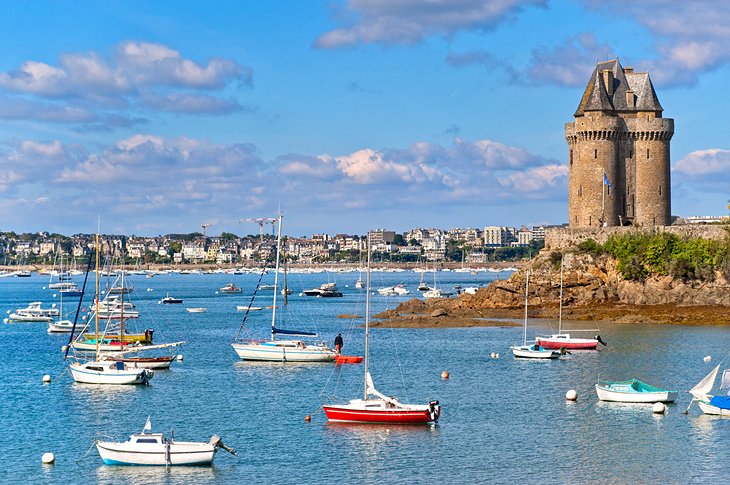
This quintessential Breton port is a former island near the mainland. Designed as a citadel, Saint-Malo boasts well-preserved medieval fortifications that lend a distinctive character to the city.
During the Second World War, the historic center ( Vieille Ville ) of Saint-Malo was largely destroyed, except for the old walls; the Château de Saint-Malo , which dates to the 14th and 15th centuries; and the Cathédrale Saint-Vincent , which was founded in the 12th century.
The town was rebuilt after WWII in its original style, with granite houses that appear ancient. The city has also retained its medieval ambience because the atmospheric old cobblestone streets have survived the centuries.
Narrow pedestrian lanes lead to bustling public squares and side streets, with many restaurants and crêperies found at every turn. Gracing the Place Chateaubriand is the Hôtel France & Chateaubriand in a neoclassical building modeled after the grand seaside resorts of the Napoléon III era. Guest rooms feature elegant minimalist decor; some look out to the coastline. Amenities include a stylish café, brasserie, and a rooftop restaurant with panoramic views.
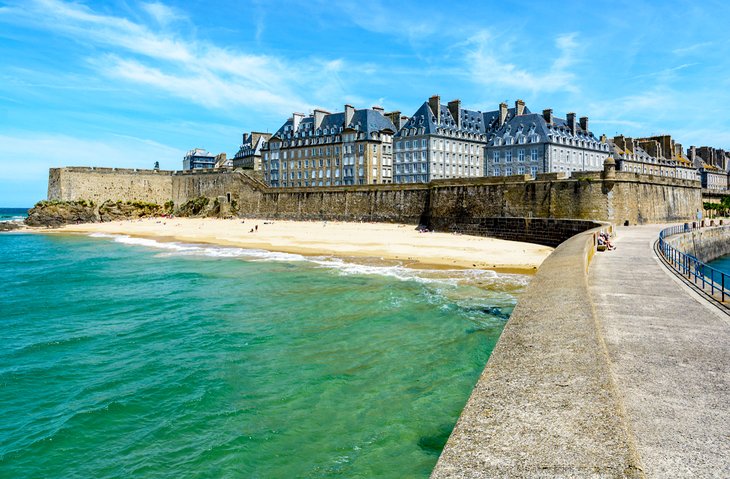
Near the Place Chateaubriand are steps leading up to the ramparts , which date back to the 12th century. A walk around the complete circuit takes about an hour. From the projecting bastions are spectacular vistas of the town, the estuary (with the town of Dinard on the opposite bank), the sea, and the offshore islands.
Below the west side of the ramparts is the Plage de Bon-Secours , a sandy beach with summertime lifeguard surveillance and fantastic facilities, including a seawater swimming pool, showers, restrooms, and a café. The beach also has a view of the Saint-Malo Bay and the town of Dinard in the distance.
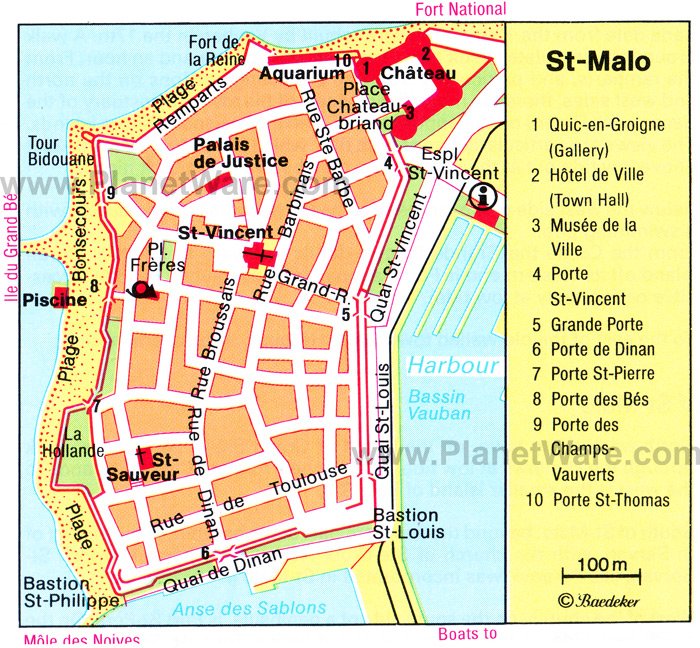
On the banks of the Odet River, Quimper is a picture-postcard historic town. Visitors are delighted by the authentic atmosphere of this Breton riverside community, with its sweet pastel-painted half-timbered houses, cobblestone streets, and pedestrian footbridges decorated with potted flowers.
In the center of the town is the Place Saint-Corentin , presided over by Quimper's awe-inspiring Cathédrale Saint-Corentin . Dating to the 13th century, the cathedral is considered Brittany's finest Gothic building. Between the cathedral's two high towers (which were completed in the 19th century), the legendary figure of King Gradion peers above the town.
Across from the cathedral, the Musée des Beaux-Arts displays a wonderful fine arts collection in an elegant neoclassical building. Highlights are the works by French, Italian, Flemish, and Dutch painters, as well as pictures by Max Jacob and the Post-Impressionist painters of Pont-Aven (l'Ecole de Pont-Aven), which included Paul Gauguin, Émile Bernard, Maurice Denis, Paul Sérusier, and Charles Filiger, among others.
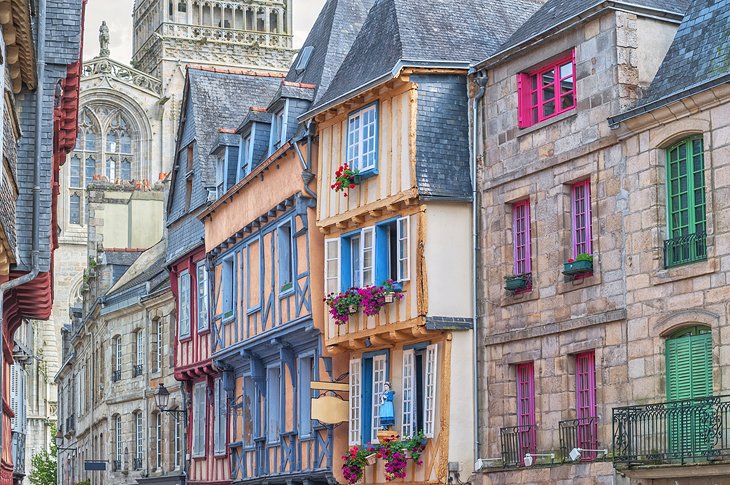
South of the cathedral, in the former Bishop's Palace, is the Musée Départemental Breton (Breton Museum) with a collection of archaeological objects, folk costumes, ceramics, and artworks, which reveal Brittany's rich cultural heritage. There is also a collection of landscape paintings that depict Brittany's Finistère region.
Quimper was the capital of the Duchy of Cornouaille during the early medieval period and now is the chief town of the département of Finistère in southwestern Brittany. One of the attractions of visiting Quimper is the surrounding countryside of Cornouaille. This stunning, rugged landscape is characterized by its rocky peninsulas and sensational sea views.
There are also many seaside resorts in the area, including Tréboul and the fishing port of Douarnenez . The Pointe du Raz is the most westerly point in Brittany and offers an amazing panoramic outlook from the tip of the promontory.
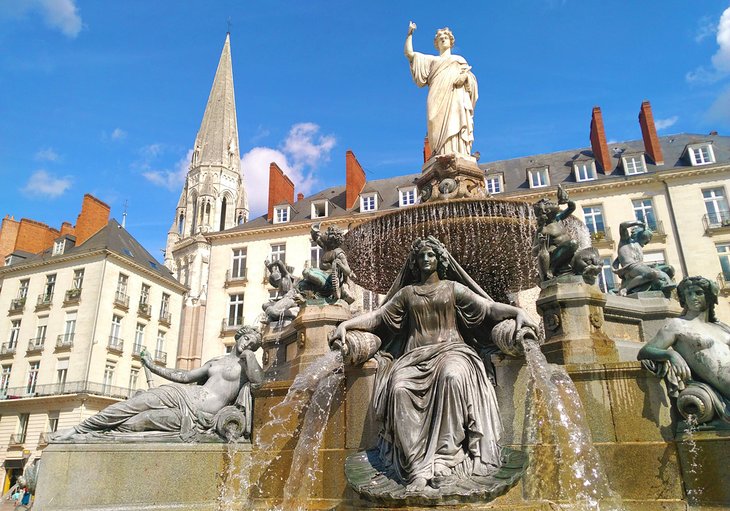
At the junction of the Erdre and Loire Rivers, the old Breton port of Nantes has played an important role in history. Nantes was the capital of the Duchy of Brittany during the Middle Ages, and it was here in 1598 that Henry IV signed the Edict of Nantes , which granted freedom of religious belief to Protestants.
Thanks to its advantageous port location, Nantes became a prosperous commercial town from the 16th to the 19th centuries. Nantes has also been a university town since the 15th century. Today, Nantes is still a thriving center of higher education, as well as France's sixth largest city.
Visitors may begin a sightseeing tour of Nantes' top attractions in the historic center at the Château des Ducs de Bretagne (Castle of the Dukes of Brittany), founded in the 15th century by Francois II, one of the last Breton rulers. Surrounded by parkland, this enormous fortress has all the essentials of a medieval castle: a moat, imposing towers, and sturdy defensive walls.
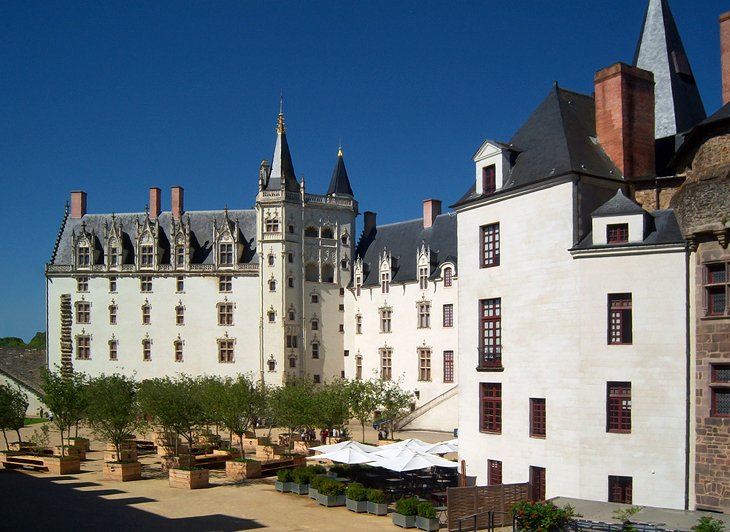
The château houses the Musee d'Histoire de Nantes (History Museum of Nantes) on display in the opulent Flamboyant Gothic reception rooms. The diverse collection includes paintings, sculptures, photographs, model ships, and scientific instruments.
The museum requires an entry fee, while the château gardens and rampart walk are open to the public for free. The Château des Ducs de Bretagne also has a crêperie restaurant, La Fraiseraie , that specializes in crêpes (both savory and sweet), as well as frozen desserts (sorbet and ice cream) made with seasonal ingredients sourced from local farms. The château's bookstore sells souvenirs, toys, special regional candies, and books about the history of the castle and the city.
After touring the Château des Ducs de Bretagne, visitors should continue west of the castle to the historic quarter of Nantes known as the Bouffay district . In this medieval quarter of half-timbered houses, tourists may wander through the maze of winding streets and shop at the enticing boutiques.
In the center of Nantes is the Place Royale , an elegant 18th-century square. Nearby (within a 10-minute walk) is the busy thoroughfare of Rue Crébillon with many shops and restaurants and the Cours Cambronne square that has a small tree-lined green space with park benches.
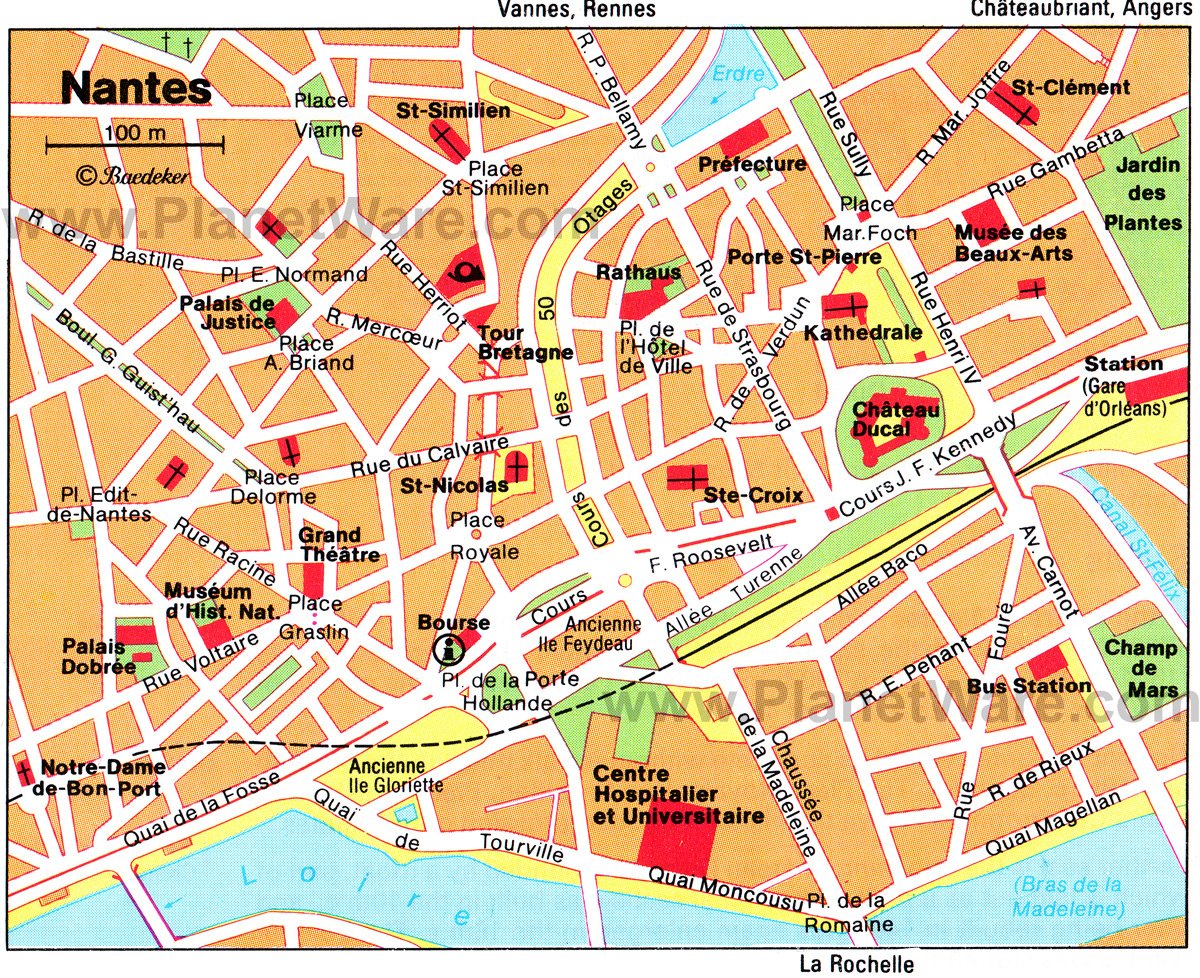
The old capital of Brittany, Rennes is still the region's economic and cultural center, as well as a university town. After a fire in 1720, much of the town had to be rebuilt, and more reconstruction was necessary after WWII. Rennes is now a modern city with streets laid out at right angles.
Visitors can begin a walking tour at the Place de la Mairie to admire the Hôtel de Ville (Town Hall), built in 1734. West of the Place de la Mairie is the Eglise Saint-Sauveur , a lovely church built from the 17th to the 18th centuries. East of the Town Hall is the Place du Parlement de Bretagne encircled by 18th-century houses.
Farther northeast, the Romanesque abbey church of Notre-Dame en Saint-Melaine dazzles visitors with its elaborately sculpted facade and ornately embellished cloister. Several blocks away is the Cathédrale Saint-Pierre with an interesting blend of architectural styles.
Tourists should also take time to stroll the narrow cobblestone lanes around the cathedral where there are perfectly preserved historic houses such as the Hôtel de Blossac at 6 Rue du Chapitre.
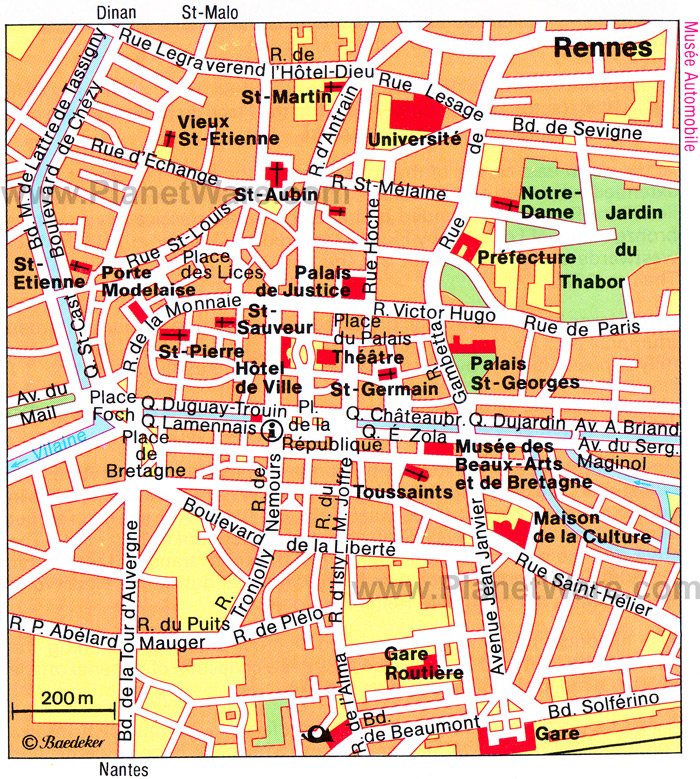
Belle-Île-en-Mer is the largest of the Breton islands but is still only 17 kilometers long and 10 kilometers wide. The island's name translates to "Beautiful Island in the Sea," fitting of its sublime natural setting on the Quiberon Bay of Brittany's southwest coast.
The main hub of activity on Belle-Île-en-Mer is Le Palais , an interesting town with many restaurants, hotels, art galleries, and artisans' workshops.
Above the harbor in Le Palais is the Citadelle Vauban , a medieval citadel that was enhanced by French military engineer Sébastien Le Prestre de Vauban in the 17th century. The site is now a Hôtel-Musée (Hotel-Museum), with the former barracks converted into upscale guest rooms, a museum focused on the history of Belle-Île-en-Mer, and a chic gourmet restaurant.
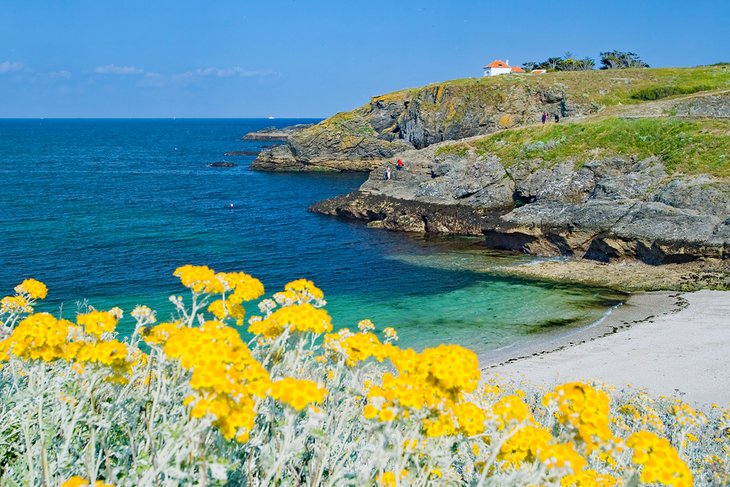
From Le Palais, there is a route running southwest across the island to the rugged Côte Sauvage (coastline). Southeast of Le Palais is the Plage des Grands Sables , the island's most beautiful beach. This sheltered beach has a fine-sand shoreline and gentle waters. It's a great place for water sports, including paddleboarding, kayaking, and sailing.
The island has three smaller villages. The village of Bangor , on the Côte Sauvage (wildest part of the island), was founded in the 6th century by British monks. Picturesque farmlands surround Locmaria , a rural township on the highest part of the island. Sauzon is a little fishing village with narrow streets and a thriving marina in its well-sheltered harbor.
To arrive at Belle-Île-en-Mer, tourists can take a 45-minute ferry boat ride (available year-round) from Quiberon. From April through October, ferries run from Port Navalo (about 50 minutes) and from Vannes (about two hours). During the high season, private taxi boats run from Quiberon to Belle-Île-en-Mer, and the ride takes about 30 minutes.
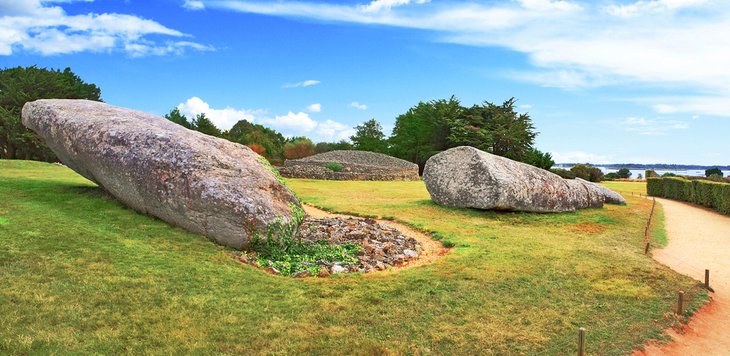
A peaceful, protected bay in southern Brittany, the Golfe du Morbihan is connected with the Atlantic Ocean only by a narrow channel. The bay is filled with numerous small islands featuring unspoiled natural scenery. The two largest islands Île aux Moines and Île d'Arz are popular summer vacation destinations (many tourists take a boat trip from Vannes).
Inhabited since prehistoric times, Morbihan is filled with fascinating megalithic sites , unique stone structures that are the most ancient found anywhere in the world (many are older than Stonehenge and the pyramids of Egypt). These monuments are evidence of a prehistoric culture of which almost nothing is known.
Locmariaquer has some of the most amazing megaliths. "Le Grand Menhir" was the largest stone monument ever erected in prehistoric Europe; this 20-meter-long, 280-ton stone structure was created around 4,500 BCE.
Also in Locmariaquer, the "Table des Marchands , " features enigmatic engravings, and the "Tumulus d'Er-Grah" is a Neolithic monument from 5,000 BCE.
On the Île de Gavrinis is a remarkable Neolithic burial site, the "Cairn de Gavrinis ," built around 4,000 BCE. The pyramid-shaped chamber is intricately decorated and covered with a grassy mound of earth. Engravings depict patterns and symbols such as swirl designs, axe heads, and horned animals. To visit the Cairn of Gavrinis, book tickets in advance.
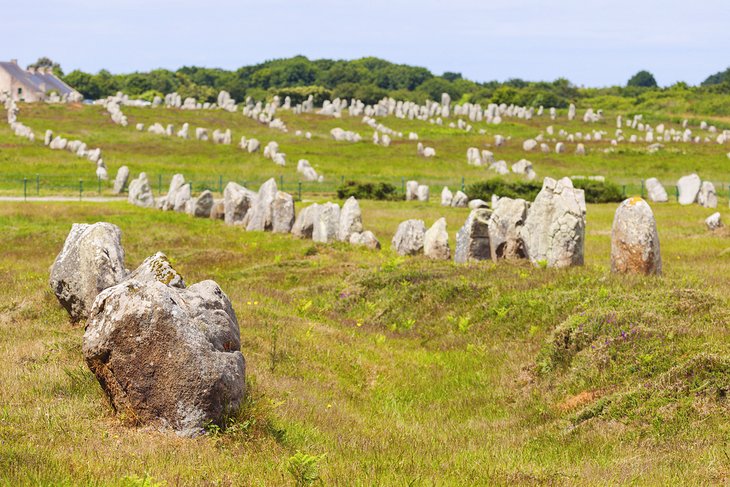
Carnac on the Quiberon Bay (near Locmariaquer), takes its name from the Celtic word "carn," meaning a stone monument. Visitors are awestruck by Carnac's Neolithic sites including the "Circuit des Alignements , " freestanding circles and rows of stones up to six meters high, and the Tumulus Saint-Michel megalithic monument topped by a small chapel.
One of Europe's best museums of prehistory is found in Carnac, the Musée de Préhistoire , which presents objects discovered at archaeological sites in the area. The collection illustrates the development of humans from 450,000 BC through the Paleolithic Period (Stone Age) and the Neolithic era, up until the Gallo-Roman epoch.
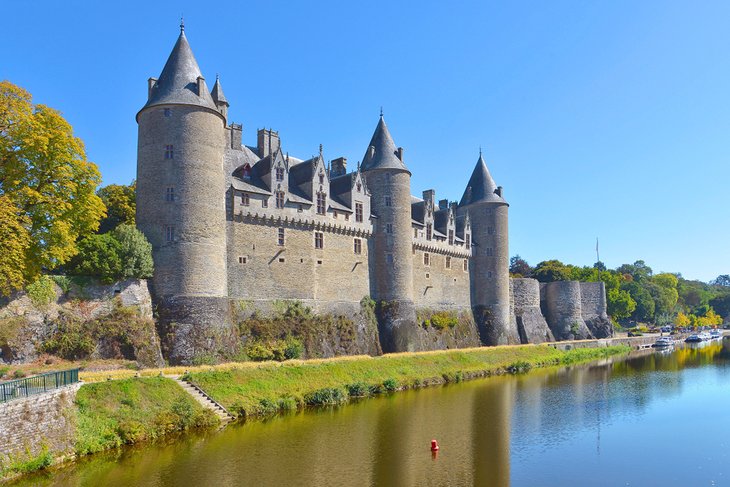
With its picturesque canals and pretty half-timbered houses, the medieval village of Josselin is a must-see tourist attraction in the Morbihan area of Brittany. Apart from the town's old-world charm, the highlight of Josselin is its medieval château, which is a perfect example of feudal architecture.
The Château de Josselin has been inhabited throughout the centuries by generations of the Rohan family. The town of Josselin takes its name from the son of the Viscount who built the château.
Presiding over the Oust River valley, this majestic castle dominates the landscape with its soaring walls and turreted towers. The austere exterior contrasts a sumptuous facade on the interior courtyard, exemplifying the Flamboyant Gothic style of the Breton Renaissance.
Tourists may take self-guided tours or guided tours of Château de Josselin to admire the lavish interior. The sitting and dining rooms feature monumental fireplaces, and the library contains more than 3,000 antique books.
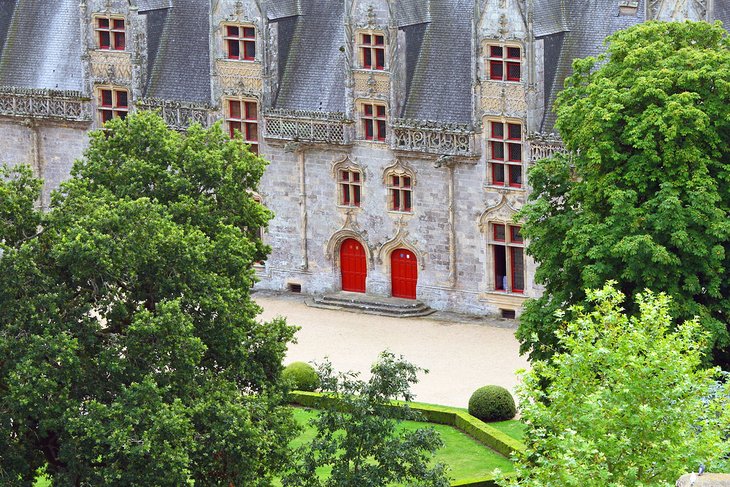
A formal French garden surrounds the château. Visitors will delight in wandering the perfectly manicured tree-lined lawns and rose garden with 40 different heirloom varieties. The grounds also include a romantic English garden full of lush flowering vegetation, with a picnic area and benches for relaxation.
The château also has a Dolls and Toys Museum , which displays dolls dating back to the 17th century. Many of the dolls are dressed in authentic Breton costumes. With nearly 5,000 items, this collection is the largest of its kind in France.
Official site: http://www.chateaudejosselin.com/en/
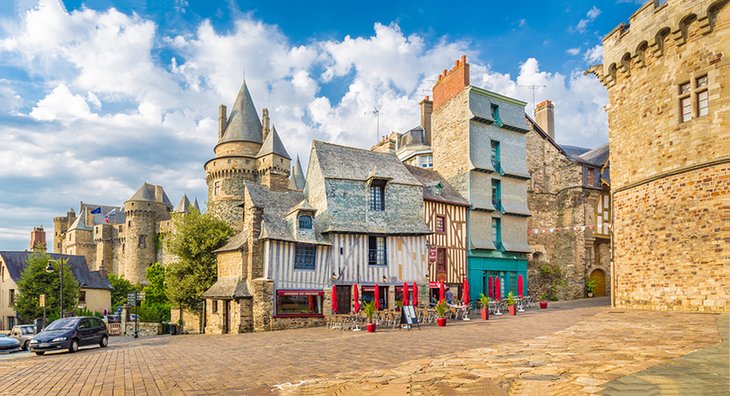
East of Rennes on the left bank of the Vilaine River, the town of Vitré has a magical old-world ambience complete with ancient town walls and towers. In 1999, Vitré was awarded France's title of " Ville d'Art et d'Histoire " ("Town of Art and History") because it is one of the few medieval towns in Europe that has remained so well intact.
Within this delightful historic town are many quaint narrow lanes and half-timbered houses. The prettiest street is Rue de la Baudrairie , once the quarter of the " baudroyeurs " (saddlers). The town's Gothic church, the Eglise Notre-Dame , was built in the 15th and 16th centuries. The interior features an intricate triptych consisting of 32 panels of Limoges enamel.
Testimony to the town's feudal past is the Château de Vitré , a fairy-tale vision crowning the spur of a rocky outcrop. Classified as a Historic Monument , the grandiose multi-towered and fortified castle was built around 1080 by the Baron of Vitré and renovated during the Middle Ages.
The Château de Vitré is open to the public and houses the Musée d'Art et d'Histoire (Museum of Art and History). The museum displays artworks dating from the 16th to the 20th centuries, along with beautiful gilded reliquaries. There's also an 18th-century apothecary's shop on view.
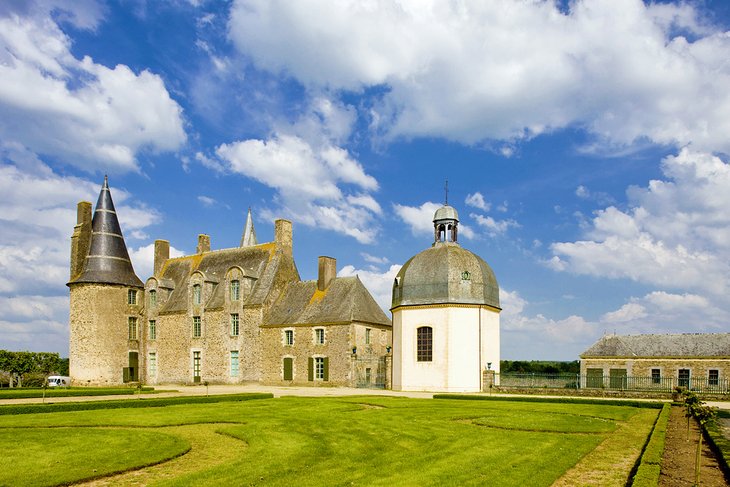
About seven kilometers southeast of Vitré is the Château des Rochers Sévigné , an elegant 15th-century Breton manor house. The château stands in an expansive parkland that includes woods with walking paths.
The celebrated letter-writer Madame de Sévigné stayed here between 1644 and 1690, during which time she wrote letters to her daughter (which are now well known in the French literary canon). In 1689, the son of Madame de Sévigné commissioned royal gardener André Le Nôtre to create the formal French gardens on the estate.
The Château des Rochers Sévigné is open to the public for guided tours ; two rooms of the castle contain a museum collection devoted to Madame de Sévigné. Visitors will see the chapel, the tower, and the garden. The museum displays portraits of family members and other items that Madame de Sévigné cherished.
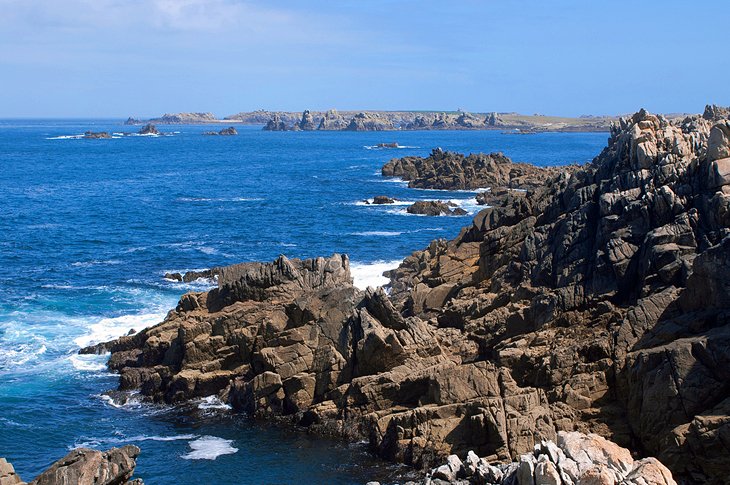
The Île d'Ouessant is a rugged island with incredible scenery, including treacherous cliffs and rocky promontories beaten by wild waves of the Atlantic Ocean. Only seven kilometers long and four kilometers across, this small island has an untouched and otherworldly feel.
Along the island's coastline is a ring of lighthouses, essential to the boats traveling by the island at nighttime. The Phare de Créac'h lighthouse on the northwest coast is passed by thousands of ships every year. This location marks the entrance to the English Channel.
Nature is the main attraction of visiting Île d'Ouessant, especially along the island's coastal paths. Île d'Ouessant is known for its indigenous sheep, and the island also has about 400 different species of birds. The best beaches are around the island's main village, Lampaul .
To arrive at Île d'Ouessant, tourists can take a ferry boat (approximately a 2.5-hour trip) from Brest or a shorter (about a one-hour) ferry ride from Le Conquet.
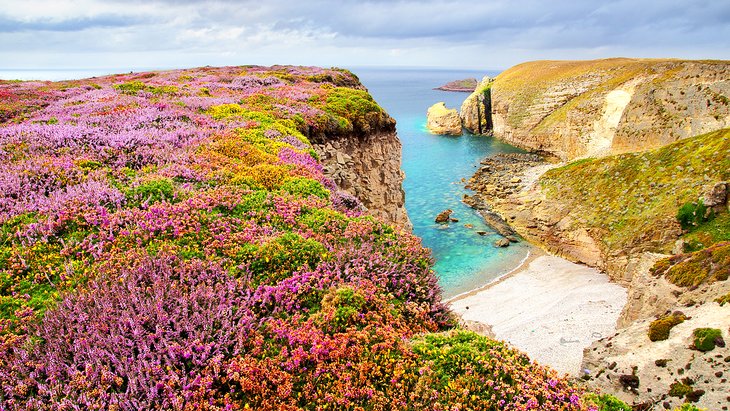
This gorgeous stretch of coastline runs along northern Brittany from Saint-Malo to Cap Fréhel. The Côte d'Emeraude includes many wonderful seaside resorts: Dinard (the most stylish), Paramé, Servan-sur-Mer, Rothéneuf, Saint-Briac-sur-Mer, Saint-Lunaire, Lancieux, Saint-Jacut-de-la-Mer, and Saint-Cast-le-Guildo, which are linked by a seaside road.
The most striking feature of the Emerald Coast is the Cap Fréhel , which reaches a height of 72 meters above the sea. This vantage point offers breathtaking panoramic views of the coast.
Inland from the coast are the towns of Dinan (a picturesque medieval town); Fougères , which boasts an impressive medieval castle; and the Château de Combourg , which was the family home of the 19th-century writer and statesman René de Chateaubriand.
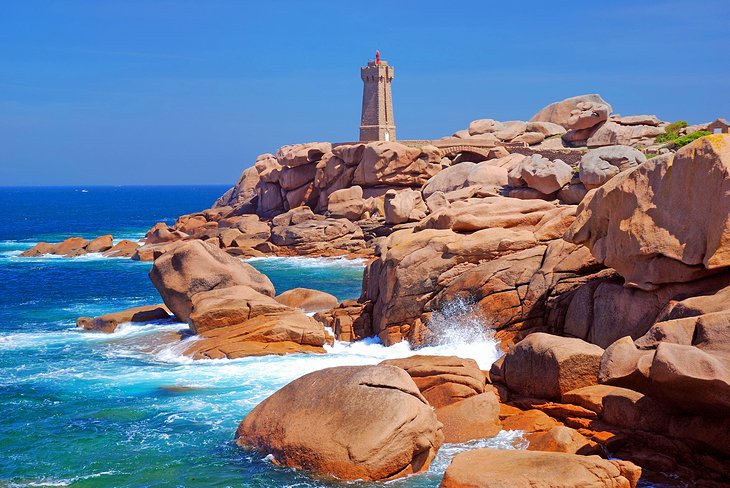
Named for the pink color of the rocky coastline, this marvelous seaside route runs between Perros-Guirec and the port of Ploumanac'h. The town of Ploumanac'h has a natural harbor that is a nice area to take a walk.
The Côte de Granit Rose is famous for its incredible rock formations, the Rochers de Ploumanac'h . These imposing weather-beaten rock structures are found between the beaches of Trestraou and Saint-Guirec. Some of the formations are as high as 20 meters, and many seem to take on the shape of recognizable figures such as a witch, Napoleon's hat, and a rabbit.
Visitors can go for a hike along the Sentier des Douaniers (The Custom Officers' Path) to admire the Ploumanac'h rocks. Beginning at the Plage de Trestraou (beach), this eight-kilometer out-and-back trail affords spectacular views of the pink granite landscape and the turquoise waters in the distance. The scenic path runs alongside the sea and traverses wild moors before reaching the yacht-filled marina of the Port of Ploumanac'h.
Tucked away on the Sentier des Douaniers is the Plage Saint-Guirec , a sheltered sandy beach where the calm waters are ideal for swimming, and the Maison du Littoral , which presents exhibits about the Ploumanac'h nature site.
For those who would like to go camping in the area, the Domaine de Trestraou offers sites for tent camping and camper vans. The Domaine de Trestraou is just a short walk from Trestraou Beach and has a water sports center, as well as a mini-golf course and tennis courts.
One of the highlights of this coastal area is Perros-Guirec , a popular seaside resort in Brittany and favorite destination among Breton families. Perros-Guirec has three sandy beaches with kids' clubs, as well as opportunities for water sports during summer.
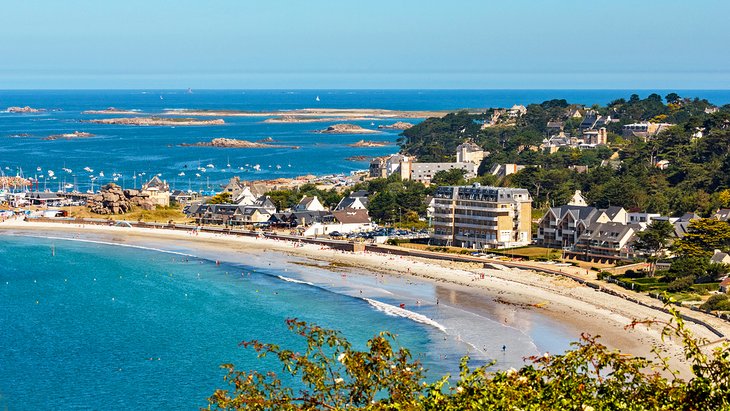
Trébeurden is another seaside resort that attracts many beach lovers in summer. The historic town of Trébeurden also delights visitors with its artisan craft shops, traditional farmers market, and gourmet restaurants. Visitors will enjoy dining at the town's crêperies, which serve the Breton specialty of buckwheat galettes, and seafood restaurants.
The Restaurant des Rochers in Trébeurden offers exceptional seafood dishes and stunning marina views. Another local restaurant, the Manoir de Lan-Kerellec , has earned a Michelin star for its superb modern cuisine.
Bird-watchers will appreciate the Pink Granite Coast because of its diverse avian life. Brittany's largest bird sanctuary lies nearby on the Sept-Îles (Seven Islands) archipelago. Regular boat trips run from Perros-Guirec and from nearby Port-Blanc to Sept-Îles.
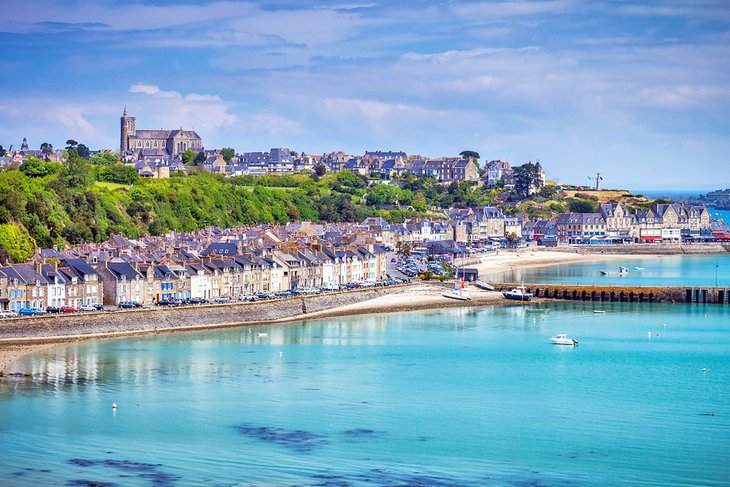
Cancale is a tiny fishing village on the Baie de Saint-Michel. The local cuisine makes use of all the fresh seafood. Some of the best restaurants are around La Houle port .
Anyone with a sweet tooth will want to try the pâtisserie boutique and tea salon, Grain de Vanille (12 Place de la Victoire), which serves artisanal pastries, ice cream, tea, coffee, and hot chocolate.
For those who would like to learn about oyster production, one of the best places to visit is the La Ferme Marine de Cancale . Located in a protected marine environment, this working oyster farm offers guided tours.
Above the port in the old town of Cancale is the 18th-century Eglise Saint-Méen , devoted to the 6th-century Welsh saint. The church houses the Musée des Arts et Traditions Populaires , with exhibits about the town's history of seafaring and fishing, as well as a collection of traditional local crafts and costumes.
Every year on August 15th , the town celebrates the Fête de l'Assomption de Marie (Festival of the Assumption of the Virgin) to pay tribute to the Virgin Mary, the protector of sailors, and to honor those who have perished while at sea. The festival's religious procession takes place through Cancale's streets, which are adorned with decorations for the occasion.
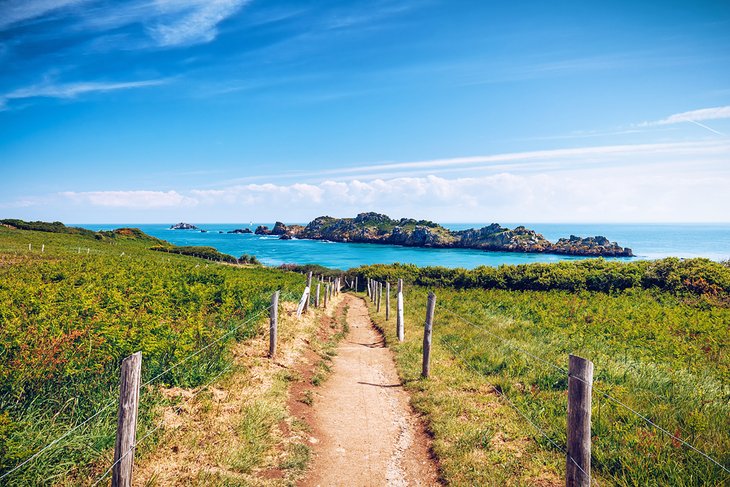
Refreshing scenic walks give visitors a chance to discover the coastline around Cancale. The Sentier des Douaniers (The Custom Officers' Path) is a hiking trail that follows the entire coastline of Brittany. The portion from Cancale to La Pointe du Grouin affords spectacular vistas of dramatic cliffs and beaches.
Cancale also has pristine sandy beaches that draw many vacationers during the summertime.
About five kilometers from Cancale overlooking the Bay of Saint-Michel, the Château Richeux is a dreamy three-star Relais & Châteaux property renowned for its fine-dining restaurant, Le Coquillage , which specializes in farm-to-table cuisine and fresh-caught local seafood. The bread served at the restaurant is handmade using organic flour and baked in a wood-fired oven. The hotel has only eleven guest rooms, all of which feature bay views.
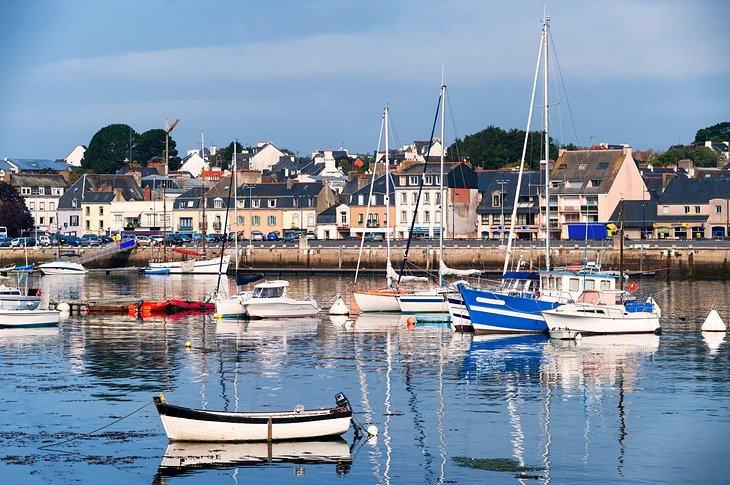
At the mouth of the Moros River, Concarneau is France's third largest fishing port. This historic fortified town is a called a " ville close " ("closed city") because it was a 14th-century stronghold entirely enclosed by sturdy granite walls and towers. The defenses were enlarged by Vauban in the 17th century.
This walled town transports visitors back in time. While ambling through ancient narrow streets past old stone buildings and houses adorned with colorful geraniums, visitors are immersed in the medieval ambience. However, Concarneau has enough to keep modern travelers happy; there are plenty of bustling restaurants and interesting shops to discover.
During summertime, Concarneau is a popular seaside destination thanks to its sandy beaches. The Plage des Sables Blancs is a family-friendly beach with a fine white-sand shoreline and rental facilities for water sports. Near the city center, the Plages de la Corniche beaches are found along the Sentiers des Douaniers hiking trail.
Another attraction in Concarneau is the Musée de la Pêche ( Fisheries Museum ), which displays exhibits related to fishing and has a documentation center with publications about maritime activities and fisheries. The museum also presents temporary artistic exhibits with a theme of fishing, sailing, or the sea.
In August, Concarneau hosts Le Festival des Filets Bleus . This traditional Breton festival gives town residents a chance to dress up in period costumes and allows tourists to learn about the local culture. The festival includes a parade, dancing, and games that are unique to the region.
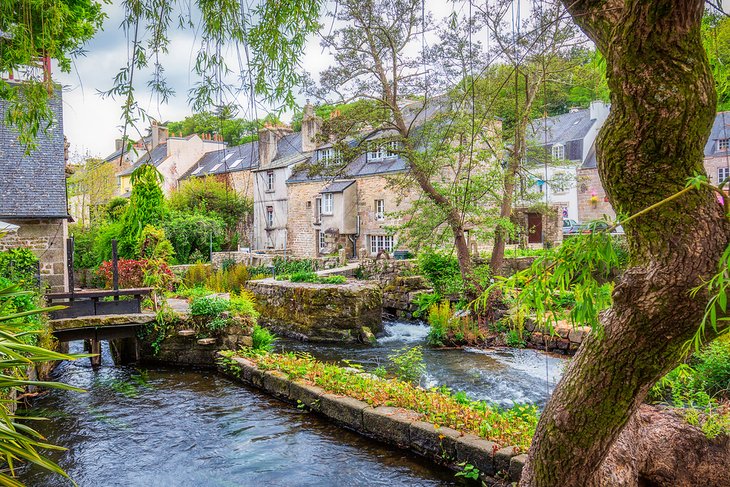
About 16 kilometers east of Concarneau, this charming artists' village takes its name from the river running through town. The riverside is lined with shady trees and old mills, a lovely backdrop for leisurely strolls.
Pont-Aven was discovered in the 1860s by American painters but is most famous for its association with post-Impressionist painter Paul Gauguin and the Pont-Aven art movement. Gauguin arrived in Pont-Aven in 1886, and along with artist Émile Bernard, created a new style of painting known as the "Ecole de Pont-Aven" (School of Pont-Aven).
The village's Musée de Pont-Aven displays many paintings by artists of the Ecole de Pont-Aven. For those who want to take in the scenes that inspired great art, a Painters' Trail map (available at the tourist office) indicates the sites in Pont-Aven and the surroundings that were captured by the School of Pont-Aven painters.
Pont-Aven is a delightful place to visit anytime of year, but is especially enjoyable in early August during the Fête des Fleurs d'Ajonc (Festival of Gorse Flowers). For this summer festival, townspeople dress up in old-fashioned regional costumes, while the streets are animated with traditional Breton dancing and bagpipe music.
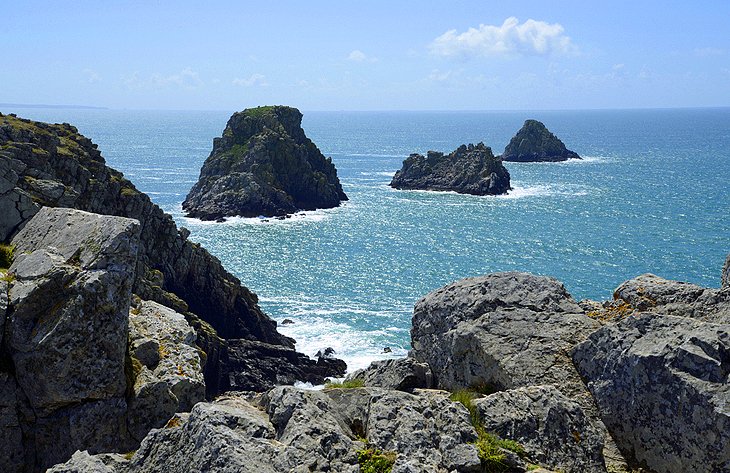
North of Cornouaille and the Pointe du Raz, the craggy Crozon Peninsula is distinguished by its rocky promontories, which offer some of the most outstanding views in Brittany. The peninsula is dotted with numerous seaside resorts including Camaret-sur-Mer, Morgat, and Roscanvel.
The most dramatic location, the Pointe de Pen-Hir rises to a height of 70 meters above the sea, boasting exceptional coastal views, particularly of the isolated crags known as the Tas de Pois. Nearby is a memorial to Bretons who fell in the Second World War.
To the north is the Pointe des Espagnols , with a view of Brest. Between the Pointe de Pen-Hir and the Cap de la Chèvre is the Pointe de Dinan , which provides a stunning view of the monumental rock known as the "Château."
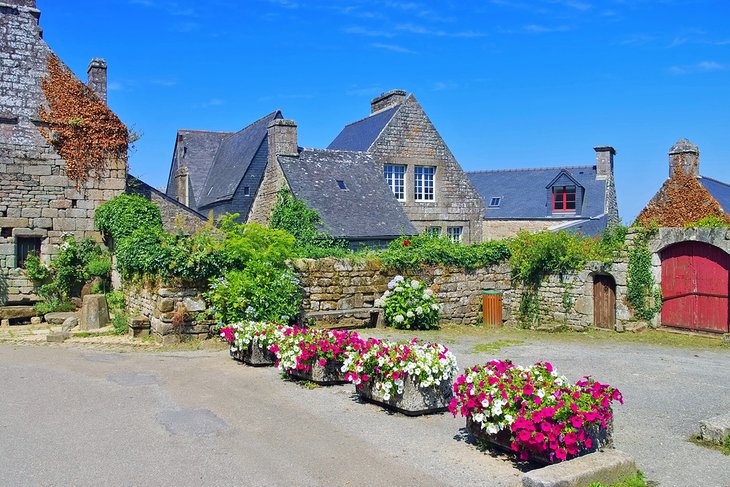
In Brittany's picturesque Finistère region, Locronan is one of the most charming towns in Europe . The town is listed as one of the " Plus Beaux Villages de France " (Most Beautiful Villages in France) and " Petite Cité de Caractère " (Small City of Character) because of its magnificent 15th-century church and grand Renaissance houses.
Locronan is a destination for a special type of Breton pardons (pilgrimage festivals) called a " troménie. " The Grande Troménie pardon is held here in July every six years. Similar to a pilgrimage, the Grande Troménie is a 12-kilometer religious procession during which thousands of believers participate in walking prayer. A smaller troménie is held every year.
Near Locronan, just eight kilometers away, is another pilgrimage destination, the Chapelle Sainte-Anne-la-Palud . The chapel boasts a painted granite statue in veneration of Saint Anne, who was executed in 1548.
Just outside the village of Sainte-Anne-la-Palud is a well-sheltered sandy beach known for its breathtaking sunsets.
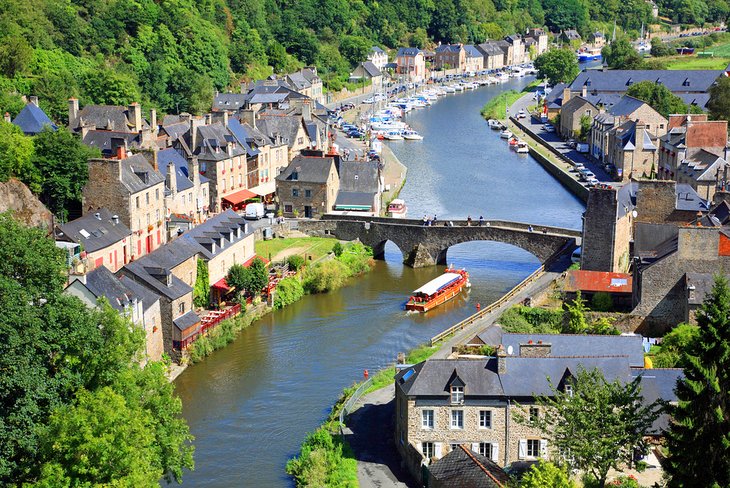
Perched on a hill above the Rance River's left bank (between Dinard and Saint-Malo), Dinan is one of the prettiest towns in Brittany. Still surrounded by its old walls, Dinan's old town boasts handsome late-medieval to Early Renaissance houses (particularly on the Rue du Jerzual) and the monumental 14th-century Château de Dinan (Palais des Ducs de Bretagne).
The château, with its 14th-century dungeon, impenetrable 15th-century fortifications, and imposing towers, recalls the austereness of the Middle Ages. For a glimpse of the medieval era, the château hosts Les Soirées , evening events in which actors in historical costumes bring to life the world of Jean IV, the Duke of Brittany, his knights, and his servants.
Another must-see attraction in Dinan is the Basilique Saint-Sauveur , a church built between the 12th and 16th centuries, which gracefully blends various architectural styles.
An interesting excursion from Dinan is the boat trip down the Rance River to Dinard or Saint-Malo.
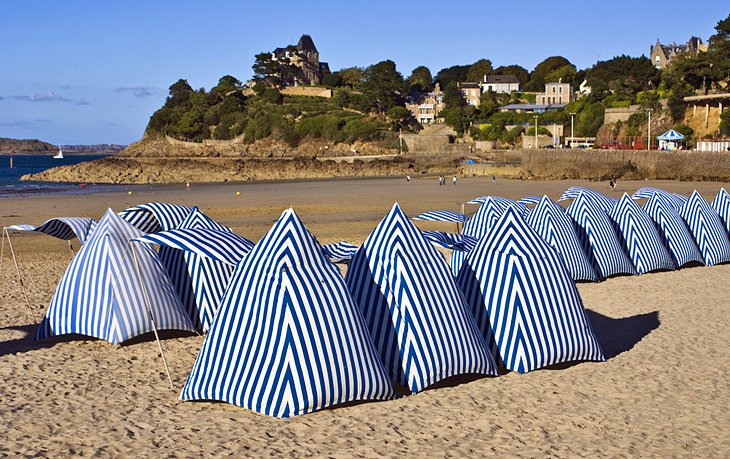
Dinard enjoys a splendid natural setting (across from Saint-Malo) along the Rance estuary. Mimosas and camellias flourish here under the influence of the Gulf Stream.
An old fishing village that was transformed into a prestigious seaside resort in the 19th century, Dinard retains its nostalgic charm. Elegant seaside villas; colorful striped beach huts; and a recently renovated historic waterfront hotel, the opulent Grand Hôtel Barrière , reveal the town's Belle Epoque heritage.
Today, Dinard is still considered one of the best beach destinations in France . Dinard has four beaches, which are all supervised by lifeguards during the high season (July and August).
Just north of the old town is the Plage de l'Ecluse, also called the Grande Plage ("Large Beach"), an expansive beach with a fine sand shoreline, and the Plage de Saint-Enogat in the Quarter Saint-Enogat, a good place for water sports; both of these beaches have lounge chairs and cabanas for rent.
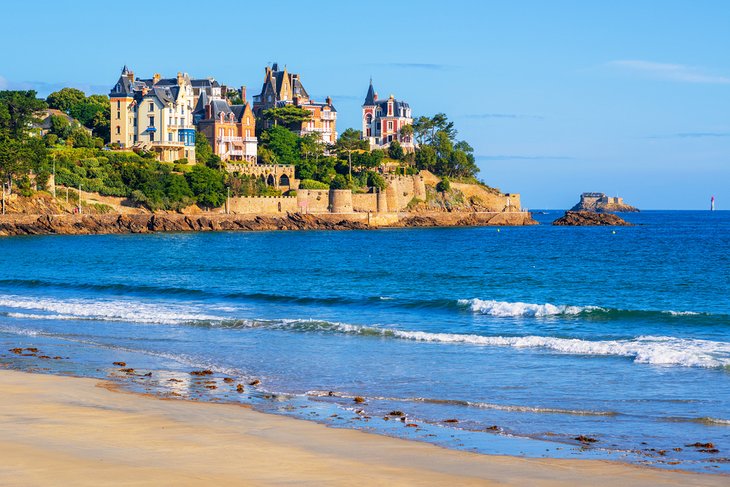
Steps away from the Plage de l'Ecluse , the artisanal ice-cream shop, Vent de Vanille (3 Bis Boulevard du Président Wilson), sells ice cream prepared from organic local milk and sorbet made with seasonal fresh fruit. Vent de Vanille also specializes in mille-feuilles , a crispy layered puff pastry dessert with creamy fillings.
Near a public camp site, the Plage du Port-Blanc offers wild natural scenery and opportunities for water sports such as sailing, canoeing, and windsurfing. Tucked away in a sheltered bay, the Plage due Prieré across from the Port Breton park features beautiful scenery and coastal paths.
One of the most enjoyable things to do in Dinard is take a leisurely walk by the sea or along the palm-fringed waterfront Promenade du Clair de Lune (Moonlight Promenade), which overlooks the Baie de Prieré. The promenade is illuminated in the evenings during July and August.
Besides the beach, Dinard also has gourmet restaurants and many cultural offerings. At the end of September through early October, the town hosts the Festival du Film Britannique (British Film Festival), with a week of film screenings at various cinema venues throughout the town.
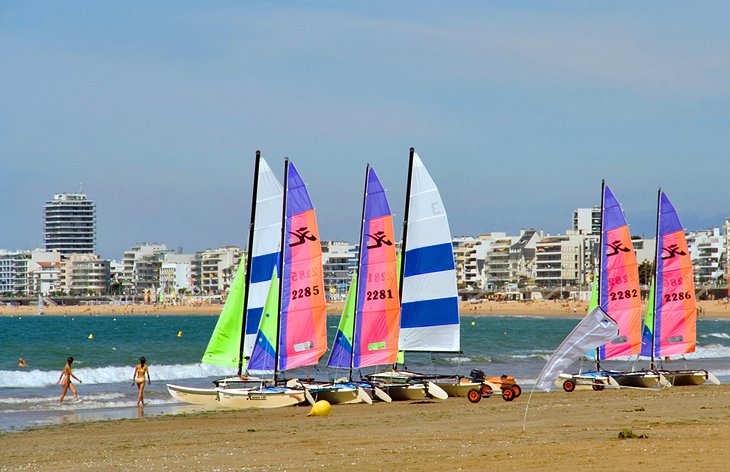
La Baule is one of France's top Atlantic Coast beach destinations, with a more modern feel than Brittany's 19th-century seaside resorts. Hugging a bay on the estuary of the Loire River between Nantes and Belle-Île island, La Baule has several miles of sandy beaches and a seafront boulevard lined with large hotels, which are packed during the high season.
Apart from sunbathing and swimming, the area is popular for sailing and windsurfing. Near La Baule is the smaller seaside resort of La Baule-les-Pins , and to the east is the Parc des Dryades botanical garden.
About six kilometers away from La Baule is Guérande , a walled medieval town that is best known for its salt marshes. Local artisans harvest the salt by hand, and it is sold all over the world.
In Batz-sur-Mer (eight kilometers from Guérande), the Musée des Marais Salants (Museum of the Salt Marshes) explains the history and techniques of harvesting sea salt.
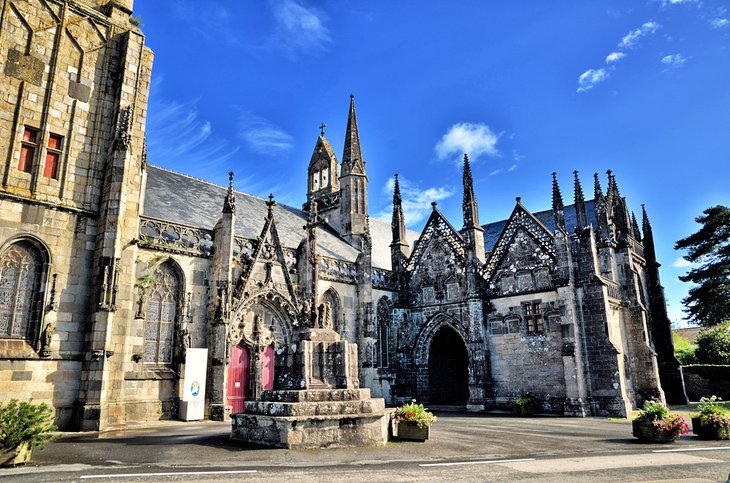
The medieval village of Le Folgoët is worth visiting to admire the Basilique Notre-Dame du Folgoët , a pilgrimage church that dates to the 14th century and still is an important spiritual destination.
Every day, many visitors come to pay tribute to the Notre-Dame de le Folgoët statue and to say prayers in front of the Virgin Mary.
The church features an exquisite Flamboyant Gothic style and an ornate north tower, which is considered one of the finest in Brittany.
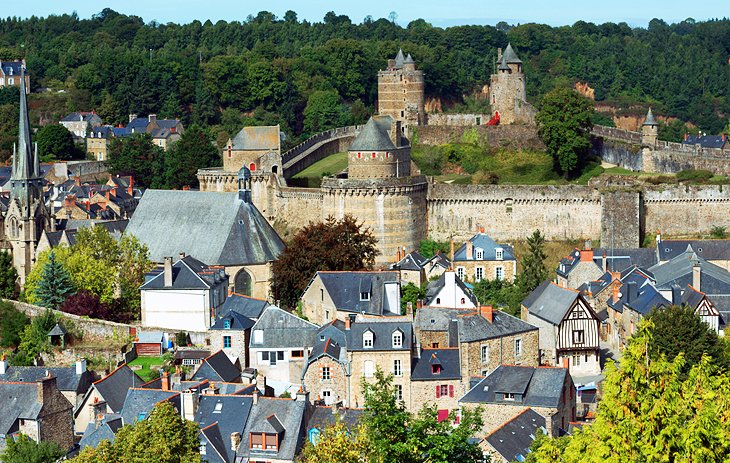
The Château de Fougères presides over the charming town of Fougères (50 kilometers northeast of Rennes), nestled in a tranquil landscape of forests and agricultural land. With the appearance of a fairy-tale castle, this formidable château has 13 towers around a circuit of fortifications.
The château was built between the 12th and 15th centuries, representing a period of feudal life in France during the Middle Ages. To immerse visitors in the historical ambience, the Château de Fougères presents spectacles that bring the medieval era to life. On Thursday evenings during summertime, the château stays open late and is illuminated by torchlight, and special events such as medieval games and festivals are held at the château on occasion throughout the year.
The medieval atmosphere continues in the walled old town , an enchanting, enclosed world of quaint half-timbered houses (with lovely examples around the Place du Marchix ). There are also lively outdoor cafés and restaurants that appeal to modern-day tourists.
Other historic attractions in Fougères include the Eglise Saint-Sulpice , featuring a Flamboyant Gothic interior, and the Hôtel de Ville (Town Hall), which dates from the 14th century.
In a characteristic half-timbered house next to the Town Hall is the Musée Emmanuel de la Villéon , which displays the work of the Impressionist painter who was born in Fougères.
The town of Fougères also boasts a unique museum, the Musée des Métiers de la Chaussure (Shoe Museum) housed in a century-old shoe factory.
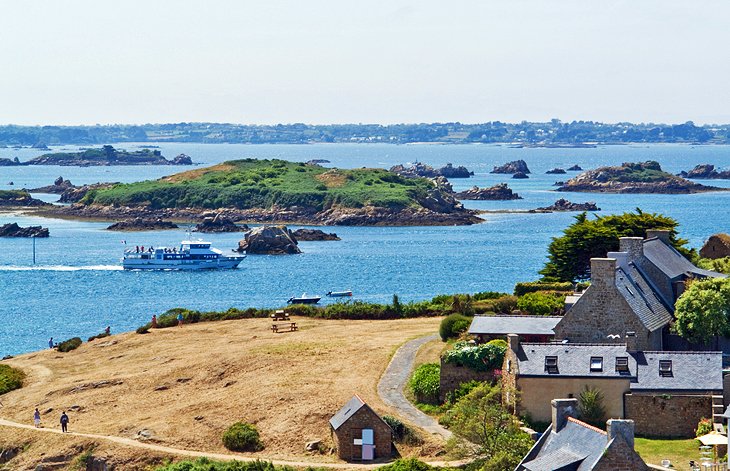
The Île de Bréhat is a tiny island, only three-and-a-half kilometers long. Completely free of cars, this idyllic island is appreciated for its temperate climate and beautiful natural scenery, including many wildflowers and striking red granite cliffs.
The main hub of activity is the village of Le Bourg , which has many cafés, restaurants, and hotels.
To arrive at the Île de Bréhat, visitors may take a ferry boat from the Pointe de l'Arcouest in Ploubazlanec. Ferries run regularly from Paimpol, and the journey takes only 10 minutes.
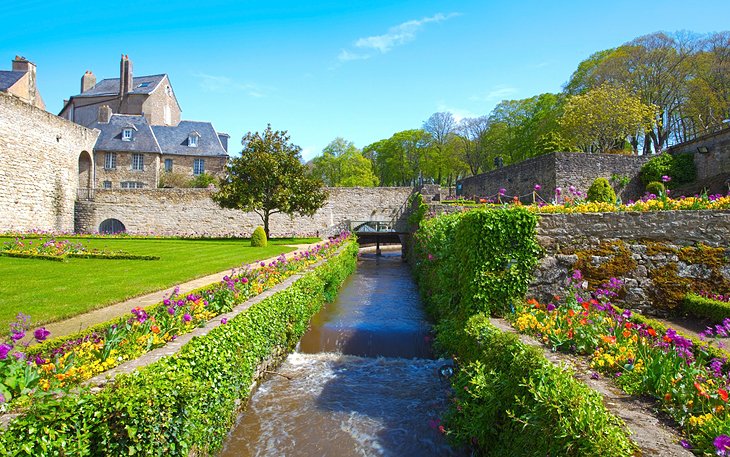
On the Gulf of Morbihan, the historic town of Vannes is halfway between Nantes and Brest. The old town grew up within the ancient walls and around the Cathédrale Saint-Pierre . Dating back to the 13th century, the cathedral has an Italian Renaissance-style rotunda-shaped chapel, which contains exceptional 17th-century tapestries and a valuable treasury.
From the Promenade de la Garenne , there is a fabulous view of the cathedral and the Tour du Connétable, a tower built in the 14th and 15th centuries.
The 15th-century Château Gaillard now houses the Musée d'Histoire et d'Archéologie, a museum focused on the heritage of Vannes, with a collection of archaeological finds, paintings, and objects d'art.
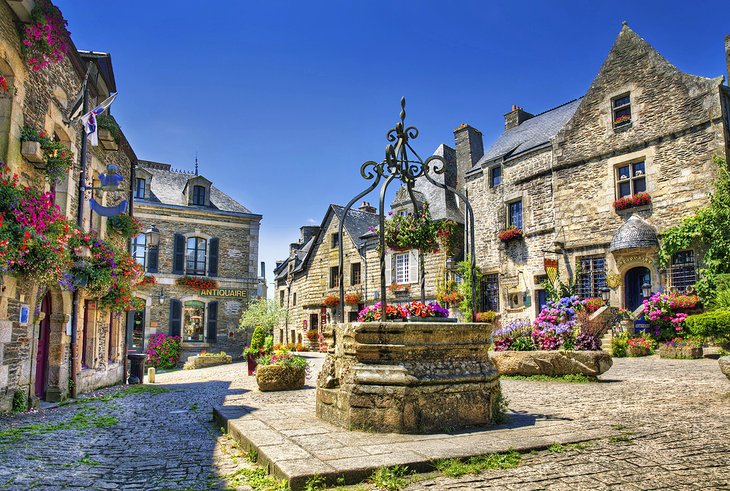
The village of Rochefort-en-Terre (35 kilometers away from Vannes) is listed as one of France's "Plus Beaux Villages" (Most Beautiful Villages) as well as a "Village Fleuris" ("Flowering Village") because of the vibrant flowers that decorate the town.
Tourists should take time to wander around the village through the atmospheric, narrow streets. There are many artists' ateliers , as well as attractive half-timbered and old stone houses featuring window sills bursting with bright geraniums. Potted flowers also adorn the squares and hidden corners of the town.
Surrounded by a tree-shaded parkland, the Château de Rochefort-en-Terre has all the elements of a medieval castle. However, it's actually a 17th-century horse stables that was updated in the 20th century. (The ruins of the original château are found on the grounds.)
In 1907, the Château de Rochefort-en-Terre was purchased by Alfred Klotz, the American painter who invested a fortune to renovate the building. Visitors can admire the exterior of the château while wandering through the park. The interior of the castle is not open for visits.
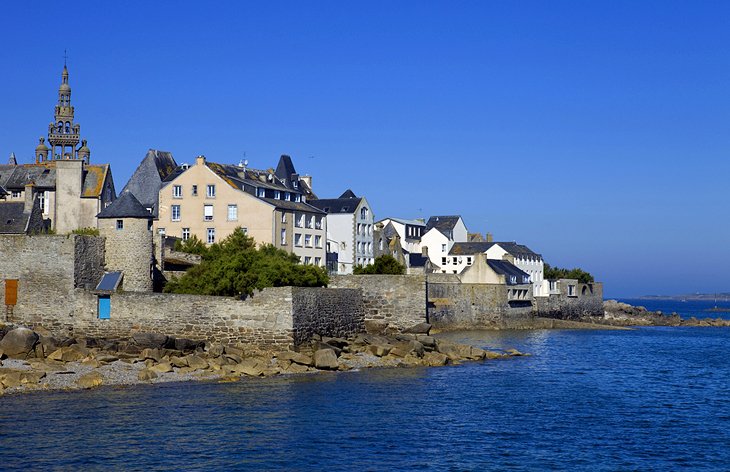
Roscoff has the most typically British character of Brittany's ports. Located on a scenic peninsula, the village delights visitors with its lovely harbor, historic shipowners' houses, and an exquisitely decorated Gothic church.
Just three kilometers off the coast from Roscoff is the Île de Batz, a tiny Breton island with a mild climate and serene environment, perfect for relaxation.
Visitors will enjoy the picturesque seaside scenery, sandy beaches, and lush exotic garden on the Île de Batz. During the summertime, ferries run regularly from Roscoff to the Île de Batz.

More on France


20 Most Beautiful Towns In Off the Beaten Path Brittany
Planning a trip to Brittany France?
Here’s my guide to the most beautiful towns in Brittany, a dramatic and wild region of northwest France. Brittany is deliciously varied. There’s spectacular scenery — heathland, marshes, a jagged coastline, stunning sand beaches, and azure waves.
Brittany is also just filled with secret medieval towns and villages where you can disappear down a cobbled lane into history.
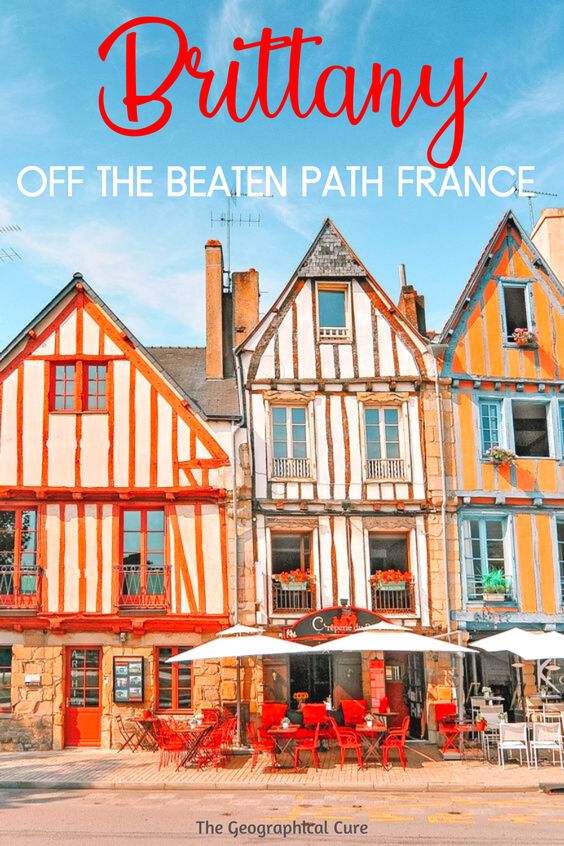
If you’ve been in Paris or just want to get off the beaten path and explore secret areas of France , Brittany makes the perfect escape.
In Brittany, the Breton language is still proudly spoken. It’s actually closer to Welsh than to French. The further west you go, the wilder Brittany gets. If you want sun, be sure to visit between March and October.
And don’t forget to sample the crepes. Crepes are to Bretons what pasta is to Italians.
20 Beautiful Towns in Brittany France
Brittany is divided into four departments: Finistere in the west, Cotes-d’Armor in the north, Ille-et-Vilaine int northeast, and Morbihan in the south. Let’s take a tour of the most beautiful villages in all four areas.
Daoulas is a beautiful town in Brittany that’s Shakespeare famous. Shakespeare’s father lived in Daoulas. He was a cloth merchant who exported precious fabrics to London. Daolus is even mentioned in Henry IV, Part I.
If, like me you’re a ruin luster, Daoulas is famed for the early Gothic ruins of an ancient Augustinian abbey.
The abbey was founded in 500 AD on the banks of the river. The cloister is a unique example of a 12th century Romanesque cloister. Today, it’s a cultural center.
2. Locronan
Locronan is one of Brittany’s plus beaux villages and also designated as a “little City of Character.” It was a rich merchant village in the middle ages.
So picturesque are its streets that Locronan has been the filming location for several historical films, including Roman Polanski’s Tess .
The centerpiece is the Grand Place of Locronan. It’s graced with gorgeous buildings, dating from the 16th to the 18th centuries — granite homes, slate roofs, and fetching shutters.
Don’t miss the 15th century Church of Saint-Ronan. The chief feature is its belfry, which lost its spire in a lightening storm. Another lovely building is the Notre Dame Chapel of Bone-Nousbelle.
3. Rochefort-en-Terre
Rochefort-en-Terre is one of France’s les plus beaux villages and a must see village in Brittany. It was voted “France’s favorite village” in 2016.
It’s difficult to imagine a more beautiful and well-manicured French hamlet. Rochefort-en-Terre is fairytale-perfect and almost mind blowing, a sensation I had upon glimpsing the beautiful Rothenburg ob der Tauber on Germany’s Romantic Road .
Rochefort-en-Terre is an architectural dream, beautifully sited on a hilltop overlooking the Valley of Arz. It’s a town where rich merchants built lavishly decorated chateaus. Most date from the 17th century.
The mansions run from the Rue de Porche to the Place du Puits. They’re made of granite and half timbers and adorned with corbelled turrets, sculptures, and wood carvings.
As you stroll, inspect the Notre Dame de la Tronchaye church, which dates from the 16th and 17th centuries. It’s famed for a statue of the Virgin Mary, which was discovered by a shepherdess in a tree trunk.
The most swoonful place in Rochefort-en-Terre is the Place du Puits. It’s the perfect intimate village setting with stone buildings, hanging iron signs, a fountain, and flower boxes on every facade.
Pop into L’Art Gourmand for delicious chocolatey things. If hunger calls, try Le Café Breton, boasting original medieval decor. There are plenty of crepes and waffles to be had as well.
4. Josselin
The town of Josselin sits on the Nantes-Brest canal. Its fortress, Chateau Josselin, was ravaged over the years, including by Cardinal Richelieu. But three round towers with conical roofs still remain. The fortress was restored in the 1860s.
Josselin is a seductive medieval ensemble. It’s home to medieval half timbered houses, the flamboyant gothic Basilica Notre-Dame du Roncier, and a lively Saturday market.
Climb to the top of the bell tower of the basilica for panoramic views over the town and surrounding area.
The basilica is Josselin’s finest building after the fortress. There’s a cardinal’s coat of arms carved on the doorway. The pulpit is an 18th century wrought iron masterpiece.
5. Locmariaquer
Lochmariaquer means a “place consecrated to Mary.” It’s a resort town, offering promontory views of the Morbihan coast. Beautiful homes line the seductive Rue Lafayette.
Aside from being a pretty village, Lochmariquer is a Stone Age paradise for history buffs and ruin lusters. It’s the site of the most renowned Breton menhirs or standing stones, dating from between 3500 and 1800 B.C.
The stones (or burial chambers) were aligned, in part, to reflect the movement of the sun and moon. One dolmen, Mane Rethual, can be entered along a cover tunnel. The Gran-Menhir is a single piece of granite, 280 tons.
6. Paimpont
Paimpont is a village of lakes and chateaus. It’s reputedly the birthplace of the Lady of the Lake, from the Arthurian legends, who resurrected Lancelot. The Paimpont Chateau houses a museum devoted to Arthurian lore.
Surrounded by an ancient forest, Paimpont is the perfect stepping off point to explore the legendary forest of Brocéliande, which was supposedly home to King Arthur and the wizard Merlin.
Many trails lead from the town into the forest.
For those more interested in historical sites, the town’s ancient abbey dates from 1199. It was built on the sacred site of a 17th century monastery and has a stunning lakeside location.
7. Ploumanac’h
Ploumanac’h is one of the most beautiful towns in Brittany. It’s located on spectacular “pink granite coast,” halfway along the northern coast.
It’s essentially a glittering secret seaside. Ploumanac’h’s ruddy pink granite rock formations create an utterly surreal coastline. The town’s active edge of the world lighthouse stands guard.
Befitting a coastal town, Ploumanac’h contains both a beach area (Ploumanac’h-Plage), and an inland village (Ploumanac’h-Bourg). “Plou” means parish and “manac’h” means monk.
The most popular footpath in Ploumanac’h starts from the main beach area and undulates along the Sentier des Douaniers for three miles. Enjoy the soft dreamy granite and unusual vistas.
8. Fougeres
Tiny little Fougere is a delightful medieval village, only 40 minutes from Brittany’s chief city, Rennes. Fougeres is a must see for its fairytale-like chateau, the Chateau de Fougeres. The cutest spot in Fougeres is the Place du Marchix with its half timbered mansions and gardens.
For a delightful stroll through town, start at the parking lot near the chateau. Walk through Porte Sainte, the only remaining gate to the walled city. The chateau is on your left.
The chateau is more than 1000 years old. It has 13 towers connected by ramparts.
After circling the ramparts, head to the medieval quarter to visit Saint-Leonard church. There’s also a hilltop garden, the Jardin Public, next door. From the Church of Saint-Leonard you have the best view of the chateau.
The medieval town of Vannes is one of the best places to visit in the Morbihan (southern) region of Brittany. Vannes is an ancient town famous for its iconic cobbled lanes, narrow streets, and walled fortifications.
As you stroll, enjoy the phenomenal art and architecture. Visit the magnificent Saint-Pierre Cathedral, the Hotel de Ville de Vannes, the Musée des Beaux-Arts de Vannes, and Henry IV Square.
Vannes is also known locally for its great foodie scene — especially crepes, local cider, and seafood. If you need a meal in Vannes, you’re in luck. Vannes is home to several Michelen starred restaurants, including Le Pressoir.
10. Roscoff
Roscoff is a charming seaside town located in the Finistère region on the northern coast. It’s officially designated a “ town of character.” You can explore the harbor, beaches, and the attractive architecture.
Roscoff is filled with 16th and 17th century buildings. The main sites are its 16th century church and botanical gardens.
Other highlights of this pretty Breton town include the historic botanical garden of Georges Delaselle Garden and the heritage museum of Maison des Johnnies et de l’Oignon de Roscoff.
Carnac is a small, charming town on Brittany’s southern coastline. Carnac’s claim to fame is its Neolithic stones, the Carnac Stones. They are the world’s largest and densest collection of Neolithic monuments, with almost 3000 stones.
If you are a ruin luster, Carnac is a mandatory stop in Brittany. Erected by the pre-Celtic people, the stones may date to as early as 4500 BC. They consist of single standing stones called menhirs and multi-cluster stones called dolmens.
Their actual purpose remains mysterious. Various theories claim they were used for ceremonies, burial sites, and even astrological purposes.
The town of Carnac itself is divided into Carnac-Ville and Carnac-Plages (beaches). At the town center is the 17th century church, St. Cornely, and the Museum of Prehistory. Carnac-Plages is an seaside resort on Quiberon Bay, with fine sandy beaches and plenty of shops and restaurants.
12. Saint-Malo
Saint-Malo is a charming walled town, thrust out into the sea and straight out of the history books. Founded in the 1st century, Saint Malo became a prominent Roman fortified site.
In the 17th and 18th centuries, it was a famous port used by trade ships and pirates alike. Saint Malo starred in the wonderful and evocative book All the Light We Cannot See , winner of the 2015 Pulitzer Prize.
The best things to do in Saint Malo are to wander along the town’s 12th century ramparts (a rewarding 1 mile romp), which encircle the town, and explore the ancient churches. Though seriously damaged in WWII, Saint Malo was restored to perfection. To see it all, you may want to book a guided walking tour .
Saint Malo Cathedral also dates from the 12th century. It has some beautiful stained glass windows.
But strolling the cobbled streets is the main attraction. Discover Maison Hussaye, the oldest house in the city with a cute turret. After a stroll, head to the beach and relax.
13. Quimper
The postcard perfect town of Quimper is one of Brittany’s most beautiful and oldest towns, located along the Odet River. Originally settled during Roman times, Quimper is the Celtic capital of the region. It’s all Gothic architecture, footbridges, and ancient cobbled lanes.
Quimper’s most famous landmark is the Cathedral of St. Corentin, built between the 12th and 18th centuries.
If you’re an art lover, you can wile away a couple hours in the Musee des Beaux-Arts or Quimper’s Pottery Museum. Quimper had an economic boom in the 17th century thanks to its pottery trade.
If you’re a fan of the BBC’s Poldark series, you may remember that Quimper is where Ross Poldark makes a daring rescue of Dwight Enes from prison. The episode (Season 3, Episode 5) was filmed onsite at the former convent turned prison in real life in 1790.
Auray has all the components of a quaint, easy on the eyes town.
Located in the port of Saint-Goustan, Auray is fill with historic half-timbered and stone houses. It’s is a lovely place with chic restaurants, tony cafes, and arty boutiques.
Auray dates back to the 1600s and 1700s, when the port was a major trading hub and source of international sales. The town even welcomed Benjamin Franklin in 1776 when he sought French assistance in the Revolutionary War.
15. Saint-Suliac
Saint-Suliac is another of Brittany’s plus beaux villages. It’s a charming tiny fishing village, located between Saint-Malo and Dinan.
Its pretty granite houses, dating from the 14th and 15th centuries, are adorned with flowers, painted shutters, and fishing nets.
There’s not much to do besides enjoy the swoonful scenery. There’s an attractive 13th century church, one of Brittany’s oldest. You’ll want to photograph every nook and cranny.
If you promenade down the Rue des Besnieres, you’ll come to a statue of the Virgin of Grainfollet, which was thought to protect the villagers from the likes of cholera.
16. Moncontour
Beautiful Moncontour is another of France’s “les plus beaux” villages. It’s a medieval walled town perched on a hill at the confluence of two rivers.
Based on its location, Moncontour was a strategically important medieval village. Richelieu battered the town in the French Revolution. But its doughty fortress still remains.
The old town of Moncontour is incredibly charming. Its half timbered houses date from the 17th century, when Montocour was a wealthy trader in hemp and linen. The most delightful ones are on the Rue des Dames, Rue du Docteur Sagory, and the Place du Martray.
Moncontour also has a 16th century parish church with a belfry, Saint-Mathurin. It boasts superb stained glass windows, which ornament the choir and the nave.
Hanging on the side of a cliff, Dinan is one of the most famous and magical villages in Brittany. In all of France really.
If you only have time for one stop in Brittany, make it Dinan. It’s an impeccably preserved ancient city that escaped the bombing of WWII.
Dinan is a walled village with hefty ramparts, cobbled lanes, and half timbers everywhere. Dinan has barely changed since the middle ages. What could be more romantic?
The best thing to do in Dinan is to simply savor its old world charm. Wander the port, walk the ancient medieval walls (1.8 miles), admire the 14th century Chateau de Dinan, and visit St. Sauveur Basilica.
The basilica dates from the 12th century. It’s a charming blend of Romanesque and Gothic architecture. It has striking modern stained glass in a well lit nave.
But Dinan’s absolute must see site isn’t really a site at all. It’s a street, the Rue du Jerzual.
It’s the pedestrianized main street that winds through the town down to the port. Along the way, you’ll pass half timbers with wisteria covered facades, art galleries, and shops.
Vitre is a beguiling medieval town with a fairytale castle. It boasts Brittany’s characteristic half-timbered houses, stones cottages, and quaint cobbled streets.
The spiky castle is called the Chateau de Vitre. You can take a self guided tour. One tower is 6 levels high, affording great views. The fortified castle is small, but authentically foreboding.
The infamous Madame de Sévigné is Vitre’s most famous former resident. She was a novelist who fell in love with the chateau-castle and visited frequently.
Her private letters to her daughter — sparkling with wit, intelligence, and gossip — are considered one of the great works of 17th century literature.
19. Mont Saint-Michel
Mont Saint-Michel is one of France’s most visited landmarks, dedicated to the Archangel St. Michael. It’s a breathtaking Gothic fortress-style island commune rising dramatically from the bay.
Both the rock top abbey and the cobbled alleys will leave you in a medieval state of mind.
The star attraction is the Abbey of Mont Saint-Michel and its lovely cloister. It was settled in 996 by Bendictine monks. For 1,200 years, it’s been a Christian pilgrimage site. The abbey is a mix of architectural styles, with religious and military overtones.
After the French Revolution, when France was de-Christianized, the abbey became a prison. It was closed in 1863. In 1979, Mont St. Michel was declared a UNESCO site.
Here’s my complete guide to visiting Mont Saint-Michel . Click here to pre-book a skip the line ticket.
You can visit on a full day guided tour from Paris . Alternatively, you can book a guided tour from Bayeux .
20. Cancale
Cancale is a coastal fishing village. It’s also the oyster capitol of Brittany, gaining fame when it was featured in Anthony Bourdain’s No Reservations .
If you’re crazy for oysters, you can even take a tour of the oyster beds with the Saint Malo tourist office.
While known for its oysters, Cancale is beloved for its natural beauty. You may even have a glimpse of Mont St. Michel. Stroll around the port, cruise on a traditional fishing board, and wander in the historic center.
You can even walk to Cancale from Saint Malo.
You may enjoy these other travel guides and resources for France:
- 3 day itinerary for Paris
- 5 day itinerary for Paris
- Hidden gems in Paris
- Secret hidden gems in France
- Famous landmarks in France
- 10 day itinerary for southern France
- Charming hidden gems in Provence
- Guide to Monet’s Gardens in Giverny
- 30+ beautiful towns in northern France
- Beautiful villages in Normandy
If you’d like to visit the most beautiful villages in Brittany, pin it for later.
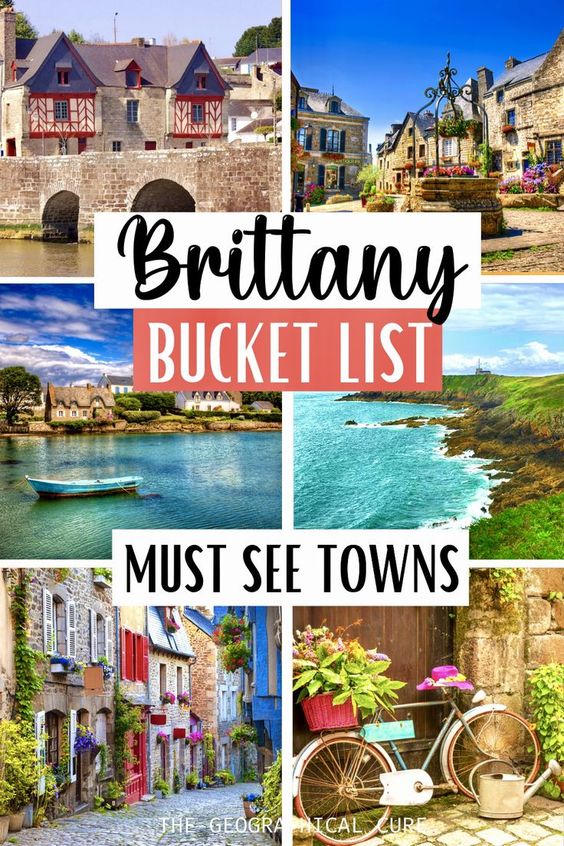
2 thoughts on “20 Most Beautiful Towns In Off the Beaten Path Brittany”
Hi, Thank you for your suggestions, now i have an idea where to go. I am planning to go to Brittany in July. Where is a good base for 4 days to see all these towns and villages? Much appreciated.
Dinan and Vannes make good bases, I think. If you want to explore the north, try Ploumanac’h.
Leave a Comment Cancel reply
Save my name, email, and website in this browser for the next time I comment.
Last Updated on March 5, 2023 by Leslie Livingston

Home » Travel Guides » France » 15 Best Things to Do in Brittany (France)
15 Best Things to Do in Brittany (France)
In northwest France Brittany is a region with an identity, landscape and even a language, all of its own. It is one of the six Celtic Nations and has a maritime climate that can sometimes make it feel more like Ireland than mainland France.
On the coast the scenery is at turns awe-inspiring and quaint, but always beautiful. At its most epic there are gigantic headlands lashed by the Atlantic and cliffs like you’ve never seen on the Pink Granite Coast. We could be here all day if we had to list the historic towns and villages around the region, some so diligently-cared for that they have barely changed at all in centuries.
Lets explore the best things to do in Brittany :
1. Coastal Scenery

The region pushes out boldly into the Atlantic and has a physical geography so raw and beautiful that you could spend years visiting the oceanfront around Côtes-d’Armor, Finistère, Ille-et-Vilaine and Morbihan, and feel like you’ve never come close to seeing every heart-rending sight.
Rightfully celebrated is the Pink Granite coast in Côtes-d’Armor, where the rocks have a mysterious tint that makes them seem not quite natural.
The Sentier des Douaniers trail, and the granite lighthouse at Ploumanac’h will take your breath away.
Honourable mentions also have to go to Pointe du Grouin near Saint-Malo, Pointe de Pen-Hir in the Parc Naturel Régional d’Armorique and Cap Fréhel together with the redoubtable Fort la Latte.
2. Prehistoric Monuments

Anyone who read Asterix books as a child will know that the forests of Brittany’s interior are littered with prehistoric menhirs, dolmens and cairns.
These were erected 7,000 years ago, and sit either alone on a hillside or in woodland, or as part of highly-significant complexes that have left generations of inheritors and visitors scratching their heads in amazement.
The village of Carnac in the Morbihan department is a kind of El Dorado for prehistory nuts, with more than 3,000 monumental stones, the largest collection in the world.
But this is just the gateway for your trip through Neolithic Brittany, with loads more to see, including cairns at Barnenez and Gavrinis, and a stunning passage grave at Roche aux Fées.
3. Saint-Malo

It isn’t sacrilegious to draw comparisons between the old part of this port city with nearby Mont-Saint-Michel.
Saint-Malo’s medieval walls are majestic, and you can walk along every inch of the ramparts and either look down at the labyrinthine streets or out over the cinematic beaches to the north and west.
On clear evenings you’ll be overwhelmed by the sight of the sun-setting behind the solemn grey stone buildings of the old-town.
Check out the tomb of the romantic writer, Chateaubriand, and when the weather’s good beaches like Plage du Sillon, with its rocky islands and clear, lagoon-like pools are a good bet.
Even if the water might be a bit chilly for swimming.
4. Huelgoat Forest, Finistère

In the hilly inland part of the Parc d’Amorique is the lakeside village of Huelgoat swathed in woodland that conceals a wondrous natural rock formations and caves.
If you pop into the village’s Office de Tourisme you can get hold of route maps, for hikes ranging from anything between hour-long circular tours to intrepid quests through the mossy deciduous forest.
Locally the best walk begins behind the old watermill on the lake, leading into a world of bizarre and outsized granite boulders.
Take the steep stairway down into the Grotte du Diable, a cave 10 metres below the lake, with walls lined by these rounded rocks.
5. Old Centre of Dinan

Even in a region lauded for its picturesque towns, Dinan stands out.
Most people have it down as the prettiest in Brittany, and the upper part, within the walls, has cobblestone streets with houses dating as far back as the 1200s.
As you step down Rue de la Cordonnerie you’ll be wondering whether you’re actually still in the 21st century! The upper floors of these rickety half-timbered buildings hang almost perilously over the street.
The river port is just as atmospheric, with restaurants by the quay and a 40-metre-high railway viaduct to add drama.
Make for the 13th-century castle to begin a tour of the ramparts or to learn about the history of this wonderful town.
6. Oysters, Cider and Crêpes

For seafood-lovers Brittany is the place to be.
Order a plateau de fruits de mer and you’ll be presented with a mountain of shellfish and crustaceans accompanied by slices of crusty bread and melted butter.
Unique gastronomic experiences abound in the region, like the waterside oyster market in Cancale, where you can eat them there and then.
Cider is the regional drink, and in Finistère there’s a designated Route du Cidre, through the AOC Cournouaille cider region.
And finally, you can hardly make it down a single Breton street without finding a crêperie.
These will produce the classic crêpes we all know and love, but also galettes, buckwheat pancakes usually with a savoury filling like fried egg.
7. Locronan

One of France’s “plus beaux villages”, Locronan blows everyone away.
It’s a tiny place, with only several hundred inhabitants and a totally pedestrianised old centre that is a true delight to discover.
If it feels a bit like a film set to you then it will come as no shock that several French movies and TV shows have been shot here.
The largest and most palatial homes in Locronan are from the 1700s, belonging to the owners of sail-weaving businesses who did roaring trade not just with the French navy but also the Spanish and British.
8. Quimper Cathedral

Like many of Brittany’s churches this marvellous gothic building is a real joy to investigate, but it also has a few quirks that make it special.
One is the way it tapers in the middle, to adapt to its natural setting.
That was to avoid a swampy bit of land when it was built in the 13th-century.
The cathedral is Quimper’s most beautiful piece of heritage and is a French National Monument.
Those marvellous spires are 75 metres in height and stand on either side of a sculpture of Gradlon, the semi-mythical 5th-century King of Cournouille.
9. Remparts de Vannes

In the Breton War of Succession in the 14th century Vannes came under siege four times from both the English and French forces.
Its bloody past has endowed it with a complete system of defences, which enclose an old quarter with half-timbered houses and add charm and a sense of authority to the town.
Nowhere is this truer than at the Jardin des Remparts on the east side of the walls.
It’s an elegant formal garden with topiaries and flowerbeds through which the River Marle flows, all with the medieval curtain and towers setting the scene.
There’s a market on Tuesday and Saturday mornings at Place des Lices, a square that hosted jousting tournaments in the middle ages.
10. Île de Batz, Roscoff

Opposite the town of Roscoff, once a haven for pirates and smugglers, is an island that is a little slice of rural paradise.
The ferry takes about 15 minutes and you should spend at least half a day on Batz seeing the coast and countryside.
Many people rent bicycles for the day and pedal off along coastal trails next to small beaches with nothing more than farmland on the foreshore.
The island catches the warm currents of the gulf stream, so many of the fields are dedicated to potato farming, and they say that Batz potatoes are the finest you can eat.
The warmer air also nourishes the island’s botanical garden created at the turn of the century with 2,000 species, like palm trees that are normally found at far more southern locations.
11. Brittany’s Canals

The region’s countryside is a laced with a system of canals that totals 600 kilometres.
This of course opens up a world of possibilities for outdoor tourism.
On the Canal de Nantes à Brest in the south and the Canal d’Ille-et-Rance in the north you’ll be able to hire a narrowboat.
You won’t need a licence for one of these as they travel at a glacial speed, giving you the chance to take in the historic sights on the banks and 19th-century engineering that made these waterways possible.
On land you could follow the “Voies Vertes”, where the canal’s towpaths are now walking trails, with a gentle slope that makes them great for even the littlest members of the family.
12. Rochefort-en-Terre

Another village selected as one of the most beautiful in France, Rochefort-en-Terre in Morbihan transports you back at least a century in time.
It’s not just the historic houses, but the entire structure of the old medieval village is still in place: The well and drinking troughs are still here and now decorated with geraniums.
Indeed the whole of Rochefort is alive with florid colour in the summer, with flowerboxes on windowsills and wisteria creeping up the granite walls.
The village took shape over several centuries so there’s also an arresting blend of styles, from rustic half-timbered houses to stone renaissance palaces with conical roofs on their turrets.
On summer nights the entire village is illuminated, as if couldn’t get any more romantic!
13. Château de Fougères

Not far from the border with Normandy the small town of Fougères has a brooding fortress that rises up sharply on the western section of the walls.
It’s considered one of the greatest castles in Europe, and is a compendium of historical military architecture.
The castle as we recognise it first went up in the 1100s, but there were a host of reinforcements and additions over the coming four centuries.
The towers are in great shape considering their age, and you can enter and climb three of them.
The best of these is probably Mélusine Tower, built in the 1300s by Raoul II, the Count of Eu.
14. Saint-Goustan

From the 17th to the 19th century this port was one of the busiest in Morbihan, and saw some pretty momentous events.
One was the arrival of Benjamin Franklin in 1776 to request French assistance in the War of Independence.
The port doesn’t handle that kind of traffic today and instead is a charming spot for a walk in the sunshine, with half-timbered houses dating to the 1400s, lots of boutiques and art galleries, and restaurants with outdoor seating next to the water.
After pottering around Saint-Goustan you can cross the medieval bridge to visit the town Auray, which holds a fantastic market on Mondays.
15. Zoo and Botanical Garden of Branféré, Le Guerno

Few zoos will have locations as dignified as this one in Morbihan: The park is set in grounds of a château from the mid-19th century.
In the early 1900s the estate’s owner was inspired to create a game reserve where the animals are able to roam free and pulled in zoologists to work out how to bring his idea to life.
It opened to the public in the 60s and has evolved into this popular attraction.
There are 1,000 animals, with zebras, hippos, antelopes and yaks, in 150 hectares of carefully-designed parkland that includes waterfalls and prairies.
If you like to see zoos that create a suitable environment for their animals then you won’t be disappointed here.
15 Best Things to Do in Brittany (France):
- Coastal Scenery
- Prehistoric Monuments
- Huelgoat Forest, Finistère
- Old Centre of Dinan
- Oysters, Cider and Crêpes
- Quimper Cathedral
- Remparts de Vannes
- Île de Batz, Roscoff
- Brittany's Canals
- Rochefort-en-Terre
- Château de Fougères
- Saint-Goustan
- Zoo and Botanical Garden of Branféré, Le Guerno
Must-see attractions in Brittany

Rue du Jerzual & rue du Petit Fort
Lined with half-timbered houses, this astonishing cobbled street has been here since at least the 12th century. It leads downhill at a steep angle all the…

Musée des Beaux-Arts
Extensive collections span the 15th century to the present at the Museum of Fine Arts, plus there is a section devoted to antiquities. The Pont-Aven…
Château de St-Malo
Château de St-Malo was built by the dukes of Brittany in the 15th and 16th centuries, and is now the home of the Musée d'Histoire de St-Malo, which…

Pointe du Grouin
A short drive from Cancale brings you to this sublime and stormy headland. Rock cleaves the water and fantastic views range over islands and rocks to the…
Château de Vitré
Dominating the town, Vitré's medieval castle rises on a rocky outcrop overlooking the River Vilaine, and is one of the most impressive in Brittany – a…
Côte de Granit Rose
Running along the coast from Penvern to Trégastel and Ploumanach lies one of Brittany's natural wonders: a delightful and breezy coastline of pink-,…
Constructed at the end of the 17th century under military architect Vauban, and measuring 1.8km, the ramparts of St-Malo can be accessed from several…
Île du Grand Bé & Fort du Petit Bé
At low tide, cross the beach to walk out via Porte des Bés to Île du Grand Bé, the rocky islet where the great St-Malo-born, 18th-century writer…
Abbaye de Beauport
If you have wheels (or you're up for a glorious 1½-hour walk along the seashore from the town harbour), head 3.5km east of Paimpol to this romantic 18th…
Barrage de la Rance
Built in 1966, this 750m bridge over the Rance estuary carries the D168 between St-Malo and Dinard, lopping a good 30km off the journey. A feat of…
Basilique St-Sauveur
The soaring chancel of the Basilique St-Sauveur is Flamboyant Gothic, but the south side of the church is Romanesque, while other periods and styles get…
Cathédrale St-Vincent
The city's centrepiece was constructed between the 12th and 18th centuries. During the ferocious fighting of August 1944, the cathedral was badly mauled,…
Tombeau de Merlin
The Tomb of Merlin is worth hunting out, secluded and lying quietly amid a grove of trees. According to legend, the Lady of the Lake circled Merlin nine…
La Vapeur du Trieux
Steam-engine buffs and lovers of fine scenery will be in seventh heaven aboard the chuffing carriages of this 1922 steam train that plies the old railway…
Mémorial 39–45
Constructed in the mid-18th century, Fort de la Cité d'Alet was used as a German base during WWII. One of the bunkers now houses this memorial, which…
Piscine Saint-Georges
The amazing building housing these baths makes for an astonishing sight as you walk up Rue Gambetta. Constructed between 1923 and 1926, it was designed by…
Be sure to head downhill along rue du Jerzual and rue du Petit Fort to the Vieux Pont (Old Bridge). From here, the bridge, a pretty little port, hemmed by…
Champs Libres
Rennes' futuristic cultural centre is home to the Musée de Bretagne, with displays on Breton history and culture. Under the same roof is Espace des…
Abbaye de Paimpont
Scenically overlooking the waters of the Étang de Paimpont (Paimpont Pond), this splendid and tranquil abbey is a highlight of the region. The abbey…
Fort National
The St-Malo ramparts' northern stretch looks across to the remains of this former prison, built by Vauban in 1689. Standing atop a rocky outcrop, the fort…
Île des Landes
The wave-pounded lozenge of Île des Landes – 1.1km long, slender and uninhabited – is home to hundreds of gulls and other seabirds. It's directly east as…
Plage de l'Écluse
Framed by fashionable hotels, a casino and neo-Gothic villas, Plage de l'Écluse is the perfect place to shade yourself in style by renting one of Dinard's…
Tour Ste-Catherine
The 14th-century Tour Ste-Catherine is just east of Basilique St-Sauveur and beyond the tiny Jardin Anglais (English Garden), a former cemetery and…
Fort de la Cité d'Alet
Constructed in the mid-18th century, Fort de la Cité d'Alet was used as a German base during WWII; one of the bunkers now houses this memorial, which…
Plage de Bon Secours
You can splash in the protected tidal swimming pool west of St-Malo's walls at Plage de Bon Secours, wander along the sand or climb the diving board to…
Ferme Marine
If you ever wanted to crack open the science and art of ostréiculture (oyster farming), this well-organised and informative museum, a couple of kilometres…
Musée de la Mer
This excellent little museum in a former cod-drying factory charts the Paimpol region's maritime history. Peruse nautical artefacts, from seine nets and…
Cathédrale St-Pierre
Crowning Rennes' old town is the 17th-century cathedral, which has an impressive, if dark, neoclassical interior adorned with a fabulous ceiling.
Musée de Bretagne
The excellent Musée de Bretagne contains exhaustive and in-depth displays on Breton history and culture, through to the modern era.
Tour de l'Horloge
Climb up to the little balcony of this 15th-century clock tower whose chimes ring every quarter-hour.
Grand Aquarium
Containing over 600 species of marine creature, this very popular aquarium about 4km south of the city centre features a 'Nautibus' ride – a simulated…
Palais du Parlement de Bretagne
This 17th-century former seat of the rebellious Breton parliament has, in more recent times, been home to the Palais de Justice. In 1994 this building was…
Musée d'Histoire de St-Malo
Within Château de St-Malo, built by the dukes of Brittany in the 15th and 16th centuries, this museum examines the life and history of the city through a…
Musée Jacques Cartier
This 16th-century manor house was the home of controversial explorer Jacques Cartier (1491–1557), who mapped the St Lawrence River and whose explorations…
Musée International du Long Cours Cap-Hornier
Housed in the 14th-century Tour Solidor, this museum presents the life of the hardy sailors who followed the dangerous Cape Horn route around the southern…
Anse du Verger
Anse du Verger, 4km west of the point, is a lush terrain of beaches, dunes and trails with a picturesque small church, Notre Dame du Verger, dedicated to…
La Demeure de Corsaire
This 18th-century mansion and historic monument was once owned by corsair (privateer) François Auguste Magon. Guided tours are knowledgeably presented but…
Espace des Sciences
Highly popular with and chiefly aimed at kids, the Espace des Sciences is a fun interactive science museum arranged over two floors, situated in Rennes'…
Château-Musée de Dinan
The town's museum is atmospherically housed in the keep of Dinan's ruined 14th-century château, showcasing the town's history, with information sheets in…
Plage des Bas Sablons
This long and pleasant beach by the marina in St-Servan has a dike that prevents the water from receding entirely at low tide.
More destinations you need to see

Best Things to Do in Brittany, France
Article written by Elisa This article may contain compensated links. Please read disclaimer for more info.
Visit Brittany (Bretagne) France
La Bretagne – Brittany in English – is one of the most beautiful regions of France, with wild landscapes, historical cities, rich culture, and a strong identity. It is a region of tradition and character, where the stories of sailors meet the Celtic legends.
Brittany, in Western France , has a double face deeply rooted in both the land and the sea. Bathed by the English Channel and the Atlantic Ocean , Brittany offers breathtaking coastal landscapes. It is also a land of medieval towns, mysterious rock alignments, and deep forests full of legends.
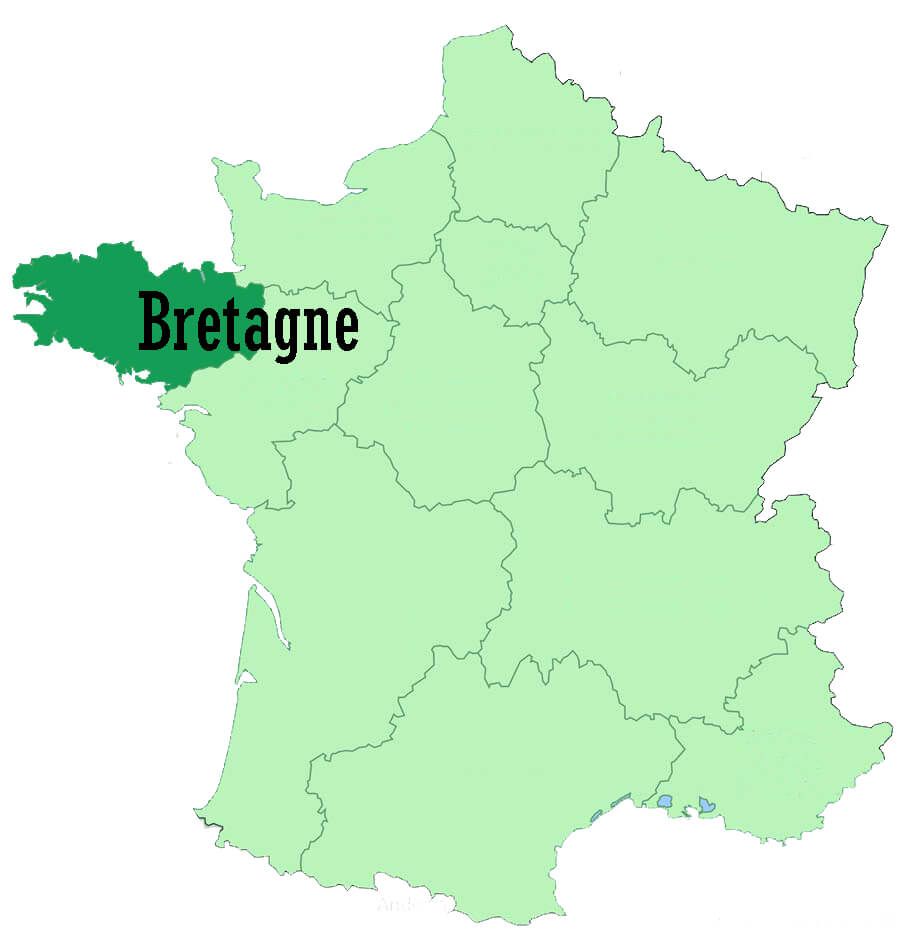
The region of Brittany is divided into four departments: Côtes-d’Armor (22), Finistère (29), Ille-et-Vilaine (35), and Morbihan (56). The capital of Brittany is Rennes .
Are you planning a trip to Brittany, France? Our list of best things to do in Brittany is far from exhaustive, but it has the essential places to visit in Brittany and the main Brittany tourist attractions.
Related posts
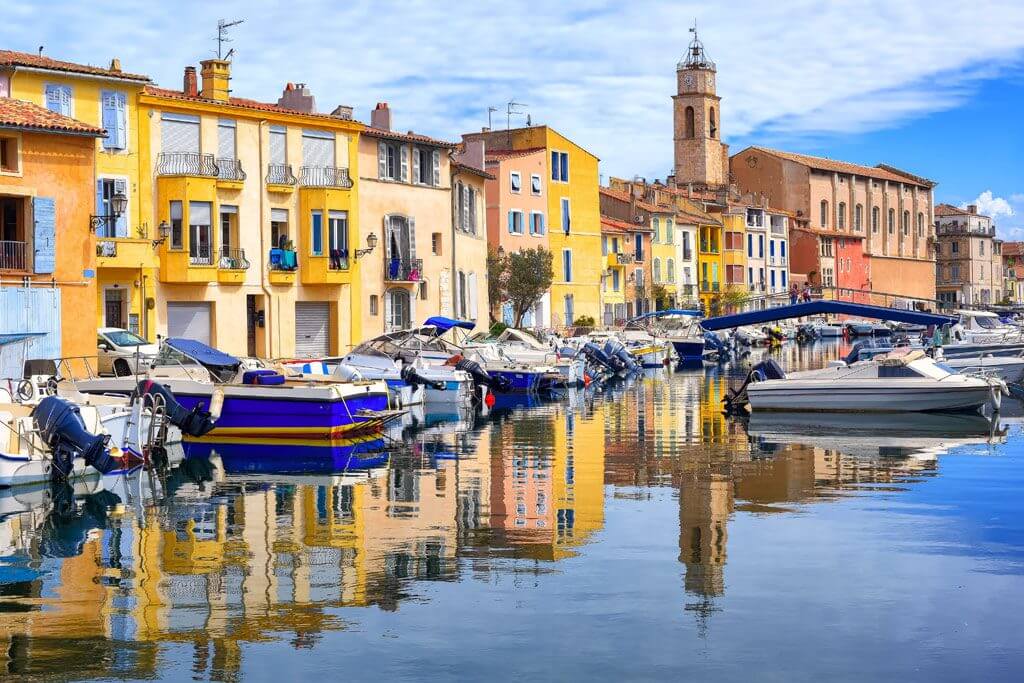
Brittany Travel
BY PLANE: Brest (BES) and Rennes (RNS) are the 2 major airports in Brittany. It is possible to travel to Brest and Rennes from other cities in France and some cities in the UK such as London, Manchester, Dublin, Southampton, Manchester, or Exeter.
Find cheap flight tickets to Brittany
BY FERRY: Brittany is well connected with the UK and Ireland through the ports of Roscoff and St-Malo . The ferry companies serving these destinations are Brittany Ferries and Condor Ferries.
Book your ferry to Brittany
BY TRAIN: Traveling to France by train is straightforward. The main cities of Brittany are served by TGV trains from Paris and the south of France (Lyon, Bordeaux, Marseille). It is also possible to travel to Brittany by train from England, taking the London-Rennes or London-Brest railway line.
You can explore many other places in Brittany by regional trains (TER Bretagne).
Book your train tickets to Brittany
Explore Brittany by Car
Brittany is a great place for memorable France road trips . With a car, some good tunes, and the best company, you are set for one of the best adventures in your life. Visit the main cities and then go off the beaten path to get the most out of Brittany.
Recommended road trips in Brittany:
- Road trip Dinan to Mont St-Michel
If you don’t have your own car, we recommend booking in advance through platforms like Discover Cars . This site takes all of the major rental companies, such as Hertz, Avis, etc., and compares prices for you.
Browse Car Rental Companies Available in Brittany
What to Do in Brittany France
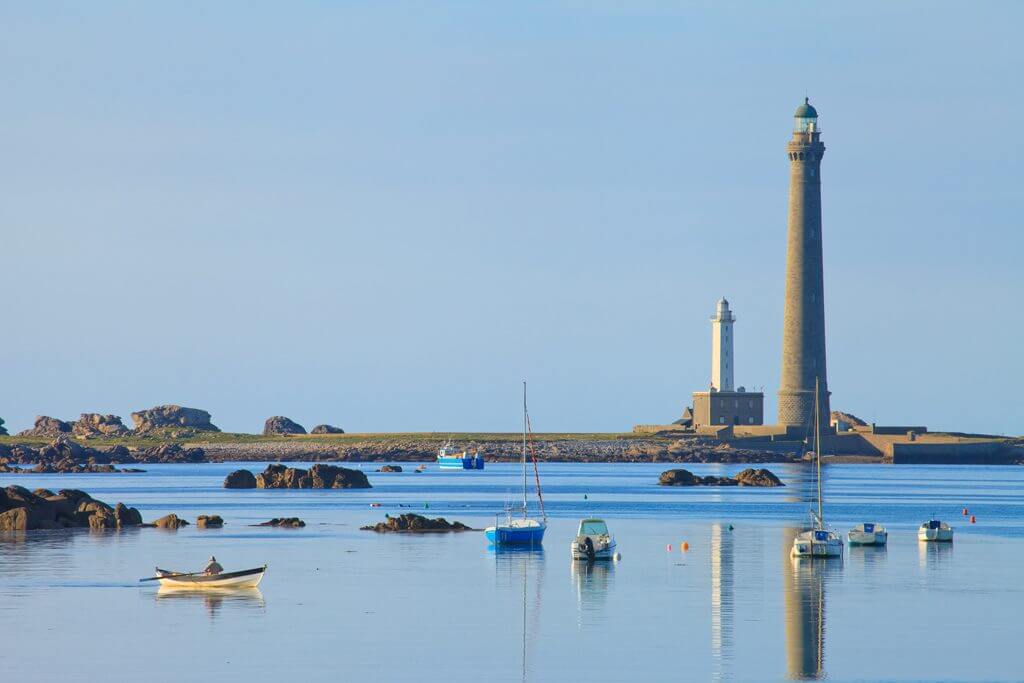
What to do in Brittany France for one week or two? This is our list of the best things to do in Brittany, France. From coastal walks and Corsaire cities to impressive castles and deep forests, the Brittany Region is a myriad of landscapes and sites waiting to be discovered.
The Alignments of Carnac (Karnag)
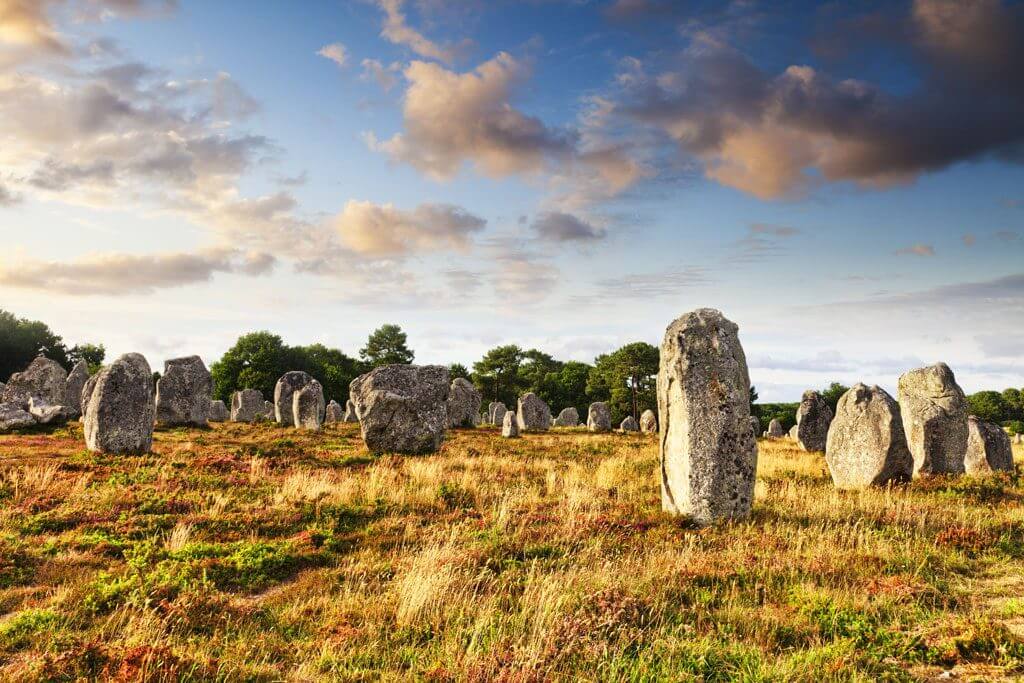
The alignments of Carnac are located in Morbihan , Southern Brittany. It is an exceptional site of megalithic alignments of more than 3,000 menhirs over more than 4 kilometers. These menhirs, erected between 6,000 and 2,000 AD, are found in four sites: Le Ménec , Kermario , Kerlascan, and Le Petit Ménec .
Take the time to wander around the giant stones and soak up the special atmosphere of the site: perhaps you will find the meaning of all these alignments!
Before leaving, check out the Kermario alignment, not far from Carnac, in Saint-Colomban: archaeologists have found along the coast the oldest forms of habitat, 300,000 years old!
A Romantic Getaway to Dinan
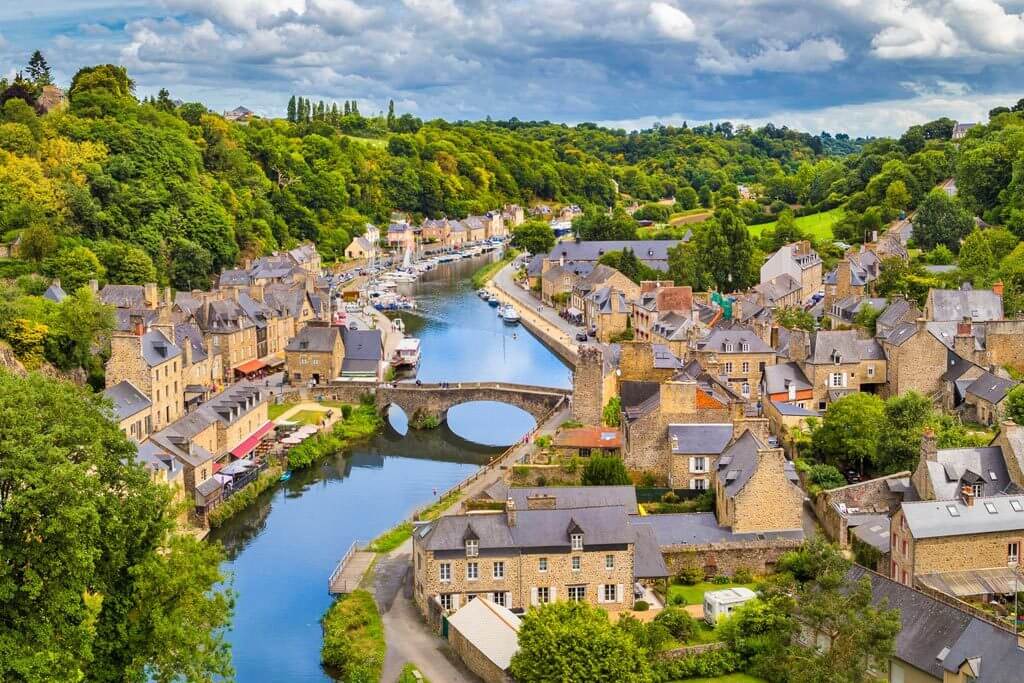
If you are wondering where to go in Brittany for a romantic getaway, Dinan is a good option. Overlooking the Rance River and surrounded by ramparts, the old medieval city of Dinan still keeps its half-timbered houses of the 15th century and its winding cobbled streets.
Visit the Clock Tower, the Basilica of Saint-Sauveur, and the Castle of the Dukes of Brittany. Then take Jerzual street, the most famous street of Dinan, which goes down to the port on the Rance River. This is the perfect spot for a drink with beautiful river views.
TIP: Hotel Ibis Styles , in the heart of Dinan, has always great reviews
The Pink Granite Coast
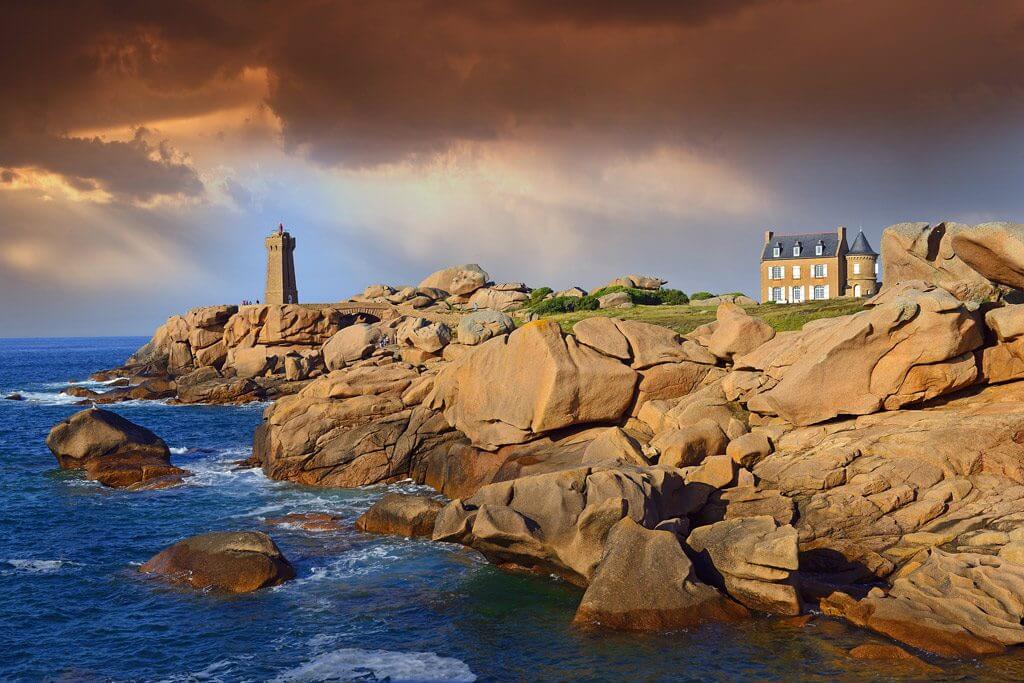
On the side of Perros-Guirec in the northwest of Côtes-d’Armor, the Brittany coast is dotted with rocks, cliffs, and coves in pink granite.
The best way to discover the Pink Granite Coast is by taking the 4 km section of the Sentier des Douaniers coastal hike (GR 34) that runs from the chic seaside resort Perros-Guirec to the village of Ploumanac’h. En route, be amazed by the rough sea, many uninhabited islets, and the reliefs of pink granite rocks.
When you reach the village of Ploumanac’h , voted the most beautiful village in France in 2015, spend some time on its beautiful and small sandy beach: when the tide is low, it is like walking over the moon.
Crozon Peninsula – The Caribbean in Western France
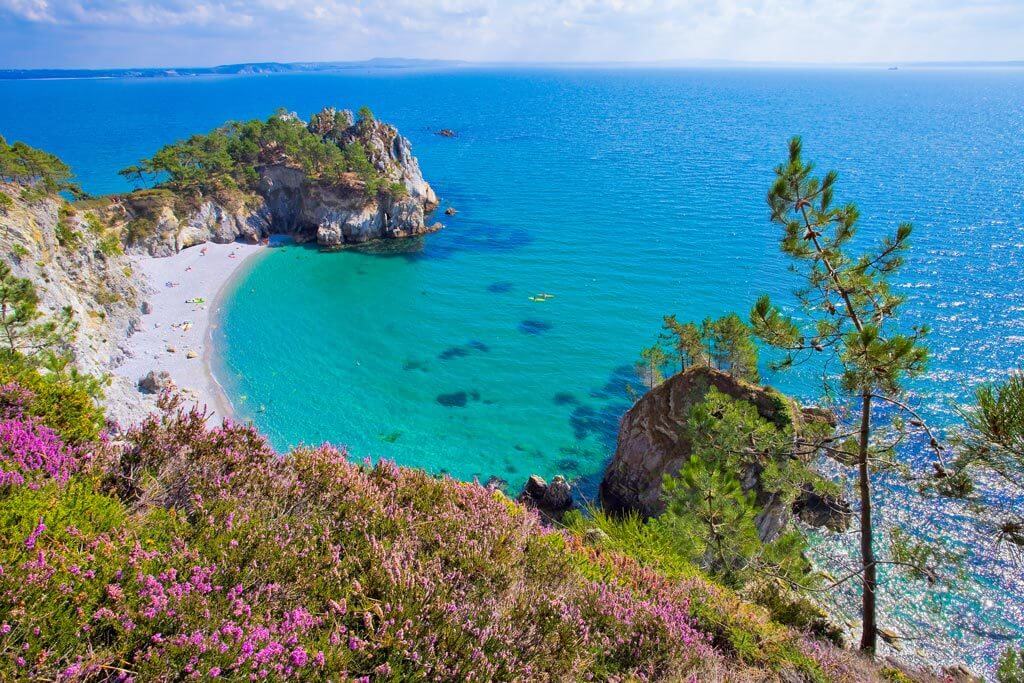
Who needs to travel far away with such beautiful landscapes in Western France?
Forming a gigantic cross in the sea, the Peninsula of Crozon (Presqu’ile de Crozon) offers Brittany’s condense. Its landscapes alternate spectacular cliffs, heather moors, and turquoise waters. As you can see, these Brittany beaches have nothing to envy to the Caribbean beaches, except perhaps the water temperature!
The Peninsula of Crozon is best explored from the sea so that you can see Crozon’s sandstone walls and rocky overhangs. Boats leave from the ports of Camaret or Morgat.
The Castles of Brittany
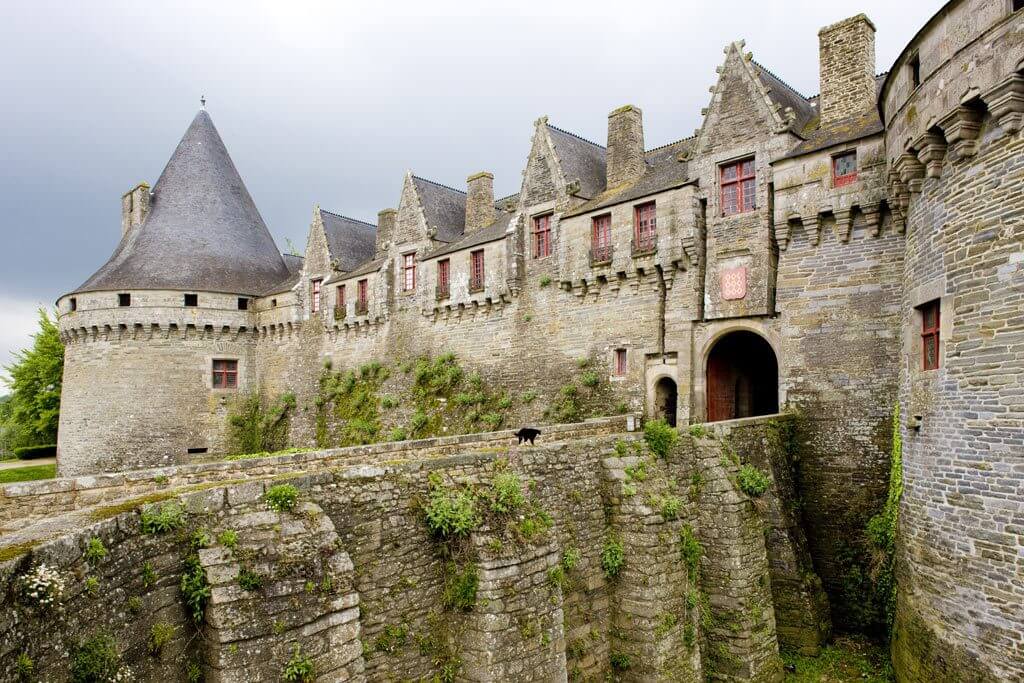
Brittany is full of castles and fortresses, located on the coast but also inland. The Castles in Brittany don’t look like the castles of France we all have in mind, but they are also stunning constructions worth visiting.
Discover the history of Brittany – independent of the Kingdom of France until 1532 – by visiting its most beautiful castles, full of legends. Some castles in Brittany even come with a phantom in the closet!
The list of most beautiful castles of Brittany includes Château de Rohan , Château de Kerjean , Château de Fougères , Château de Josselin or Château de Susscinio but there are many more!
The Sweet Life in Gulf of Morbihan
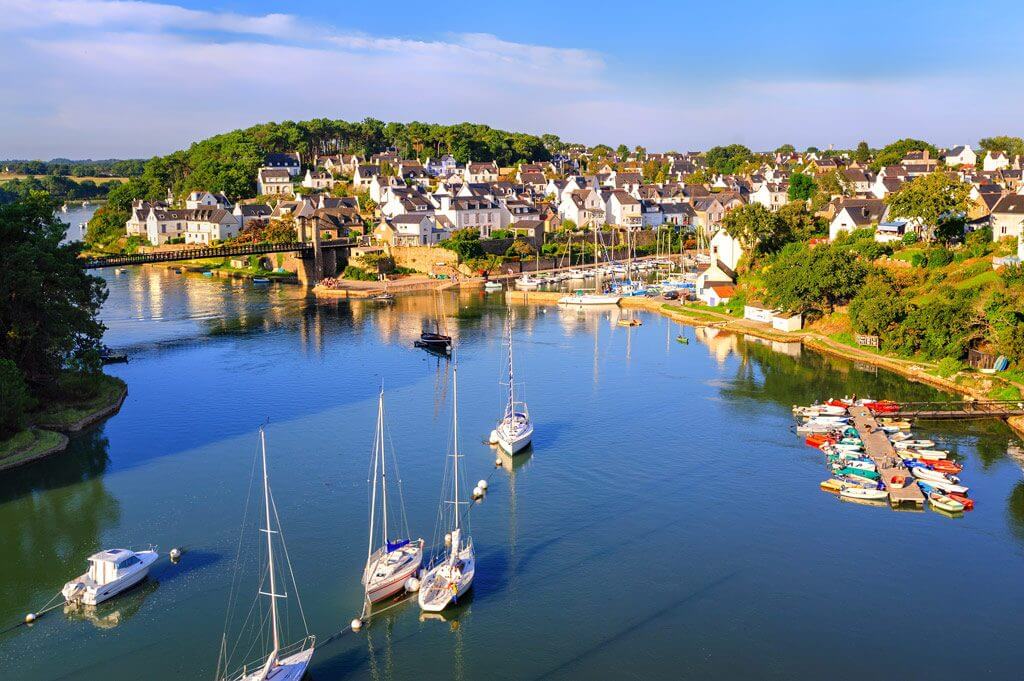
With its many islands and islets, its microclimate that warms the sea, and its sweet life, the Gulf of Morbihan is one of Brittany’s most beautiful landscapes to discover all year.
In this ‘little sea’ – this is what the word ‘Morbihan’ means – it is possible to sail or kayak to discover islands and islets protected from the vagaries of the ocean and some pretty Brittany coastal towns.
Among the fifty or so islands of the Gulf, Île aux Moines is the largest and best known, while the Île d’Arz is sailors’ favorite.
The Enchanted Brocéliande Forest
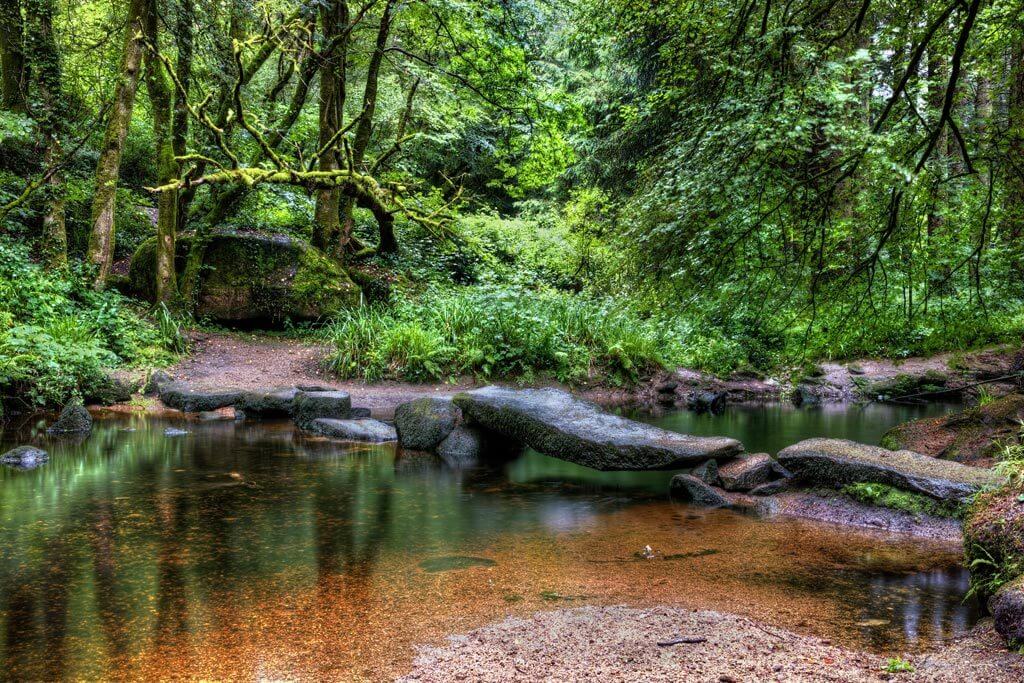
Inland, Brittany offers rugged hilly landscapes and majestic ancient forests, such as the mysterious and dark Brocéliande forest . This is a very authentic place, the forest where the famous legends of King Arthur, Morgana, and Merlin were born.
During your walks in the shade of ancient trees, you will have the opportunity to see some remarkable sights like the Tomb of Merlin, or the Tomb of the Giant and the Fountain of Youth, specially designed to illustrate the Arthurian legends.
Brocéliande forest is one of the best places to visit in Brittany, France, very easy to visit on a day trip from Rennes. For those without a car, we recommend taking a day tour.
Saint-Malo – The Corsair City
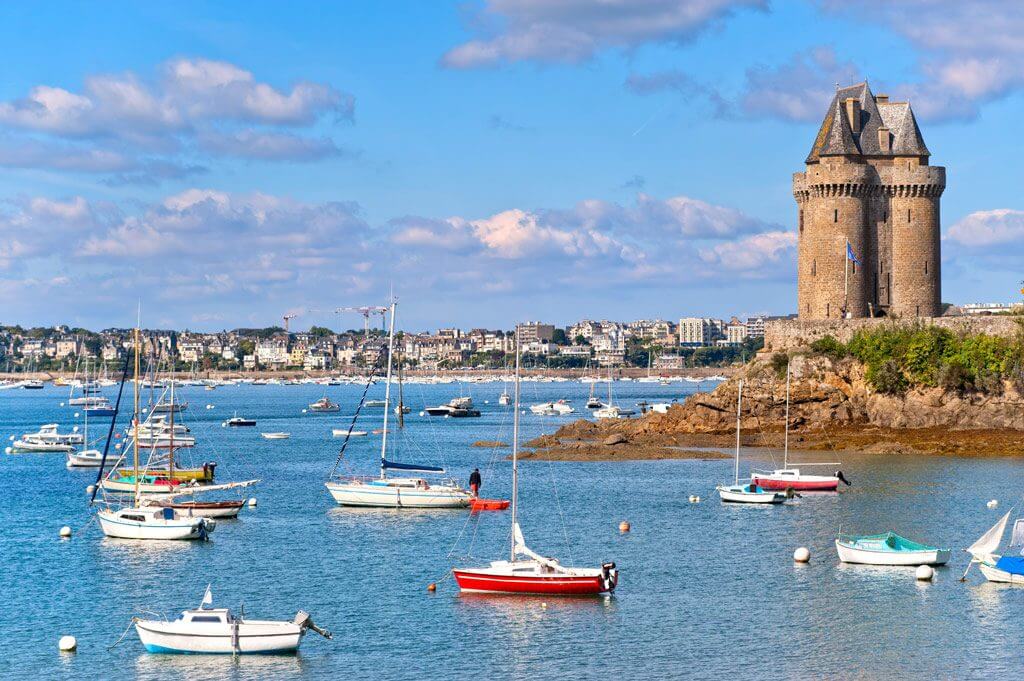
Saint-Malo is one of the most beautiful cities in Brittany, with an interesting past of sailors, sea explorers, and corsairs. It is an old port city, one of the main Breton ports, with high granite ramparts which dominate the English Chanel.
Take a tour of the ramparts to admire the view of the outer harbor, Dinard, the entrance to the Rance River, and the beautiful Brittany beaches of the Mole and Bon Secours . From here, you can also see the islands of Grand Bé and Petit Bé. Then walk downtown to pay a visit to its Romanesque-Gothic cathedral and perhaps stop for a crêpe and a bowl of cider.
If the tide is low, walk to Chateaubriand’s tomb on Grand Bé island. Originally from Saint-Malo, the famous inventor of Romanticism, François René de Chateaubriand , is buried on this uninhabited island which, at low tide, becomes a peninsula.
Saint-Malo is easy to reach from Paris by train. Some people use beautiful Saint-Malo as a base camp to explore Mont Saint Michel, in Normandy, on a day trip.
TIP: the beachfront Hotel Le Nouveau Monde , in Saint-Malo, always has wonderful reviews
Sail the Brest – Nantes Canal
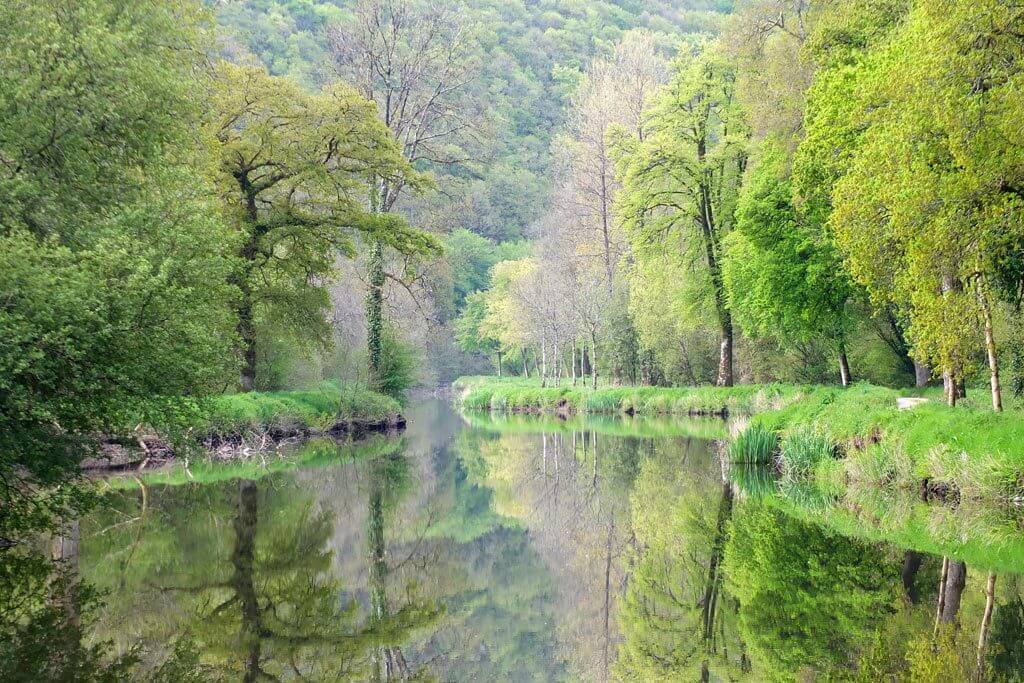
Built in the first half of the 19th century and inaugurated by Napoleon III in 1858, the Nantes – Brest Canal connects these two cities through the valleys of the Erdre, Isac, Oust, Blavet, Doré, Kergoat, Hyères, and Alder.
The Canal is the perfect place to spend a long weekend on a houseboat, at a cruising speed of 6km/h – check out this boat trip itinerary with Le Boat France for inspiration. On the way, admire its wonderful landscapes, dotted with castles and other interesting sights.
Explore the Best Towns in Brittany
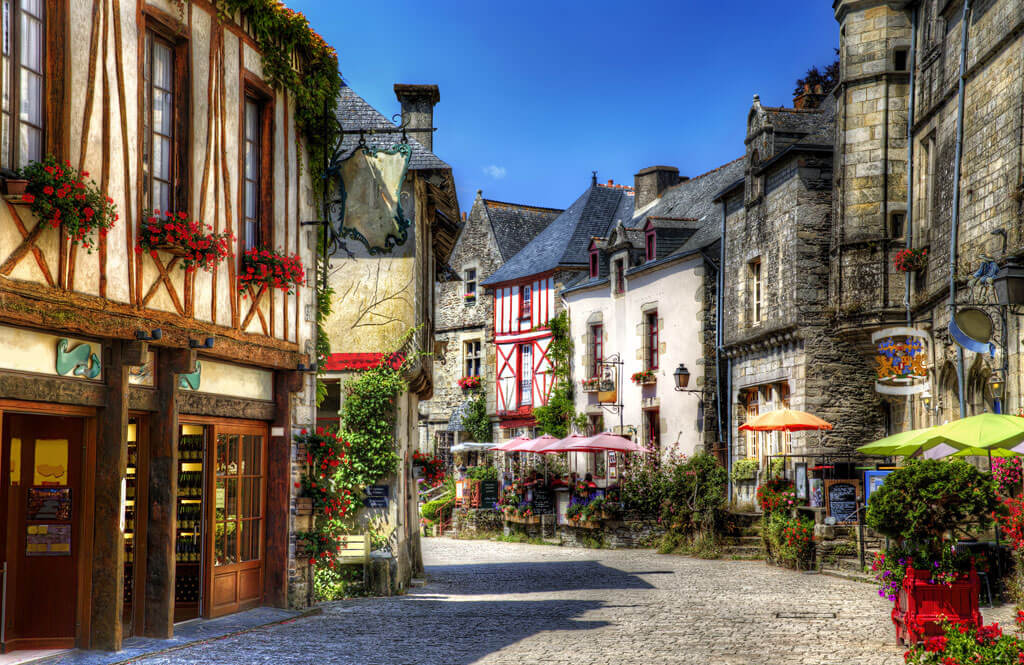
This list of the best of Brittany would not be complete without its most beautiful towns. Brittany is home to some of the best coastal towns in France , but there are many rural gems also inland. From small medieval towns stuck in time to flowered granite villages, places like Rochefort-en-Terre , Locronan, Moncontour, Sauzon , or Pont-Croix will likely steal your heart.
Hike the GR34 – Le Sentier des Douaniers
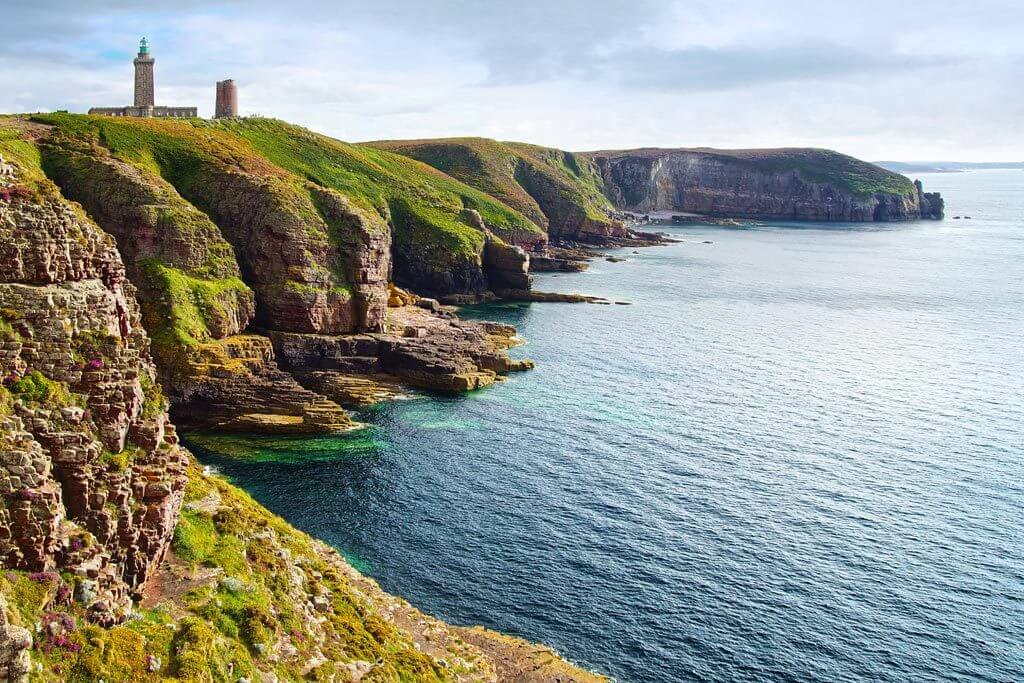
Last but not least, there is the GR34 (Le Sentier des Douaniers), a multi-day hike that borders all of Brittany’s coastline for over 2,000 kilometers.
This wonderful hike, which starts at the Bay of Mont-Saint-Michel and ends in Saint-Nazaire (Loire-Atlantique), covers most of the Brittany coastal towns and sites mentioned above. On the way, hikers cross five French departments while enjoying the best of Brittany: great views, gorgeous beaches, and isolated lighthouses.
Food in Brittany
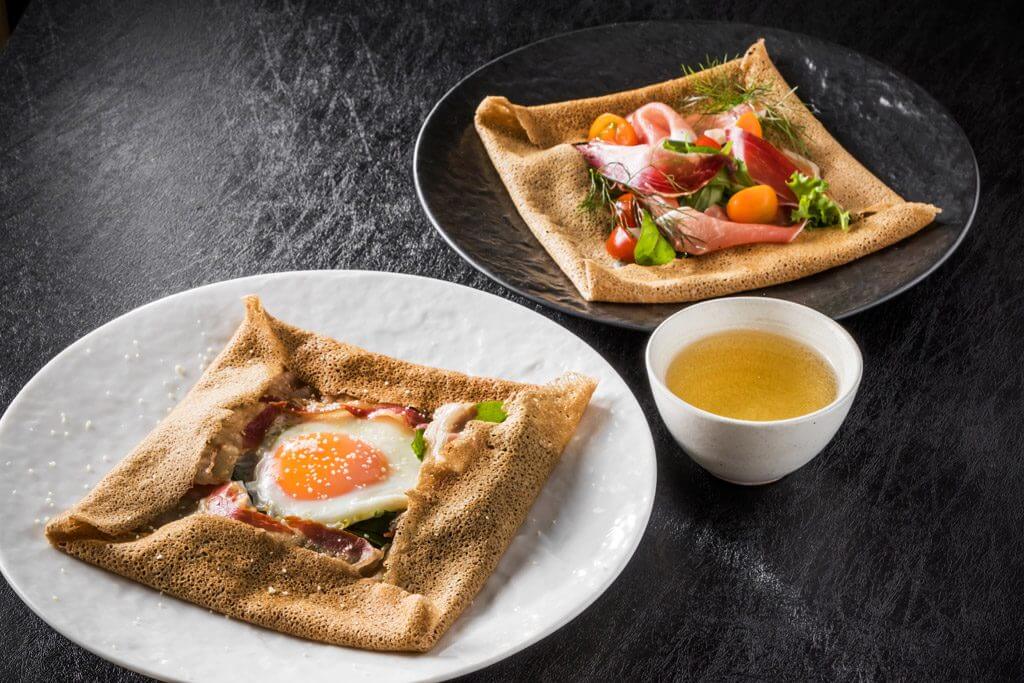
We could not finish this article about Brittany without mentioning its cuisine. The Breton Cuisine is a fresh mix of mackerel and sardines, pork rillettes, and Breton pancakes. The Breton cooks with what he has on hand: flour, apples, pork, and butter. Lots of butter. Perhaps this does not sound very sexy, but despite that, Brittany has forged a true culinary identity in France.
Being bathed by the Chanel and the Atlantic Ocean, Brittany obviously offers a wide choice of fish and seafood. To have a taste of it, order the Breton lobster, clams, and mussels, or a plate of oysters with shallot sauce.
Apart from the fish and seafood, the list of regional specialties includes:
- Meat: Kig ha-farz (a dish of meats stewed in buckwheat stuffing, like a pot-au-feu);
- Vegetables: Artichokes, cauliflower,
- Crêpes and galettes: Breton crêpes, Breton galettes, sausage galettes;
- Cheese: Emmental
- Desserts: Far Breton (a flan-style custard cake), Breton cake, Kouign amann (a layered, buttery pastry), and pound cake.
Brittany is not the best region for wine travel, but the cider is amongst the most famous french drinks , and the Breton beer and some of its liquors won’t disappoint you!
PRACTICAL INFO & OUR FAVORITES | BRETAGNE, FRANCE

The best time to visit Brittany is from June to September. August and September are the best months for those who want to take a bath (but don’t expect a water temperature higher than 18ºC!).
In general, avoid the months of December to March. In December and January, the chances of rain in Brittany are more than 55%.
Where to stay in Brittany?
- Best Hotels in Rennes
- Best Hotels in Dinan
- Best Hotels in Saint-Malo
- Best Hotels Gulf of Morbihan
>> Here’s a selection of wonderful hotels in the Brittany Region
What to do in Brittany?
- Sailboat and kayak
- Hiking, cycling, horseriding
- Beach, spa retreats
- Sightseeing, Romantic, Cultural and gastronomy getaways
And there you have it, the list of best things to do in Brittany, France. If you want to learn about other regions, check out this article on the Regions of France , where we have summarized the highlights of each region.
Click here to Explore the French Regions
Back to Homepage
Disclaimer: This article may contain compensated links, meaning we get a small commission if you make a purchase through our links. It costs you nothing more (in fact, if anything, you’ll get a nice discount) but helps us to go on creating incredible French content for you. We trust all products and brands promoted here and would never recommend anything that isn’t of value. Please read disclaimer for more info.
(C) Copyright 2019 - 2024 France Bucket List. All Rights Reserved. Designed & Developed by France Bucket List || Disclaimer || Privacy Policy || Contact |

11 Best Things To Do In Brittany
By: Author Christine Rogador
Posted on Published: September 11, 2021 - Last updated: September 19, 2022
Are you looking for the best things to do in Brittany ?
Brittany is famed for its ruggedly beautiful 700-mile coastline, great gastronomy , and distinct culture, and it is one of France’s most scenic provinces.
Surrounded by the sea and filled with character, Brittany is an interesting destination to discover.
Whether you wish to meander around walled medieval cities, explore peaceful villages, or appreciate Stone Age sites, Brittany has plenty to offer.
Things you'll find in this article
1. Step inside Saint-Malo Cathedral
2. get to know rennes, the region’s capital, 3. explore nantes, 4. see carnac’s neolithic sites , 5. experience island life in belle-île-en-mer, 6. learn about the history of the chateau de dinan, 7. stroll through the forest of brocéliande, 8. hike the pink granite coast, 9. feast on oysters in cancale, 10. take in the sights and flavors of quimper, travel tips and resources.

Continue reading to discover some of the best locations to visit and things to do in this gorgeous part of France.

Saint-Malo is home to some of France’s most stunning churches and among them is the town’s cathedral. This church was built in 1146 and has endured the test of time with its majestic construction.
One of the best things to do in Brittany is visit the church, which is noted for its stunning stained-glass windows and towering building.

Rennes , Brittany’s capital, is bursting at the seams with culture and events. It is noted for its half-timbered houses from the Middle Ages and was named France’s most livable city in 2018.
For some peace and quiet, go to Parc du Thabor, a charming French garden . The Museum of Fine Arts is a great place to visit if you want to learn more about the city’s history and culture . For a taste of the region’s best crepes, go to Creperie Ouzh-Taol.

During the Middle Ages, Nantes , located at the junction of the Erdre and Loire Rivers , was the capital of the Duchy of Brittany. Today, Nantes is France’s sixth largest city and a thriving hub of higher education.
Begin your tour of Nantes’ historic core in the Château des Ducs de Bretagne, where the Musee d’Histoire de Nantes is housed in its splendid Gothic reception rooms.
The collection includes paintings , sculptures, pictures, model ships, and scientific instruments, among other things.
After the château, head west to the Bouffay district. Explore the maze of meandering lanes adorned with half-timbered houses.
In the centre of Nantes, the Place Royale, an attractive 18th-century square, and the Rue Crébillon, with its many stores and restaurants, are also great places to visit.

Carnac is named after the Celtic word “carn,” meaning “stone monument,” and is located on the Quiberon Bay.
See Carnac’s Neolithic structures, which include the “Circuit des Alignments,” which consists of freestanding circles and rows of stones up to six meters high, and the Tumulus Saint-Michel megalithic monument, which is topped by a modest chapel.
The Musée de Préhistoire de Carnac, in Carnac, is one of Europe’s top prehistoric museums, with exhibits from nearby archaeological sites.
From 450,000 BC through the Gallo-Roman epoch, the collection portrays human evolution, encompassing the Paleolithic Period (Stone Age) and the Neolithic era.

The name of the island translates to “Beautiful Island in the Sea,” a perfect description of its stunning natural environment in Quiberon Bay on Brittany ‘s southwest coast.
The primary centre of activity on Belle-Île-en-Mer is Le Palais, an intriguing village with many restaurants, hotels, art galleries, and artisans’ enterprises.
Above the harbor in Le Palais is the Citadelle Vauban, a historic citadel that is now a Hôtel-Musée (Hotel-Museum). A road extends southwest across the island from Le Palais to the rough Côte Sauvage coastline.
Southeast of Le Palais is the Plage des Grands Sables, the island’s most stunning beach.
View this post on Instagram A post shared by Bretagne Destination Paradis (@bretagne.destinationparadis)
The Dinan Castle, or Château de Dinan, was erected in 1382. It is also known as the “Donjon de la Duchesse Anne” and was completed shortly after John IV of Montfort, Duke of Brittany, returned from exile in England.
Dinan’s settlement is physically connected to the castle, and it acts as the town’s primary defense. The castle was built particularly to be a residential castle, even though it performs significant security and defense responsibilities.
Some of the must-see features of the castle are the kitchen on the ground level, and the halls and chambers decorated in traditional medieval style.

Broceliande Forest lies around 40 kilometers (25 miles) west of Rennes, and the majority of the forest is owned by a few famous families in the area. As a result, certain parts may be closed to the public.
However, most of the best places to visit and explore are available to visitors.
The woodland is believed to be a particularly legendary and enigmatic region because of the countless stories and traditions surrounding King Arthur, Merlin the wizard, and Viviane the fairy.
View this post on Instagram A post shared by CARNET DE BRETAGNE (@carnetdebretagne)
On the side of Perros-Guirec, in the northwest of Côtes-d’Armor, the Brittany coast is strewn with pink granite rocks, cliffs, and coves.
The Sentier des Douaniers coastal trek, which stretches from the fashionable seaside town Perros-Guirec to the village of Ploumanac’h, is the ideal way to discover the Pink Granite Coast.
The stormy sea, several uninhabited islets, and reliefs of pink granite rocks will all astonish you along the way.
Spend some time on the gorgeous and little sandy beach of Ploumanac’h, France’s most beautiful village in 2015: it’s like walking on the moon when the tide is low.

Seafood may be found all across Brittany, but the best oysters are in Cancale, a small fishing community 13 kilometers east of Saint-Malo .
Every day, the La Houle Harbour Oyster Market is open and fresh oysters are sold at wholesale prices.
Simply sit on the quay and shuck your extra-fresh oysters while appreciating the beauty of the sea, as they are served on a dish with a bit of lemon. They go nicely with wine , bread , and butter, so bring your own for a more refined oyster feast for lunch.

Crêpes and galettes are two almost identical traditional Brittany treats. They’re common across the region, and they’re frequently served with an apple cider bolée (ceramic bowl).
Many consider Quimper, the capital of Brittany’s Finistère district, to be the best when it comes to crepes and galettes.
In the old town, particularly on Rue du Sallé and Place au Beurre, there are various great crêperies. A must-try is the galette-saucisse, or buckwheat pancake with sausage. It’s the traditional street food from Brittany and a must while exploring Quimper.
11. Discover Pont-Aven’s Arts Scene

Pont-Aven in the Finistère department of Brittany was discovered in the 1860s by American painters, but it is most famous for its connection to the post-Impressionist painter Paul Gauguin and the Pont-Aven art movement.
Gauguin arrived at Pont-Aven in 1886 and co-founded the “Ecole de Pont-Aven” style of painting with Émile Bernard.
Many works by Ecole de Pont-Aven painters can be found in the village’s Musée de Pont-Aven.
For those who want to see the scenes that inspired great art, an Artists’ Trail map (available at the tourist office) shows the sites in Pont-Aven and the surrounding area that were captured by the Ecole de Pont-Aven painters.
Travel Insurance: I never leave home without travel insurance. My personal opinion is if you can afford to travel, you can afford to buy a travel insurance. All things can happen while on the road and you can never be too sure. And it's something that you'll be glad to have when you need it. For my preferred travel insurance, I use Safety Wing .
What To Wear: If you want some ideas on what to pack for France, check out this packing list guide for France .
Where To Stay: I personally use Booking.com for all my accommodations. Check out for their latest deals here .
Reading Resources: Check out our best reading resources here .

Hi, I’m Christine – a full-time traveler and career woman. Although I’m from the Philippines, my location independent career took me to over 40 countries and lived in 4 continents in the last 10 years, including France. A self-proclaimed Francophile, I love everything France.
Sharing is caring!
12 Most Notable French Royals - Journey To France
Sunday 23rd of January 2022
[…] Anne of Brittany. Since there was no male successor, she was left with control of the area of Brittany. In 1491, she married King Charles VIII of […]
France in June: Weather, Things to See and Travel Tips - Journey To France
Monday 6th of December 2021
[…] is the capital city of the northwestern region of Brittany, known for its majestic cathedral, medieval architecture, and fascinating half-timbered […]
18 Regions Of France List (Map + Attractions) - Journey To France
Monday 29th of November 2021
[…] Bretagne (Brittany) […]
10 Biggest Cities In France - Journey To France
[…] is known for: Château des Ducs de Bretagne (Castle of the Dukes of Brittany), Cathedral of St. Peter and St. Paul, vineyards that produce Muscadet […]
France in September: Weather, Things to See and Travel Tips - Journey To France
Thursday 25th of November 2021
[…] fortress city of Saint-Malo is a must-visit when in France. It is located in Brittany and was first constructed as a rocky island. This is a lovely city, with an interesting […]
Brittany travel guide

Visit Brittany, France
Brittany has an exceptional coastline with many beaches, fishing villages and islands, a remarkable historical heritage to be seen in the towns and villages and some of the finest prehistoric landmarks in the world - just a few of the reasons why so many people visit Brittany year after year!
Brittany tourism
Brittany is situated in north-west France with the English channel to the north, the Bay of Biscay to the south, and Rennes as region capital.
With 2000 kilometres of coast, numerous islands and beaches, ports and historical towns there is a great deal to discover - much more than you can expect to visit in a fortnight! For the most popular coastal destinations in the region see Brittany beaches and resorts
Below we introduce each of the four departments in Brittany, and offer suggestions and highlights for each to help you decide which is right for you - we also have detailed reviews of each the departments and many of the highlights and a separate feature about the highlights around the Brittany coast ...
Ille-et-Vilaine - eastern Brittany
With less coast and more countryside than the other regions of Brittany, the Ille-et-Vilaine is an easily accessible and popular department around Rennes in eastern Brittany and along the coast to the west of Mont-Saint-Michel, here known as the Emerald Coast .

As well as the beaches and coastal attractions, the town of Dol-de-Bretagne is a few kilometres inland, with other highlights including Rennes and the medieval town of Vitré - all three have interesting historical town centres. Near to Dol-de-Bretagne the pretty village of Mont-Dol is worth a visit and book lovers will enjoy a visit to the village of Becherel to the north-east of Rennes. It is known as the 'village of books'.
Pretty Fougeres and its renowned castle is 20 km to the north of Vitré, while Saint-Suliac , classified among the most beautiful villages in France, is to the north-east of the Ile-et-Vilaine.
Other places of interest include Combourg and its chateau between Rennes and the impressive port town of Saint-Malo , while further east you should also visit Cancale and Dinard .
See the Ille-et-Vilaine travel guide for highlights and detailed tourist information
Cotes d'Armor - northern Brittany and popular beach resorts
The Cotes d'Armor includes most of the northern coastline of Brittany, and is best known for the many scenic highlights along the coast - but like all regions in Brittany there is also much to discover when you venture inland...

Most visits will include a trip along the famous coast of pink granite around Perros-Guirec , and trips to see Cap-Fréhel and Cap Erquy (a scenic natural highlight) and also nearby Fort la Latte and Tregastel .
Other notable sights along the coast include the picturesque port of Dinan , also Paimpol and the cathedral town of Treguier , the riverside port town of Pontrieux to the south and you can visit the large port / town of Lannion to the north-west.
Highlights inland from the coast include Plancoet , and a short distance from Saint-Brieuc you can visit Moncontour , once the centre of Brittany's linen production.
See the Cotes d'Armor travel guide for tourist information
Finistere - western Brittany
Finistere is the department that occupies the western, most isolated part of Brittany. The coast is quite rugged and exposed in places - and very beautiful - and the region also includes the Armorique Regional Park and the large port town of Brest.

In northern Finistere you should visit Morlaix , nearby Saint-Pol-de-Leon , and also the busy town of Landerneau while further west you can see one of the 'most beautiful villages in France' at Le Faou and also the village of Le Conquet .
To the south-west the highlights of the Crozon peninsula include the scenery, Camaret , nearby Pointe de Pen-Hir, and another 'most beautiful village' at Locronan .
You can visit the boat 'museum' in the harbour at Douarnenez , and also nearby Pont-Croix , explore Audierne and then perhaps head to Plouezoch to see the Chateau de Taureau and the Cairn de Barnenez, then to the south of Finistere the highlights include the large historical town of Quimper , the popular resort of Benodet, the port at Concarneau and the town of Quimperlé .
See the Finistere travel guide for tourist information
Morbihan - prehistory and medieval towns in southern Brittany
In south-west Brittany, most visits to Morbihan are based around the Gulf of Morbihan and the numerous prehistoric sites and monuments.

Prehistoric sites are found in many places in Brittany, with the 'epicentre' of these prehistoric monuments being around Carnac , and also at nearby Locmariaquer , where numerous megaliths can be seen.
Other highlights in the department include the attractive fishing port at Lorient and the town of Pontivy .
See also the lovely town and port at Auray and the medieval centre of Vannes , two of the most attractive towns in the region, then inland in Morbihan don't miss Josselin Castle and, to the south of Josselin , the river port town of Rochefort-en-Terre .
See the Morbihan travel guide for tourist information
Advertisement
Six unmissable highlights of a visit to Brittany

See also Find Brittany hotels
Arrange a visit to Brittany
Book hotels, car hire and flights.
- Book a visit
Hotels in Brittany
Booking.com: best prices
See Brittany hotels

Reserve excursions
Map of brittany and places nearby, visit near brittany with france this way reviews.

The French version of this page is at Brittany (Francais)
More information
For beaches, resorts, islands and coastal highlights in Brittany see Brittany beaches and coast .
French version: Brittany (Francais)
French Places
We can help you visit any town, village or region of France...
Popular & Useful
① Ideas & inspiration ② Maps of France ③ Explore by region ④ Route planner ⑤ Places (by dept.)
France This Way copyright 2006 - 2024
- Cookies & privacy
- Index of places

Touropia Travel
Discover the World
17 Best Things to do in Brittany, France
By Spencer Leasca · Last updated on May 4, 2024
Located in northeastern France, Brittany is a charming region defined by its traditional character and beautiful seaside landscape.
Visitors will find quaint fishing villages nestled in beautiful bays along the Atlantic coast, while the verdant countryside has picturesque medieval villages and fairy-tale castles dotted around it.
Brittany’s diverse landscape offers something for everyone, from pristine forests and peaceful moors to remote beaches and dramatic seaside scenery.
The region is also rich in history and legends, with a Celtic influence evident in the local dialect and cuisine. Throughout it, crêperies serve up delicious ‘galettes’ (savoury buckwheat crepes) and dessert crepes with decadent toppings. At the same time, the ancient custom of ‘pardons’ is celebrated passionately, with religious festivals and historical costumes.
Want to find out more? Then keep reading as we highlight the top things to do in Brittany as well as the best sightseeing opportunities and authentic local experiences.
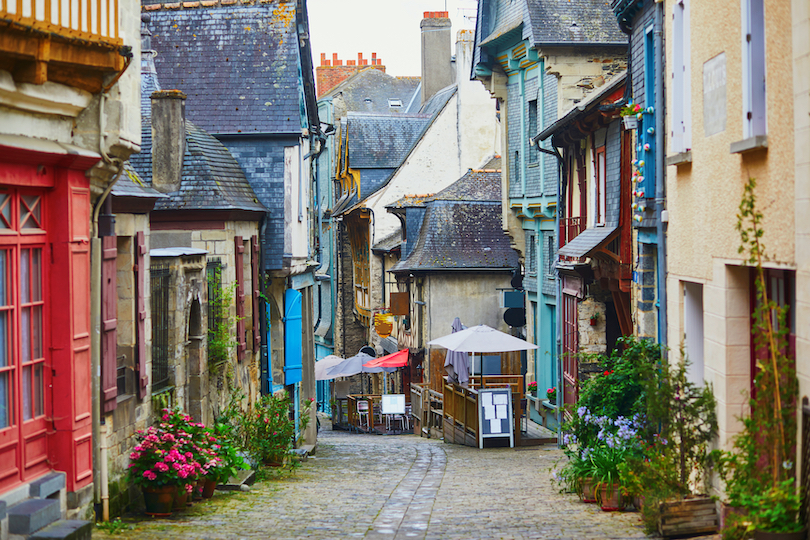
Vitré, situated on the Vilaine River’s left bank, is one of our favorite towns in Brittany because of its medieval structures that remain in remarkable condition.
Its narrow streets are lined with houses made of half-timber, creating a charming old-world feel that we find intoxicating. The most beautiful of these streets is Rue de la Baudrairie, where many ‘baudroyeurs’ (aka saddlers) used to operate.
Elsewhere, the Château de Vitré, perched on a rugged tor, is a testament to the town’s feudal past. Fortified with multiple towers, the castle was constructed in the 11th century and expanded around the time of the Middle Ages. Today, it is a museum of history and art, displaying works from the 1500s to the 1900s, gilded reliquaries, and an apothecary shop that dates back to the 1700s.
Just outside of Vitré, the 15th-century Château des Rochers Sévigné is a distinguished manor house set in extensive parkland. Once the residence of Madame de Sévignéof, a noted epistoler, it is open for guide-led tours. It also has a collection in its museum that provides a fascinating insight into her life.
16. Fougeres
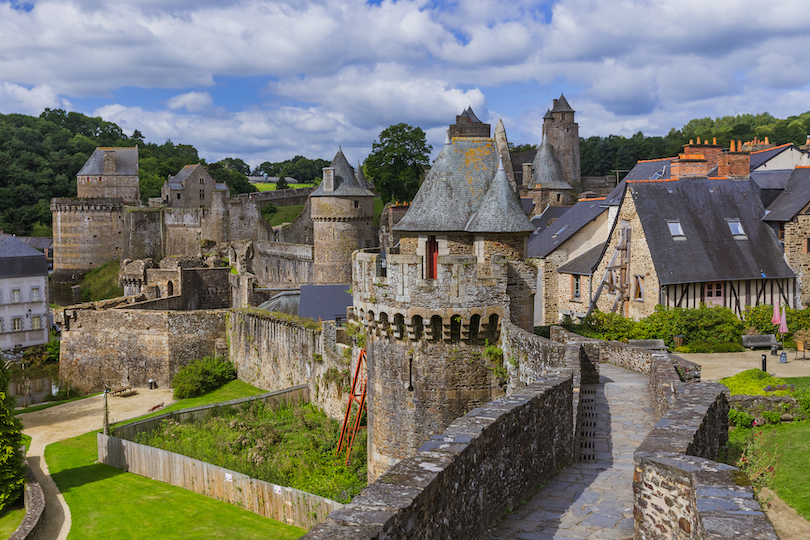
Fougères, a charming town 50 km northeast of Rennes, offers a perfect example of Brittany’s rich medieval heritage.
Presiding over the town is the Château de Fougères, a fairy-tale castle built between the 12th and 15th centuries that transports visitors back to the feudal era. The château is notable for the 13 towers accompanying its fortification circuit, which you will want to take many photos of. It also presents reenactments and spectacles that colorfully bring the medieval period to life.
Enclosed by quaint half-timbered houses and lively outdoor cafés and restaurants, the walled old town is also captivating. There you will find the Eglise Saint-Sulpice, a Gothic church with a Flamboyant Gothic interior, while the Hôtel de Ville (Town Hall), which dates from the 14th century, is also worth a visit. The Musée Emmanuel de la Villéon, housed in one of those half-timbered houses, displays the works of the Impressionist painter born in Fougères.
Uniquely, the town also boasts the Musée des Métiers de la Chaussure, a shoe museum housed in a century-old shoe factory. Emelda Marcos, eat your heart out.
15. Pont-Aven
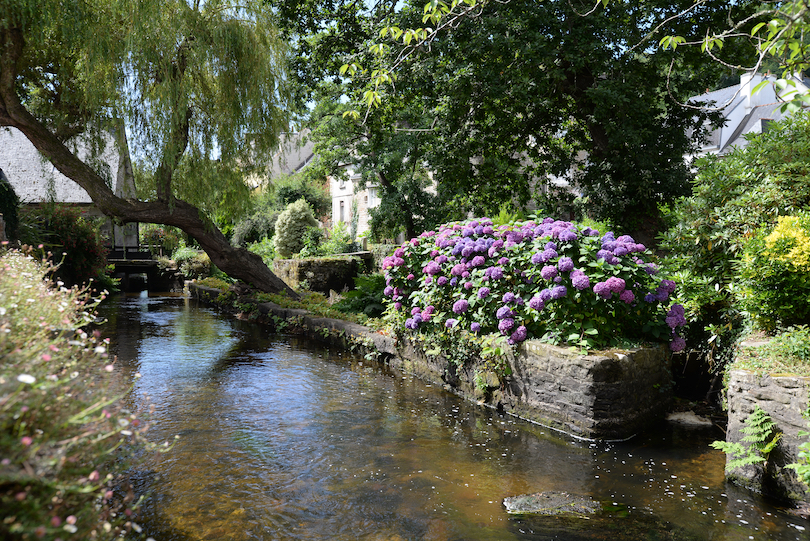
If you are into art, you will want to visit Pont-Aven, a charming artists’ community about 15 km east of Concarneau.
Taking its name from the scenic river that runs through it, the village is best known for its association with post-Impressionist painter Paul Gauguin and the Pont-Aven art movement.
You’ll get an excellent feel for this at The Musée de Pont-Aven, which displays many paintings by artists from the famous Ecole de Pont-Aven. However, for those interested in physically seeing the scenes that inspired their great artworks, a Painters’ Trail map is available at the tourist office. That will direct you to where to go.
Pont-Aven is a lovely place to visit any time of the year, but early August is perfect because of the Fête des Fleurs d’Ajonc (The Gorse Flowers Festival). During this summer festival, townspeople dress in old-fashioned regional costumes while the streets come alive with traditional Breton dancing and bagpipe music.
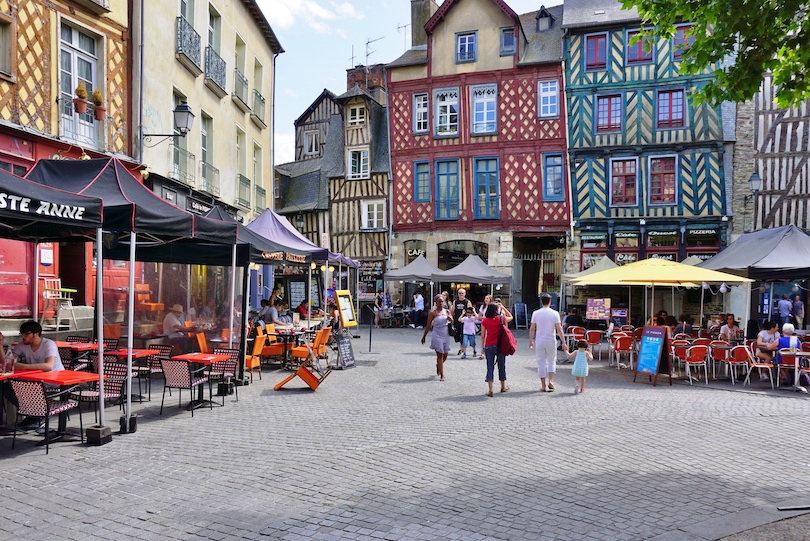
Once the capital of Brittany, Rennes is now a vibrant university town and a hub for the region’s economy and culture.
While it has a history of destruction and rebuilding, it has emerged as a modern city, with streets laid out at right angles that are perfect for walking.
Check out the Place de la Mairie, where visitors can admire the iconic 18th-century Hôtel de Ville. Similarly, Eglise Saint-Sauveur, a stunning church built in the 17th & 18th centuries, is worth visiting. So is the grandiose Place du Parlement de Bretagne, which houses the Court of Appeal.
Another notable spot is the Romanesque abbey church of Notre Dame en Saint-Melaine, a few blocks northeast. It features a lavishly sculpted facade and an ornately embellished cloister that will intrigue you with its meticulous detail.
13. Cancale
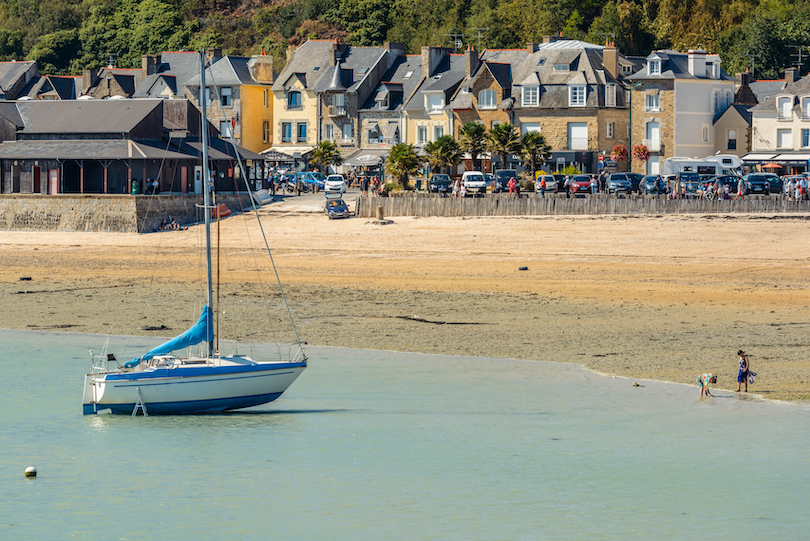
If you love seafood, you’ll want to visit the small fishing village of Cancale, on the Bay of Saint-Michel.
A seafood lover’s paradise, visitors can enjoy the day’s fresh catch at one of the many restaurants located at La Houle Port. For an immersive oyster experience, you should head to La Ferme Marine de Cancale, a working farm with guided tours.
The town also has a rich history, which visitors can learn more about at the Musée des Arts et Traditions Populaires. Housed within the Eglise Saint-Méen, an 18th-century church, it has fascinating exhibits about Cancale’s fishing and seafaring history and a collection of traditional costumes and locally made craftworks.
For those who want to experience its breathtaking natural beauty, take a refreshing walk along the coastline on the Sentier des Douaniers. It offers stunning views of the dramatic cliffs and beaches that will break you out in goosebumps.

12. Côte de Granit Rose
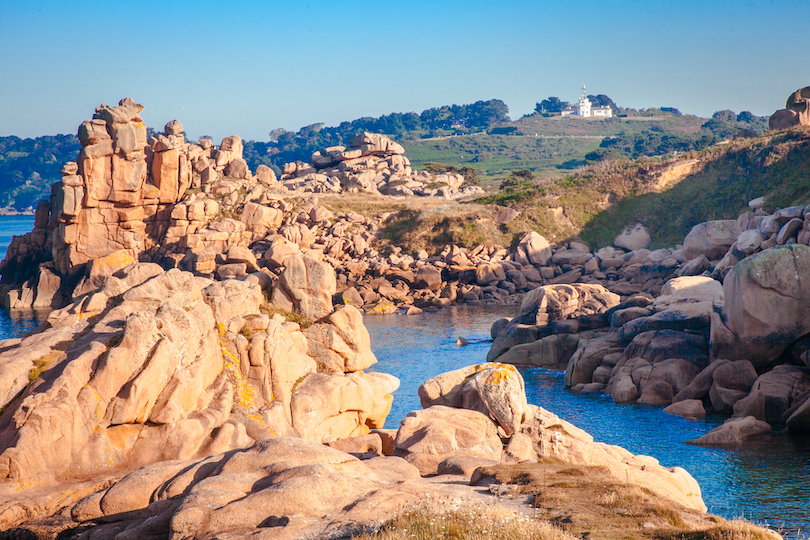
The Côte de Granit Rose is one of Brittany’s most picturesque areas.
Translating in English as ‘The Pink Granite Coast’, it stretches between Perros-Guirec and the port of Ploumanac’h. It is best known for its imposing rock formations – the Rochers de Ploumanac’h – which resemble recognizable figures such as Napoleon’s hat and a rabbit.
One of the best ways to see the coast is by hiking along a section of the spectacular Sentier des Douaniers. We spent a wonderful couple of hours taking in the beautiful views of the pink granite landscape and turquoise waters as we did it. We also spent quality time on a warm, sunny day at the Plage Saint-Guirec, a sandy sheltered beach perfect for swimming.
If you are into bird-watching, you can also take a boat trip from Perros-Guirec to Brittany’s largest bird sanctuary, which resides on the Sept-Îles archipelago.
11. Ile de Brehat
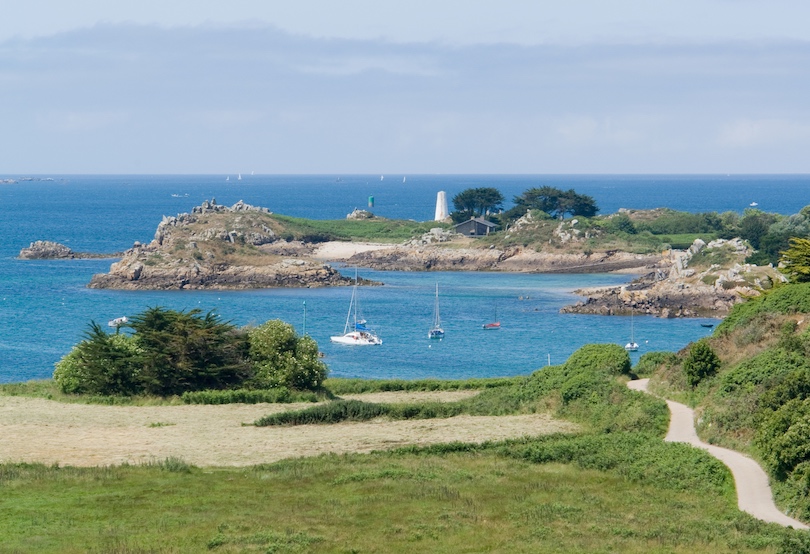
When you need a change of pace or scene during your visit to Brittany, Île de Bréhat is an ideal destination.
A small, car-free island measuring only 3,5 km in length, it boasts incredible natural beauty, mild weather, and serene surroundings.
During your time there, you can explore its multiple trails on foot or by bicycle. Taking in views of the striking red granite cliffs and vibrant wildflowers as you do so.
To get there, you can take a ferry from Pointe de l’Arcouest in Ploubazlanec, which offers a scenic 10-minute transit with plenty of opportunities to record an Instagram reel. The village there also offers a charming range of cafés, restaurants, and hotels, which enable you to stay a night or two.
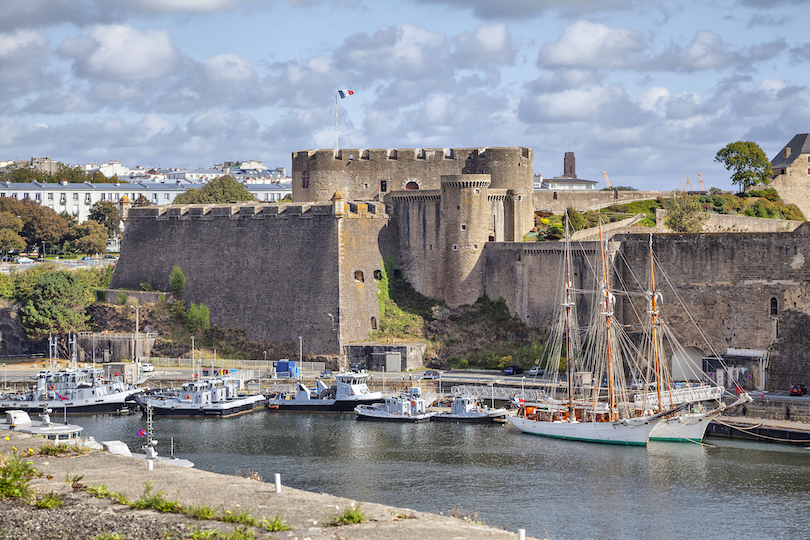
Brest is a vibrant port city in the Finistère region of Brittany, with much to offer visitors.
The city has several top-notch museums boasting a rich mix of history and culture. They include the National Maritime Museum, where you can learn about Brest’s naval past, and Musée des Beaux-Arts, which houses Italian and French old masters and more modern art.
It also features landmarks like the striking Pont de l’Iroise bridge and the Tour Tanguy, a medieval tower now serving as a museum. At the same time, nature lovers should enjoy exploring the Océanopolis aquarium and the nearby Parc Naturel Régional d’Armorique. While Brest also has a lively restaurant and nightlife scene for those wanting to paint the town red.
9. Concarneau
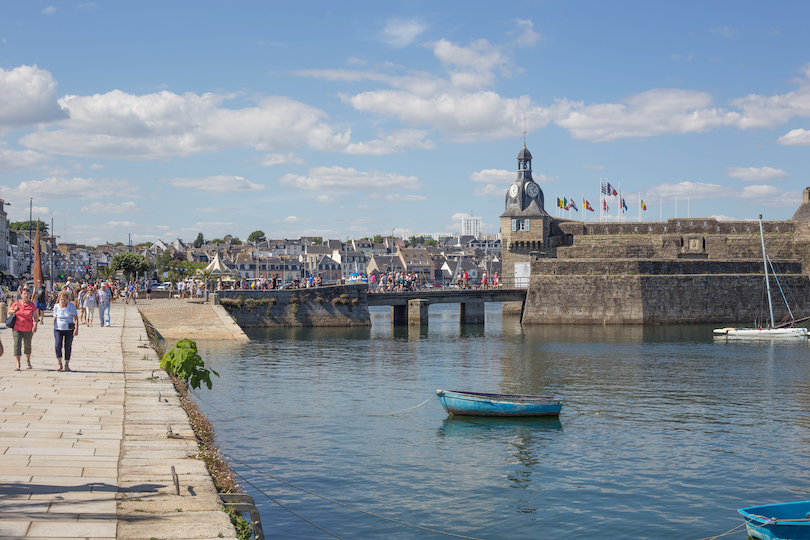
Sitting at the Moros River’s mouth, the town of Concarneau is the third-largest of France’s fishing ports. It is known for its historic fortified ‘ville close’, enclosed entirely by sturdy towers and walls of granite dating back to the 14th century.
If you choose to visit there, you can immerse yourself in its medieval ambience. The best way to do this is by strolling through its narrow, old-world which features houses displaying vibrant geraniums and historic stone buildings.
The city also has plenty of exciting shops and buzzy cafes and restaurants. Additionally, it has some lovely sandy beaches, including the family-friendly Plage des Sables Blancs and Plages de la Corniche to spend time at.
For those who want a fix of culture, the Musée de la Pêche displays a host of fishing-related exhibits. It also has a documentation center showcasing publications, books, and other materials about fisheries and general maritime activities.
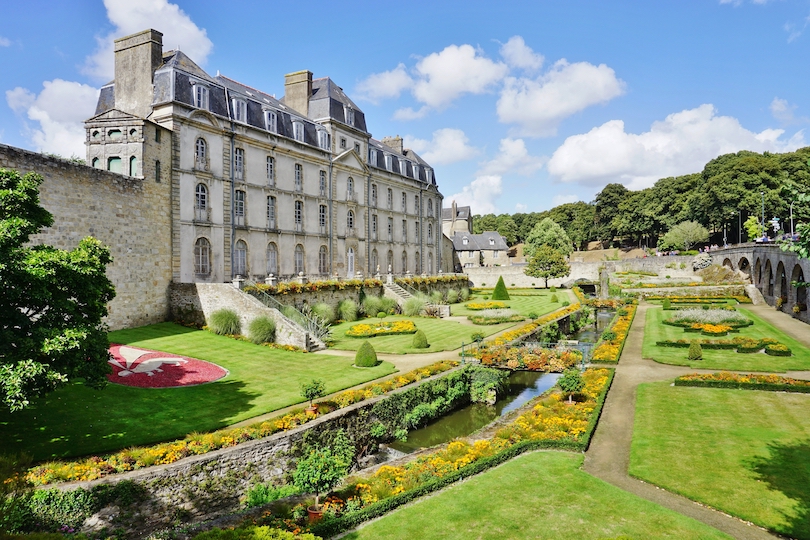
The charming town of Vannes is roughly halfway between Nantes and Brest in the Gulf of Morbihan.
It is worth visiting here to see its historic old town, nestled within ancient walls and centered around the Cathédrale Saint-Pierre.
The cathedral is an impressive structure that dates back to the 13th century, boasting a gorgeous rotunda-shaped chapel in the Italian Renaissance style. Inside are breathtaking 17th-century tapestries and a spectacular treasury.
You will also get an exceptional view of the cathedral and the surrounding area from the Promenade de la Garenne. While the Musée d’Histoire et d’Archéologie is worth popping in to as well.
Housed within the 15th-century Château Gaillard, the museum there showcases the heritage of Vannes through an extensive collection of archaeological finds, paintings, and objets d’art.
7. Belle Ile En Mer
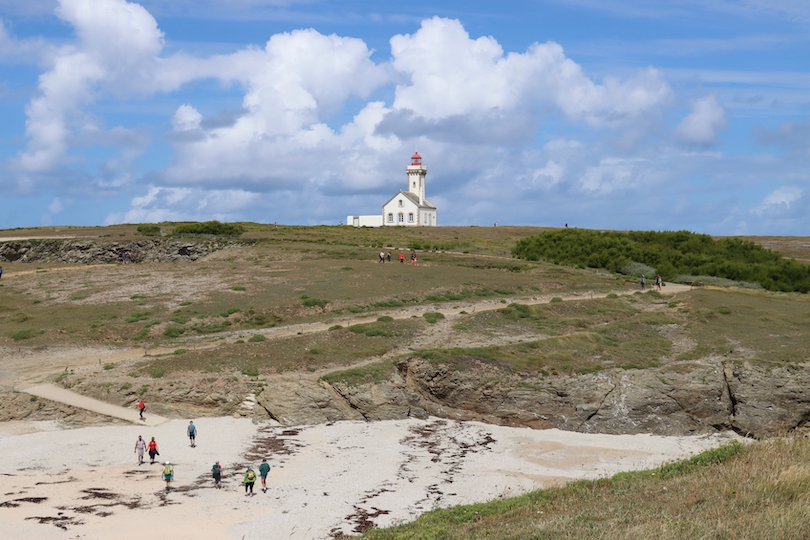
Belle-Île-en-Mer is a stunning natural paradise on Quiberon Bay in southwest Brittany.
The largest of the Breton islands is known for its magnificent coastline and quaint villages, making it a terrific destination for those wanting a quiet and relaxing getaway.
Tourists can reach Belle-Île-en-Mer through a 45-minute ferry boat ride from Quiberon or a private taxi boat ride during the high season.
Once there, you can wander around the island’s main town of Le Palais, which bustles with restaurants, hotels, art galleries, and artisans’ workshops. Overall, it is a pleasant place to explore, shop and taste lovely local cuisine.
Several beautiful beaches, including Plage des Grands Sables, are also on the island. Many of which are perfect for swimming, sunbathing, and watersports.
6. Locronan
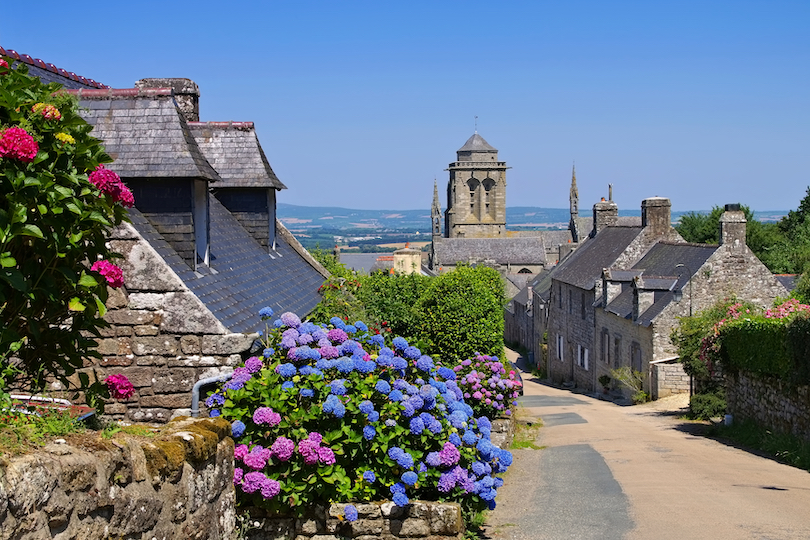
Located in the scenic Finistère region of Brittany, Locronan is one of France’s more alluring towns. Rich in character, it boasts stately Renaissance homes and a stunning church that dates to the 15th century, transporting visitors back in time.
The town is best known for the ‘troménie’, which might take the form of Breton pardons or a pilgrimage festival. On a six-yearly basis, it hosts the Grande Troménie, a spectacular 11-km religious procession where thousands of people walk together in prayer.
If your visit doesn’t coincide with that, it is worth coming to Locronan to visit the nearby Chapelle Sainte-Anne-la-Palud, another pilgrimage destination. It has a striking granite painted statue that honors Saint Anne, who was tragically executed back in 1548.
For those not interested in religious sites, the well-sheltered sandy beach near Sainte-Anne-la-Palud is the perfect place to enjoy breathtaking sunsets.
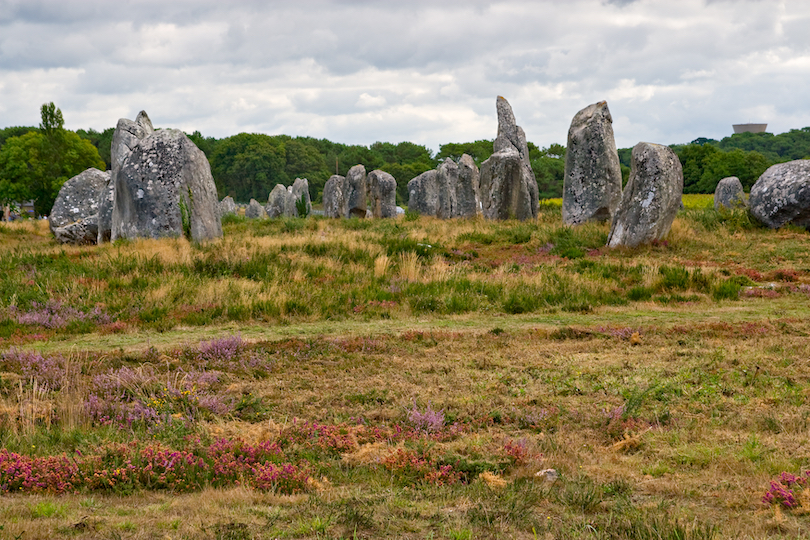
Predating Stonehenge, the Egyptian Pyramids and Knossos, Carnac is a popular destination for those interested in Neolithic sites.
Its main highlight is the ‘Circuit des Alignements’, which incorporates standing circles and rows of stones reaching up to six meters in height. Additionally, the Tumulus Saint-Michel is a remarkable megalithic monument crowned by a small chapel.
The town’s name comes from the Celtic word ‘carn’, meaning a stone monument. Whilst there, visitors can go on a self-guided or guided tour of these landmarks and visit the famous Musée de Préhistoire. One of Europe’s top prehistoric museums, it displays objects discovered at local archaeological sites dating back to 450,000 BC.
4. Rochefort-en-Terre
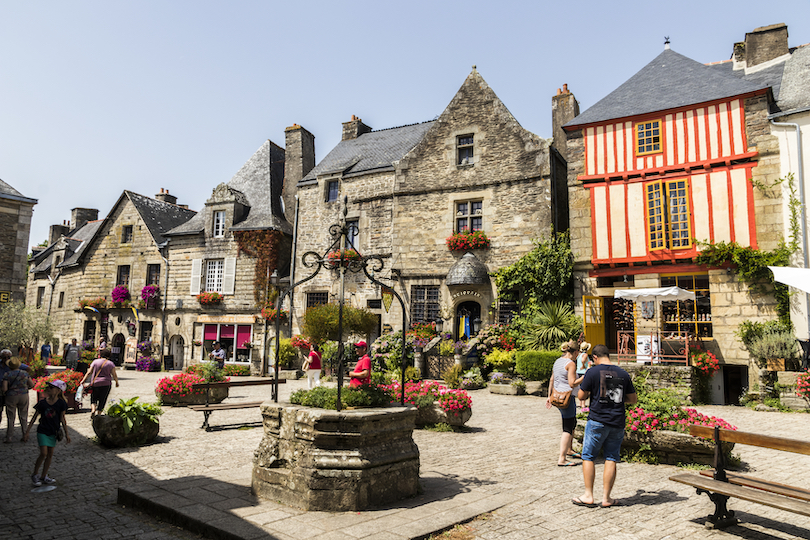
Rochefort-en-Terre, located just 30 kilometers from Vannes, is a picturesque village that ranks as one of the most beautiful in France.
Known for its colourful and vibrant floral displays, the town’s narrow streets are resplendent with potted flowers and geraniums that create an air of sophistication and charm. The town also features several artists’ ateliers and delightful half-timbered and old stone houses worth exploring.
One of its main highlights is the 17th-century Château de Rochefort-en-Terre. Originally a horse stable, the château was renovated by American painter Alfred Klotz in the early 20th century. Unfortunately, the castle’s interior is not open to visitors. However, as it is surrounded by a leafy park which you can freely wander through, you can admire its impressive exterior.
3. Saint-Malo
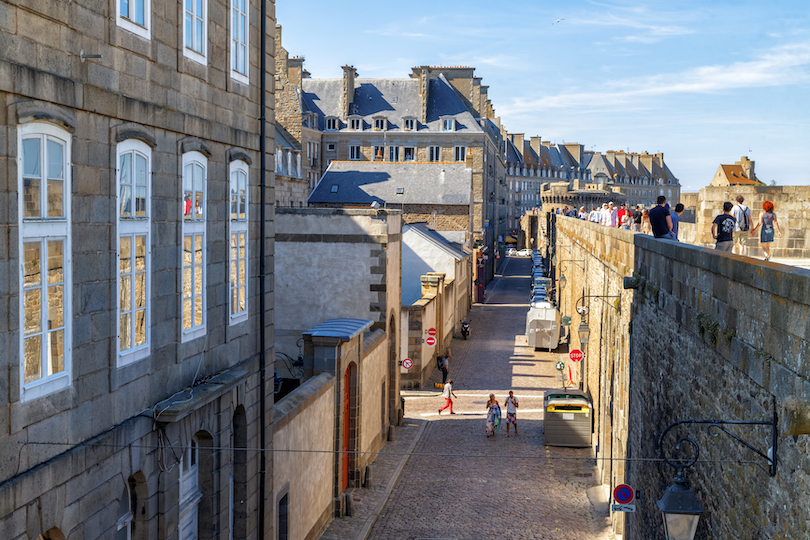
Saint-Malo is a remarkable Breton port that was once an island near the mainland.
Built as a citadel, the city is renowned for its well-preserved medieval fortifications that give it a unique character. Although its historic center was largely destroyed during World War II, the old walls, the 14th- and 15th-century Château de Saint-Malo, and the 12th-century Cathédrale Saint-Vincent survived the bombing.
The city was later rebuilt in its original style, with granite houses that look ancient and atmospheric old cobblestone streets that have survived the centuries. Visitors can explore narrow pedestrian lanes that lead to bustling public squares and side streets filled with numerous restaurants and crêperies.
On the west side of the ramparts, the Plage de Bon-Secours is a fantastic beach that has a seawater swimming pool which showcases breathtaking views of the Bay.
2. Sentier des Douaniers
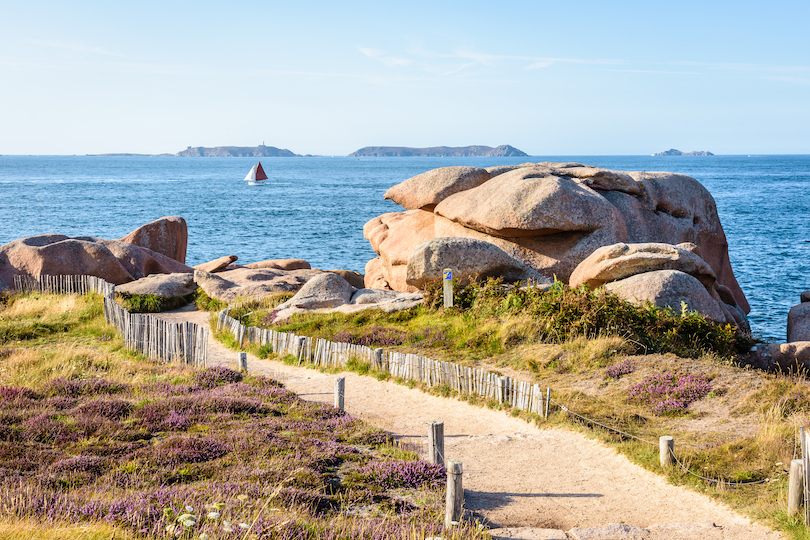
When discussing the Côte de Granit Rose, we briefly mentioned the Sentier des Douaniers as a good way of seeing the Rochers de Ploumanac’h. But there is a lot more to see on it than just that.
Also known as the Customs Officers’ Path or the GR34, the famous coastal trail runs along the entire coast of Brittany. The path follows the coastline, allowing hikers to discover various attractions, including lighthouses, forts, megalithic monuments, and picturesque fishing villages. The trail also passes through several natural reserves and protected areas, offering opportunities to see rare wildlife and unique ecosystems.
Overall, the trail is around 2,000 km long and can take anywhere from a few days to several weeks, depending on how much of it you want to explore. It is divided into several sections, each offering a different, fascinating experience, from the northern coast’s windswept cliffs to the south’s sandy beaches.
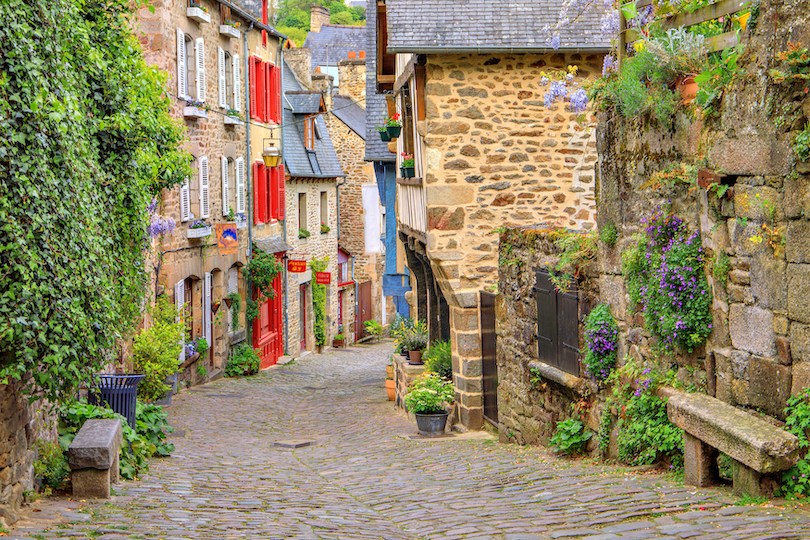
Nestled on a hill between Dinard and Saint-Malo on the left bank of the Rance River, Dinan is another stunning French town.
Notable for the ancient walls surrounding it, the settlement features a collection of late-medieval to Early Renaissance houses. It also accommodates the magnificent 14th-century Château de Dinan castle. That features a dungeon, 15th-century fortifications that were virtually impenetrable and formidable towers, highlighting the austerity of the Middle Ages.
Visitors can also attend Les Soirées there – evening events hosted in the castle, to experience the world of Jean IV, the Duke of Brittany, his knights, and servants.
The Basilique Saint-Sauveur elegantly blends various architectural styles and is another must-see attraction. You can also take a relaxing boat trip down the Rance River to Dinard or Saint-Malo to view both places from a different perspective.
Map of Things to do in Brittany, France
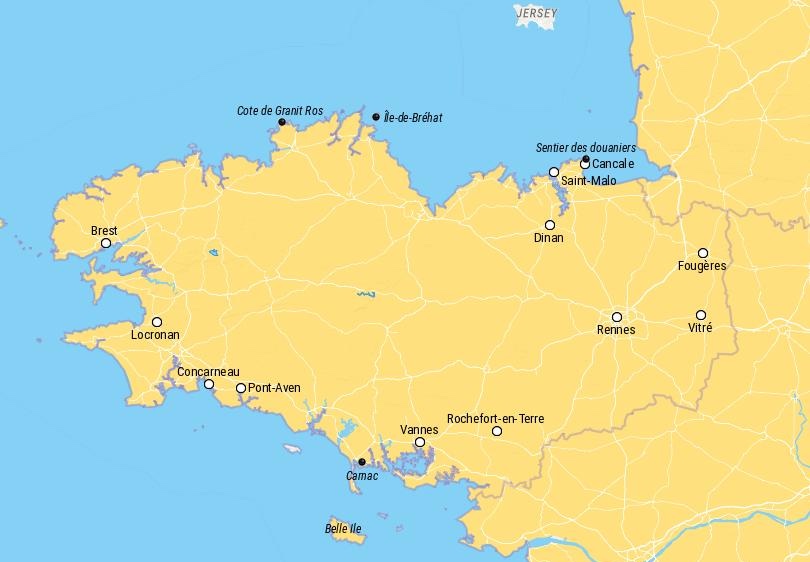
Share this post:
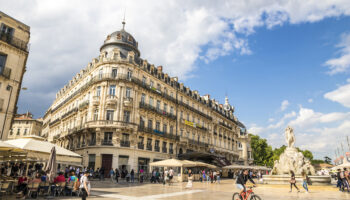
16 Best Things to do in Montpellier, France
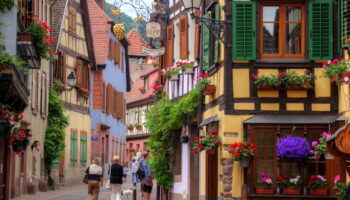
14 Most Beautiful Alsace Villages
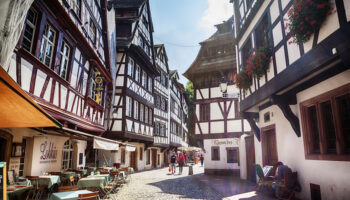
20 Top Attractions & Things to Do in Strasbourg
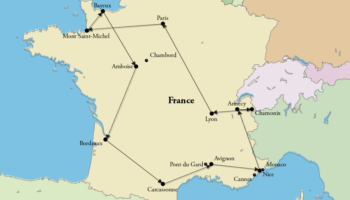
How to Spend 3 Weeks in France: DIY Itinerary
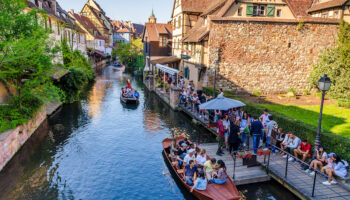
17 Best Things to do in Colmar, France
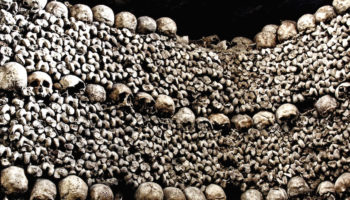
6 Spookiest Attractions In France
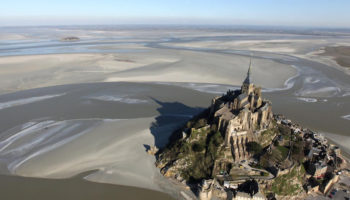
14 Beautiful Photos of Mont Saint-Michel
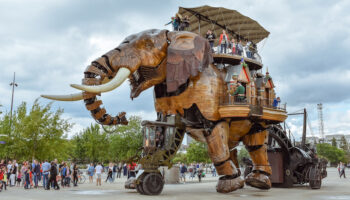
17 Best Things to do in Nantes, France

A Summer’s Day in Biarritz: 20 Fun Things to Do
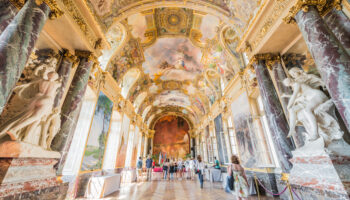
18 Best Things to Do in Toulouse, France
Reader interactions, leave a reply cancel reply.
Your email address will not be published. Required fields are marked *
This site uses Akismet to reduce spam. Learn how your comment data is processed .

Top 20 things to do in Brittany, France
- Sofía Pozuelo
- UPDATED: 04/09/2023
👩🏻⚕️ Let me remind you that it's very important to book good international insurance if you are going to a destination where you do not have medical coverage. We always use Heymondo travel insurance . You can get a 5% discount by booking it here .
A coastline stretching over hundreds of kilometers, villages that take you to the past, cities brimming with charm, and lighthouses with countless stories to tell… All of this and more awaits you in Brittany, one of the country's most mysterious and beautiful regions. There are so many things to do in Brittany, France; however, this article will focus on the top 20.
Your trip to Brittany will be enjoyable, especially for your palate. Did you know that this area is where the crêpe was invented? Isn't that itself a significant enticement?
You can try them sweet or savory (known as galettes); they are all incredibly delicious. Do you enjoy oysters? In Brittany, you'll find them in abundance. Later, I'll mention two fantastic places where you can try them.
For history enthusiasts, this trip will quickly become one of your favorites. Traveling to Brittany is like journeying to the Middle Ages, an experience you'll have when visiting its medieval villages. Furthermore, Brittany boasts a deeply rooted culture and identity. Did you know that, aside from French, Breton is also spoken here?
Table of contents
Best things to do in brittany.
Ready to discover the best places to visit in Brittany, France? Let’s get started!
1. Rochefort-en-Terre, one of the most beautiful villages

To begin our journey through the best of Brittany, let’s start with Rochefort-en-Terre. This charming little village is considered one of the most beautiful in France. It’s a must-see place on your trip to Brittany. Being a very small town (with just a few streets and hundreds of inhabitants), you can explore it in its entirety. However, don’t be fooled by its size; Rochefort-en-Terre hides many picturesque hidden gems worth photographing.
Begin visiting this town by strolling along the main avenue and exploring the streets that branch off from it. You won’t be able to help but admire the ancient houses found here. Follow the path until you reach the Place du Puits, one of the places you can’t miss in Rochefort-en-Terre. Also, be sure to visit the Notre-Dame-de-la-Tronchaye Church.
After enjoying some crêpes (the village is full of crêperies everywhere), visit the Rochefort-en-Terre Castle. It’s well worth walking through its gardens and entering the small chapel of Saint-Jean.
2. Visiting Josselin, one of the best things to do in Brittany

Another town that should not be missing from your list of best places to visit in Brittany is Josselin. This locality stands out for its impressive castle, which dates back to the 11th century when one of the counts of Rennes built the first castle. To enjoy some great views of it, I recommend strolling along the canal.
Once you are done admiring this imposing fortress, venture into the heart of the village to explore its charming streets. Don’t miss the Basilica of Our Lady of Roncier and the timber-framed houses painted in different colors located nearby.
3. Vannes, one of the most beautiful cities in Brittany

Although we didn’t spend much time in Vannes, it was enough to grasp the beauty of this French city. It’s a walled municipality with cobbled streets. The place that surprised me the most and that I highly recommend visiting is Place Henri IV, a square surrounded by vibrantly colored half-timbered houses. It’s a true gem!
Other sites in Vannes that you should not miss include the Remparts of Vannes (a fortress with medieval towers and gates) and its gardens, the Basilica Cathedral of Saint Peter, the Hermine Castle, and the Saint Vincent Gate. Be sure to take a stroll around Vannes Harbor and enjoy a drink on one of the lively streets nearby.
Around a 20-minute drive from Vannes lies the Gulf of Morbihan. Instead of having dinner in Vannes, we opted for a local seafood restaurant named Captain Marée. Situated by the gulf, you can indulge in oysters while relishing an idyllic landscape. I highly recommend it!
4. Carnac Stones: a unique place to visit in Brittany, France

A peculiar site to see in Brittany, France, is the Carnac Alignments. This is a collection of rocks of varying sizes, aligned in rows across a meadow. It is known to have been erected between the 5th and 3rd millennia BC, though the exact purpose remains unknown. Naturally, various theories have arisen regarding its significance.
These megalithic alignments constitute the world’s most extensive prehistoric monument. At the site, you will find an information center called Maison des Mégalithes, where you can learn all that is known about this monument. Admission is free.
5. The petite maison of Saint-Cado

One of the most charming places in French Brittany is the Petite Maison of Saint-Cado. To see this picturesque little house, you first need to reach the charming village of Saint-Cado, located by the Etel River. Part of the village is situated on a small islet that is connected to the mainland via the Saint Cado Bridge.
One of the most captivating spots in this village is a tiny house positioned on a small piece of land in the middle of the bay, known as the Petite Maison of Saint-Cado. It was built in 1894 and used to be the home of the oyster farm’s watchman. Can you imagine what it would be like to sleep in such a place?
During our visit here, we took the opportunity to dine at a restaurant called Les Algues Marines. The establishment, situated by the river, boasts a small terrace, allowing you to enjoy a very cozy meal. Here, we had our first moules frites of the trip. Everything was absolutely delicious!
6. Château de Keriolet, near the village of Concarneau

On the outskirts of a coastal village called Concarneau, which I also recommend visiting, you’ll find the Château of Keriolet, a 13th-century neo-Gothic castle. After passing through various owners, the current proprietors have chosen to open the castle to the public to help maintain it. The entrance fee is €7.50. We simply took a stroll around the castle’s surroundings, which can be done free of charge. It’s well worth it!
After visiting the castle, if you have the time, make your way to the center of Concarneau , a walled seaside village.
7. Locronan, the most beautiful village in Brittany

I don’t know if it’s the most beautiful village in Brittany, but it was definitely my favorite. The moment I set foot in Locronan, I felt like I was in a different era. Wandering through the cobblestone streets of this village while gazing at the ancient stone houses is undoubtedly one of the best things to do in Brittany, France. Don’t miss out on the Church of Saint-Ronan, the cemetery, and the Chapel of Notre-Dame-de-Bonne-Nouvelle.
8. Pointe du Raz
Pointe du Raz is a headland located in the Finistère department, at the westernmost tip of Brittany. Here, a series of rugged cliffs meet the Iroise Sea, gifting those who visit a picturesque natural scene. In the distance, amid small islets and waves, the Vieille Lighthouse stands perched on a rock, built in the late 19th century.
It’s a great place to watch the sunset. On clear days, you can see the island of Sein and the Ar Men Lighthouse from here.
9. Point de Dinan, a natural paradise in Brittany

One of the natural outings I enjoyed the most during my time in this French region was Point de Dinan. A series of trails wind through this headland, allowing visitors to enjoy a walk with incredible sea views, cliffs, beaches, and various rock formations, including a small natural cave. It’s possible to do a circular route. I recommend allocating about an hour for it.
10. Petit Minou Lighthouse – What to do in Brittany, France

Did you know that Brittany is filled with beautiful lighthouses? My favorite was the Petit Minou Lighthouse, built in the mid-19th century. This lighthouse stands at a height of 26 meters and is perched atop a series of rocks. It’s connected to the mainland by a charming stone bridge, offering lovely views of the surroundings. At the site, you’ll also find a fort and a spectacular beach.
11. Kermorvan Lighthouse, located in Le Conquet Village

Another lighthouse that I loved was Kermorvan Lighthouse, situated in the Breton town of Le Conquet. It stands at a height of 20 meters and was built in 1849. Perched on rocks at the tip of the Kermorvan Peninsula, it’s connected to the mainland by a granite bridge. To reach it, you’ll need to take a short hike from the parking area. It takes around 15 minutes.
12. Roscoff and the Island of Batz

Another charming Breton village is Roscoff. In the 19th century, this coastal town experienced significant economic prosperity due to maritime trade. Fabrics, salt, wood, and onions were exported to England from here. This affluence is reflected in Roscoff’s infrastructure, particularly in its stately granite houses.
Be sure to take a leisurely stroll through the narrow streets of Roscoff’s historic center. Additionally, from this town, you can catch a ferry to the island of Batz . This island is perfect for exploring by foot or bike along its coastal paths. A tranquil ambiance prevails, with breathtaking natural spots to discover. Don’t miss out on the Grève Blanche beach.
13. Pink Granite Coast, a unique landscape of Brittany, France

Another intriguing place to see in Brittany, France, is the renowned Pink Granite Coast. Along the coastline near the town of Lannion, you’ll encounter massive clusters of pink granite rocks. The most popular way to explore this area is by foot, along the customs officer’s path (GR-34). You can also visit by bicycle, or even better, venture into the water with a kayak or paddleboard.
14. Beauport Abbey, discover the ruins of this historic building

This place is not one of the most well-known places in Brittany, but I really enjoyed it. That’s why I recommend making time in your itinerary to visit Beauport Abbey, located in the municipality of Paimpol.
It’s an ancient 13th-century abbey founded by a local count, who handed over the religious building to monks to help it prosper. However, in the second half of the 18th century, it began to decline. Today, it lies in ruins, adding a touch of mysticism and mystery to this enigmatic spot.
An interesting fact about this place is that it used to be the starting point for pilgrims in Brittany heading to Santiago de Compostela.
15. Saint-Malo and its walled historic center

The walled old town of Saint-Malo is another of the most beautiful places to visit in Brittany. To begin exploring this city in the best way possible, I recommend taking a stroll along the walls of Saint-Malo. From there, you get a wonderful perspective of the facades and rooftops of the historic center and beautiful views of the sea and beaches.
Once you’ve finished walking on the walls, the best thing you can do is venture into the heart of Saint-Malo and explore as many narrow streets as you can. You can also take a walk by the harbor or, if you’re visiting during the warmer months, bathe on one of the city’s beaches.
16. Cancale: an ideal destination for eating oysters in Brittany

Cancale is a small village popular for its oyster farms, thus offering numerous restaurants and stalls to enjoy oysters. If you want to taste them or even try them for the first time, Cancale is the perfect place to do so. I recommend trying them at the Marché aux Huîtres de Cancale. The village itself is also quite charming. Even if you’re not going to partake in seafood, it’s worth a visit to take a stroll through the streets near the beach.
17. Dinan, a must-see in Brittany

After visiting several towns in Brittany, I thought no other could surprise me. It was upon arriving in Dinan that I realized how mistaken I was. This small medieval city is brimming with hidden gems, each one more beautiful and unique than the last. From the Clock Tower to Dinan Castle, passing through its 13th-century walls and picturesque half-timbered houses, Dinan awaits to astonish you at every step you take.
18. Fougères and Europe’s largest fortress

Fougères is a charming medieval village nestled on the banks of the Nançon River. What will capture your attention as you begin your visit to Fougères is its large castle, adorned with towers and walls, boasting a history of a thousand years. Don’t miss out on the Saint-Sulpice Church, the half-timbered houses, and the public garden.
19. Vitré, a town with over a thousand years of history
Eager to explore more medieval towns? If so, add Vitré to your itinerary in Brittany. This village boasts over a thousand years of history, making you feel like you’ve traveled back in time. The standout feature is the Vitré Castle, constructed in the 11th century. It played a crucial defensive role during the conflicts in Brittany. You’ll also be charmed by its half-timbered houses and ancient alleyways.
20. Rennes, the capital of Brittany (France)
Rennes, the capital of Brittany, is another genuine treasure. It serves as the cultural and economic hub of the region. It also stands out for its art, which dates back to the 1st century BC. Despite its centuries-old history, Rennes maintains a youthful atmosphere as it is a university city. Don’t miss the Palace of Parliament, Thabor Park, Saint Peter’s Cathedral, and the Rennes City Hall.
Where to stay in Brittany
Brittany is a vast region, and the distances between places are quite long. Therefore, to explore it thoroughly, you’ll need to stay in more than one location. In our case, we traveled in a camper and changed campsites every few nights. This allowed us to explore the surroundings of each spot, and during our journeys, we took advantage of the opportunity to visit places situated between our two lodgings.
Below, I provide the number of nights we spent in each location, so you can get an idea:
- Vannes surroundings: 2 nights. Search for hotels in Vannes .
- Douarnenez surroundings: 2 nights. Search for hotels in Douarnenez .
- Roscoff surroundings: 1 night. Search for hotels in Roscoff .
- Saint Malo surroundings: 3 nights. Search for hotels in Saint Malo .
Map of what to do in Brittany, France
On the following map of Brittany, I have marked all the places mentioned in this blog post. You can find them in the order they were mentioned. Additionally, I have highlighted other places to visit in Brittany that, while not included in this top 20, are also worth visiting. Feel free to add them to your itinerary through Brittany if you have enough time.
Mont Saint-Michel is one of the locations marked on the map. Although it belongs to Normandy, it’s located close to the Brittany region and is well worth a visit. It’s one of the most beautiful places to see in France.
Don’t miss my France travel guide for more information about this country.
I hope this blog post about top 20 things to do in Brittany has been very helpful in planning your trip to this beautiful region of France. If you want to share your experience or have any questions, feel free to leave a comment or email me. Until next time!
- PLAN A TRIP STEP BY STEP
↠ Book free tours and guided visits on Civitatis or GetYourGuide . I always use these platforms to check what organized activities there are at my destination.
↠ To pay with card in foreign currency or withdraw money from ATMs, I always use this card (there are free and paid plans). It works the best!
↠ Traveling with travel insurance to a destination where you don’t have healthcare coverage is a must. Get your insurance 5% cheaper with this link .
↠ If you want to have cellphone data at your destination from the moment you land and don’t want to waste time, there is nothing like this eSIM . Use the code “comeamaviaja” for a 5% discount.
↠ Check out Booking’s offers , a platform I always use, as I always find very good options thanks to its search engine with filters.
↠ For destinations where I need to rent a car, I always check Discover Cars and Auto Europe search engines. I recommend them!
↠ If you still need to buy flights for your trip, there is no better search engine than Skyscanner (although I always recommend booking the flight on the company’s website).
RELATED POSTS

Leave a Reply Cancel reply
Your email address will not be published. Required fields are marked *
Save my name, email, and website in this browser for the next time I comment.
- Trip Advisor

Xavier Foucrier CC0
The Best Places to Visit in Brittany

Brittany in western France has so much to offer visitors who want to explore thousands of years of history, see stunning coastal landscapes, and discover beautiful little islands. Whether you want to relax on a golden sandy beach, visit ancient ruins and medieval villages, or go cycling alongside the sea, we will help you experience the best of Brittany!
We have traveled extensively through Brittany, so we’re very happy to share our favorite places of interest with you.
If you’d like to find out more about how we can help you plan your trip to Brittany, we invite you to take a look at some of our self-drive tours of Brittany .
Saint-Malo
Saint Malo in Brittany is a port city that has a rich history and has one of the nicest beaches in France. The town is popular with travelers who enjoyed the book 'All the light we cannot see' by Anthony Doerr, which was set in St Malo in World War II. If you're on a tour with France Just For You, we can plan a self-guided walking tour of St Malo for you which takes you to the places featured in the book.
The cobbled streets of this walled citadel are steeped in history, as are the high granite city walls that enclose the old town. In World War II, the town was under siege by the Germans, and going further back, it was occupied by privateers (pirates approved by the king). It is worth simply strolling around the old town and enjoying its charm.
Then you can make your way to Plage du Môle, one of the best sandy beaches on the Emerald Coast (Côte d'Emeraude in French). Situated on the English channel, this beach is great for swimming and doesn't get too windy. The summer lifeguard station means it's safe and popular with families. And for lunch, try some Breton delicacies like oysters and crepes - these are served in many of Saint Malo's restaurants and markets.
You can combine Saint Malo with a trip to Mont Saint Michel Abbey, which is less than an hour’s drive away in Normandy.
Find out more about St Malo in our blog post on How to Spend a Day in St Malo .

Pixabay CC0
Cancale
Enjoy more of the Emerald Coast as you drive between Saint Malo and Cancale, a lovely little port in the northeast of Brittany famous for its oysters.
Cancale oysters have been famous since Roman times, popular among the soldiers of Julius Caesar, and with King Louis XIV much later. Cancale is officially a 'Site remaquable du goût' (a place of exceptional taste!) due to the exceptional flavor of its oysters.
If you head to the pier from the town's harbor, you can see 4.5 square miles of oyster beds. There are a few oyster stalls on the seafront, and there are also various restaurants in town where you can try the famous 'oversized' oysters.
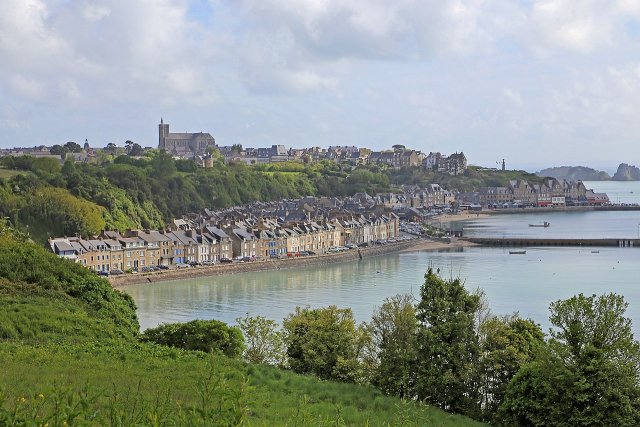
W. Bulach CC-BY-SA 4.0
Dinan is a lovely medieval town above the Rance river. Like Saint Malo, the town is surrounded by city walls and has some interesting architecture. This ranges from medieval to early Renaissance buildings and half-timbered houses on the Rue du Jerzual, to the impressive Château de Dinan, with its dungeon, fortifications and towers dating back to the 14th and 15th centuries.
We also recommend visiting the Saint-Sauveur Basiliica, which shows an interesting blend of different architectural styles. You can enjoy panoramic views of the town from the Clock Tower. And those interested in trains may enjoy a visit to the Railway Museum, which has model railways, signal boxes and posters.
It’s also possible to take a boat trip along the Rance river to Saint-Malo - very nice when the weather’s fine.
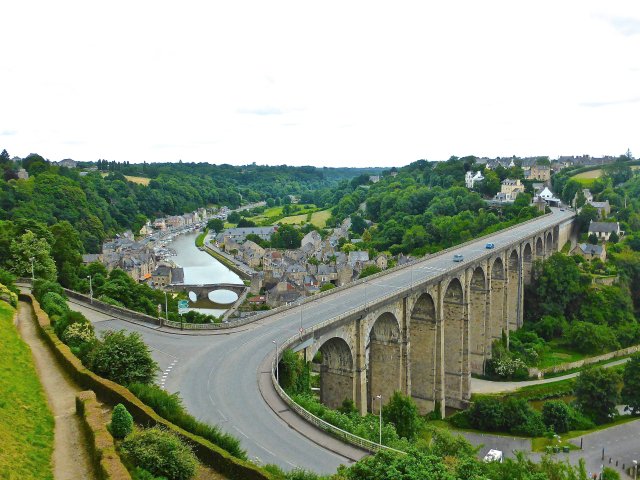
The old town of Vannes is between Nantes and Brest by the Gulf of Morbihan. This historic walled town surrounds the 13th-century, Italian Renaissance-style Saint Pierre Cathedral. Inside the cathedral, there are some beautiful 17th-century tapestries.
There's a nice view of the cathedral and the Constable Tower from the Parc de la Garenne. The medieval gates, towers and fortifications were built between the 3rd and 17th centuries. You can learn more about the heritage of Vannes at the Musée d'Histoire et d'Archéologie in the center of the old town. It is housed in Chateau Gaillard and its collections include paintings and archeological artefacts.
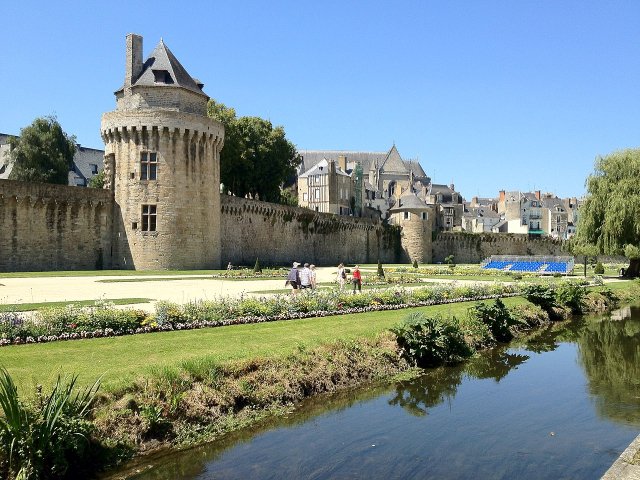
mphb45 CC-BY 3.0
Île-aux-Moines, Morbihan
The Gulf of Morbihan is a pretty, protected bay in southern Brittany filled with gorgeous little islands with beautiful scenery. One of the largest islands is the Île aux Moines - you can take a day-trip there by boat from Port Blanc. The crossing only takes a few minutes. The island is around 3.5 miles long and nearly 2 miles wide, with a population of about 600 people - though the island is very busy in the summer.
It's a lovely place to spend a day exploring the countryside, relaxing on the beach or strolling along the streets in the north of the island, admiring the traditional Breton houses. There is a coastal path where you can go for a walk or hire a bike by the port and go cycling.
There are also some interesting neolithic sites, including 'cromlech de Kergonan', a series of 24 stones in the center of the island, and the dolmen at Pen Hap in the south.
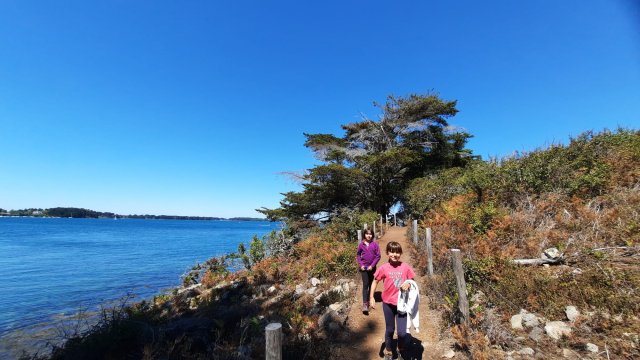
France Just For You
The word Carnac comes from the Celtic word ‘carn’, which means ‘stone monument’. It’s on Quiberon Bay and has some fantastic Neolithic sites. These include the "Circuit des Alignements", consisting of circles and rows of stones up to 20 feet high, and a small chapel that sits on top of the Tumulus Saint-Michel monument.
The Musée de Préhistoire is an exceptional museum on prehistory in Carnac - one of the best in Europe. You’ll find archeological objects that have been uncovered at sites in this area. The collection shows the evolution of humans from 450,000 BC, covering the Stone Age, the Neolithic period, up to the Gallo-Roman epoch, which ended in the 5th century AD.
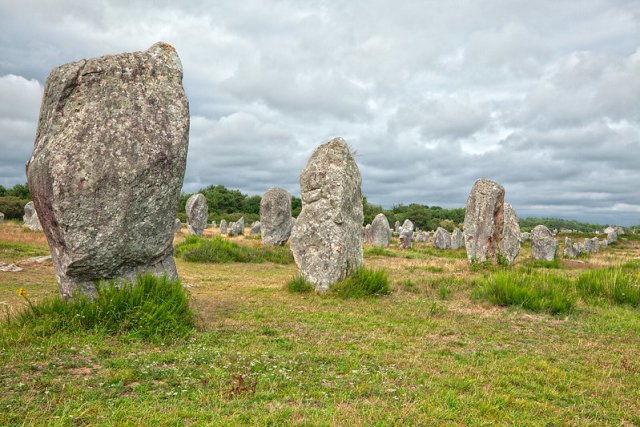
Nicolas Raymond, Flickr, CC-BY 2.0
Côte de Granit Rose
The beautiful Pink Granite Coast runs from Perros-Guirec to the natural harbor town of Ploumanac'h.
It has stunning weather-beaten rock formations, some higher than 60ft, known as the Rochers de Ploumanac'h. You can see these between Trestraou and Saint-Guirec. Some of them resemble familiar shapes, such as a rabbit, a witch and even Napoleon’s hat.
There’s a nice 5-mile hiking trail, the Sentier des Douaniers, which has marvellous views of the rocks at Ploumanac'h and of the pink granite coast. It goes along the coast, crosses the moors and ends at Ploumanac'h port.
Also along the Sentier des Douaniers is the sandy Saint-Guirec beach, ideal for swimming as the sea here is calm.
For more sandy beaches and watersports, you can visit a family resort that’s popular with the locals, at Perros-Guirec.
The old town of Trébeurden, also on the coast, is worth a visit for its handicrafts shops, traditional Breton farmers market, and excellent gourmet restaurants. Try one of the region’s specialties, buckwheat pancakes, at one of the local crêperies. There are also plenty of seafood restaurants to choose from, and a Michelin-star restaurant, Manoir de Lan-Kerellec.
Plougrescant also has some magnificent coastal rocky landscapes - l ook out for the Maison entre deux Rochers (the House between Two Rocks)!
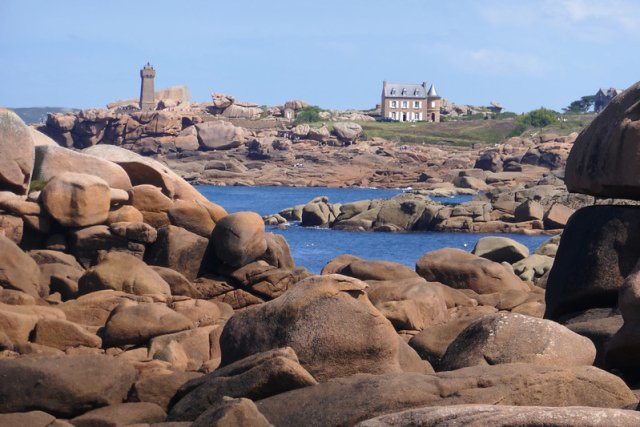
Jeanne Menjoulet CC-BY 2.0
Pont-Aven is a famous village in the Finistère department of Brittany known for its artists and its biscuits! Its name comes from the river that runs through it. It is most well-known for its association with post-Impressionist French painter Paul Gauguin , who arrived there in 1886. There he established the 'Ecole de Pont-Aven', a new style of painting.
The Museum of Pont-Aven has many paintings on display by artists who adopted the Ecole de Pont-Aven style. If you come on a tour with France Just For You, we'll suggest a self-guided walking tour route which will take you in Gauguin's footsteps and show you some of the sites that he portrayed in his paintings. Alternatively, you can go to the town's tourist office and pick up a map which marks the Painter's Trail.
If you're in Brittany in early August, try to be in Pont-Aven for the Fête des Fleurs d'Ajonc (Festival of Gorse Flowers). It's an ideal opportunity to see the locals dressed in traditional Breton clothes, listen to Breton bagpipe music and see (and maybe learn!) a traditional Breton dance.
As for the famous buttery biscuits (known as Galettes de Pont-Aven), you can buy some and experience their unique flavor at one of the local biscuit shops.
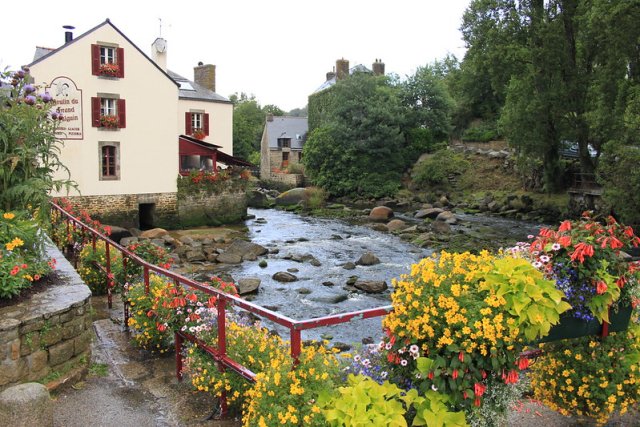
Mike Finn, Flickr , CC-BY 2.0
Locronan is the only village in the Finistère region that features in the list of ' the most beautiful villages in France '. Locronan is a beautiful, charming, well-preserved town. It has been named as a "Petite Cité de Caractère" (Small City of Character) because of its impressive Renaissance houses and magnificent church dating back to the 1400s. Most of the houses in the town were built using local granite and have traditional slate roofs.
The attractive cobble-stone Place de l'Eglise is a good starting point to explore the village. It's surrounded by ancient buildings, including a vaulted church, and has an ancient well in the center.
There are a few small shops and cafes around the square. From here it is easy to explore the rest of centre of the village as streets depart in all directions: to the left of the church follow the loop formed by Rue des Charrettes and Rue du Four and opposite stroll along the narrow road called Venelle Toul Prichen.
Locronan tourist office has a suggested route for you to follow as you explore the village. Or if you're on on a self drive tour of Brittany with us, we'll make sure you know all the must-sees.
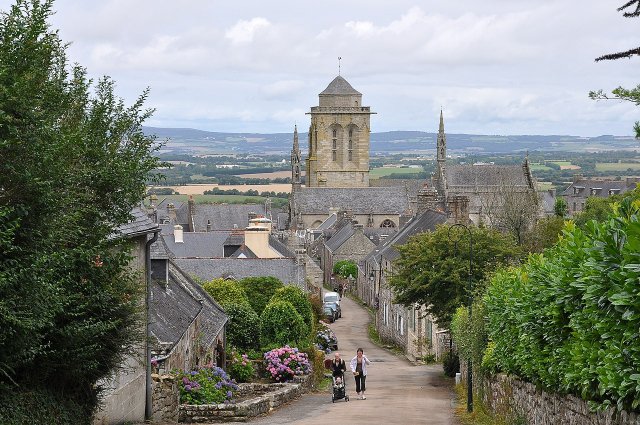
Moonik , CC-BY SA 3.0
This is a good rest stop if you’re driving between Mont Saint Michel and the Loire Valley .
Fougères is in a beautiful location, surrounded by lush forests and fields. Its main attraction is the Château de Fougères, a fortress with thirteen towers, built between the 12th-15th centuries.
If you visit the castle, expect to be immersed in spectacles representing life in the region during the Middle Ages.
You’ll also notice a quaint, medieval ambiance in the walled old town, with its half-timbered houses near the Place du Marchix.
Other places of interest include Saint-Sulpice church, with its stunning Gothic interior, the Town Hall (Hôtel de Ville) that dates back to the 14th century and the Shoe Museum, which was once a shoe factory.
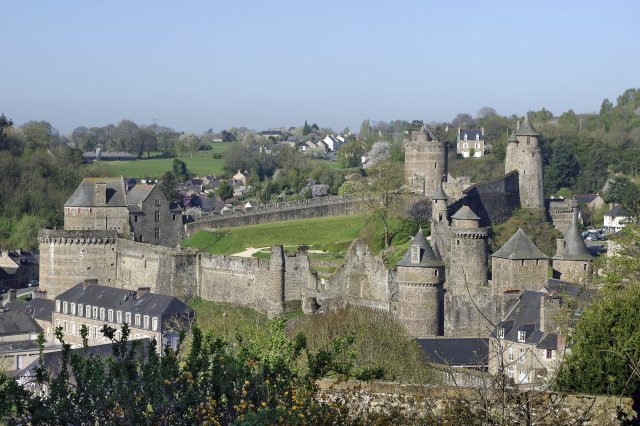
Daniel Jolivet, Flickr CC-BY 2.0
Rochefort-en-Terre
This off-the-beaten-path village in Morbihan department has been named a ‘Petite Cité de Caractère’ (Small City of Character) one of the "Plus Beaux Villages" (Most Beautiful Villages in France) and a " Village Fleuris " ("Village in Bloom" or "Flowery Village") because of the pretty flowers you’ll see around the town.
Enjoy a stroll around the village's charming streets and discover old stone and half-timbered houses adorned with flowers, and local artist workshops.
The Château de Rochefort-en-Terre is surrounded by a park and resembles medieval castle. But actually, it only dates back to the 17th century, when it was used as a horse stables, and was restored in the 20th century. American painter Alfred Klotz bought the castle in 1907 and spent a fortune on the renovations. You can't go inside the château, but you can admire the outside while walking through the park.
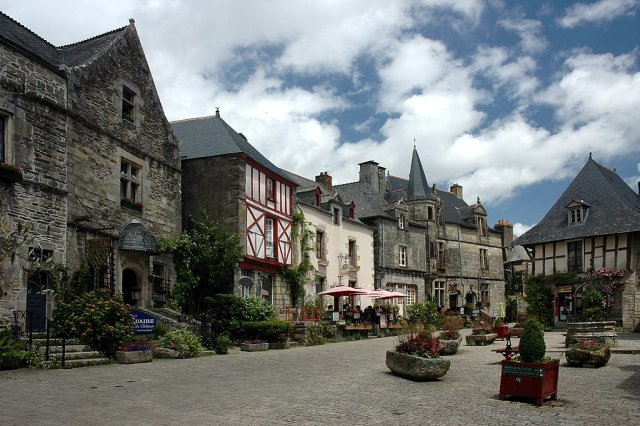
Calips , CC-BY SA 3.0
La Vallée des Saints
La Vallée des Saints is a project that aims to create 1,000 statues of Breton saints sculpted from granite from the Armorican peninsula.
Armorica was the name given to this area (now Brittany) during ancient times. It means "place in front of the sea" in Gaulish, the ancient Celtic language spoken in this region at the time. The hundreds of statues at the Quénéquillec site at Carnoët represent the Christian evangelisation of ancient Armorica.
They're also a reflection of the faith of the Breton people. The main aim of La Vallée des Saints is to pass on the values that the locals hold dear. It's an unusual and fascinating place to visit!

The Pleyben Parish close (Enclos paroissial de Pleyben) is a cathedral complex in Pleyben. It includes the Saint-Germain church, a funeral chapel, a triumphal arch, and the calvary.
The building has two impressive bell towers, one known as the Saint Germain, built in the Renaissance style with a domed lantern at the top, and the other with a spire in the Gothic style. You can find out more about Pleyben Parish close here .
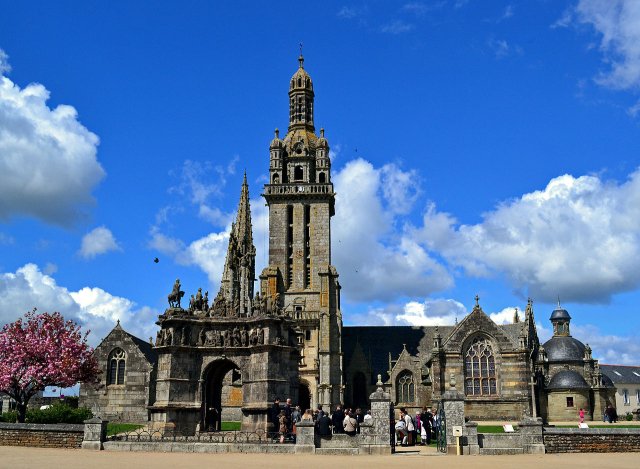
Kergourlay , CC-BY SA 3.0
La Presqu'île de Crozon
The Crozon Peninsula is right at the tip of the middle of Brittany. The sea here is very clear with some of the best beaches in Brittany . We recommend a visit to the gorgeous Landevennec Abbey , where you’ll see the ruins of a medieval Benedictine monastery and a beautiful sea backdrop.
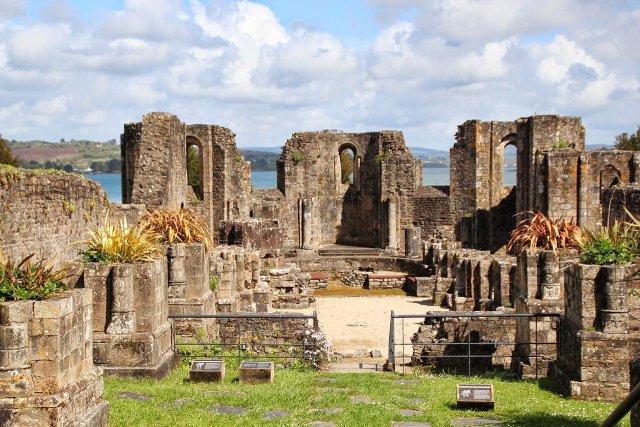
LeNanou , CC-BY SA 4.0
If you have time...
Dinard
We don’t include Dinard in our self-drive itineraries, but it has a nice port and it’s good for luxury shopping.
Roscoff
Roscoff is a nice place to explore if you’re arriving in Brittany by ferry from Plymouth, UK or Cork, Ireland. It has a very nice harbor, interesting historic houses that belonged to shopowners in the past, and a beautiful Gothic church.
Île de Batz
In the summer, there are regular ferries from Roscoff to the Île de Batz. It's a nice island to visit if you're staying in the Roscoff region, with sandy beaches, pretty seaside scenery, and an exotic garden. We don't typically include Roscoff and Île de Batz in our itineraries as it's very far out of the way if you then want to visit other parts of France. If you want to explore Brittany's islands, we prefer Ile aux Moines in the Morbihan Gulf or Ile de Bréhat, which are both easy to visit in a day from the mainland.
If you would like to explore Brittany by car , we would love to help you plan your trip! Just send us your France wishlist , and we'll be in touch!
Experts in self-drive tours in France
- How it works
Ready to explore?
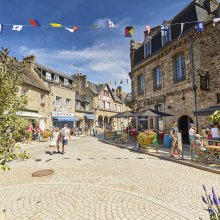
Alexandre Lamoureux - CRT Bretagne
The Best of Brittany Tour in 13 days

Marc Schaffner - Morbihan Tourisme
Normandy, Brittany & the Loire Valley Tour in 16 days
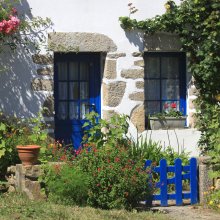
Slow Travel to Normandy, Brittany & Paris in 26 days
French regions.
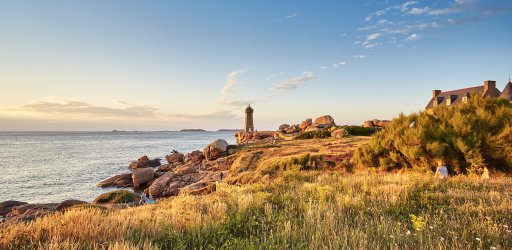
Travelers Reviews
The team created an amazing trip. We gave them the nick name “travel fairies” All was just magical.
Emilie was a great help in planning our trip and the accommodations and recommendations were excellent and well thought out. Unless you speak French and know the countryside, this is the best company for you to use to have a superb vacation and I would use them again anytime. They give you options so you can do what you like, but help with the …
Emilie was a great help in planning our trip and the accommodations and recommendations were excellent and well thought out. Unless you speak French and know the countryside, this is the best company for you to use to have a superb vacation and I would use them again anytime. They give you options so you can do what you like, but help with the logistics which would be the most frustrating if you had to make arrangements yourself.
We had the most amazing trip to France which was so carefully curated by Laura at France Just For You. All of our interests were catered for with a fun and interesting itinerary! Laura took the time to find out where we wanted to travel in France and what we wanted to do there and made sure there were plenty of options. Everything was taken care …
We had the most amazing trip to France which was so carefully curated by Laura at France Just For You. All of our interests were catered for with a fun and interesting itinerary! Laura took the time to find out where we wanted to travel in France and what we wanted to do there and made sure there were plenty of options. Everything was taken care from car hire to accommodation and everything in between. The only thing left for us to do, was to experience France! Even with a few small hiccups along the way, Laura was there to provide solutions. I would not hesitate to recommend France Just for You for anyone who wants to experience a wonderful stress free holiday in France!
Laura and Emilie planned such a professional, authentic and fantastic trip that it has become one of my favorite vacations! Excursions, accommodations, and suggested activities were flawless -- such that the only difficult decision for us was what to select from scrumptious French cuisine. I was hesitant at first to trust an unknown online trip …
Laura and Emilie planned such a professional, authentic and fantastic trip that it has become one of my favorite vacations! Excursions, accommodations, and suggested activities were flawless -- such that the only difficult decision for us was what to select from scrumptious French cuisine. I was hesitant at first to trust an unknown online trip planner, but I'm so glad I did. Knowing France from the inside made all the difference. The specific tips about traveling in France made our first driving experience actually enjoyable! We drove out of Paris, visited Normandy, Mont St. -Michel, Loire Valley, Provence, Burgundy and Nice!
Emilie put together the best "bucket list" trip for my mother and myself. She listened to all of our requests and tailor made a vacation that was perfect. The attention to detail she paid our trip was mind blowing. She even had a full book made for us to guide us through our journey along with maps, tickets, etc. that were all date stamped …
Emilie put together the best "bucket list" trip for my mother and myself. She listened to all of our requests and tailor made a vacation that was perfect. The attention to detail she paid our trip was mind blowing. She even had a full book made for us to guide us through our journey along with maps, tickets, etc. that were all date stamped, highlighted and detailed. My mom and I have memories to last a lifetime! We had a birthday lunch at the Eiffel Tower, dune buggy rides through wineries, a trip to the top of Mount Blanc, and a full day with a French chef. And Jacques, our french chef instructor, was a hoot! Thank you so much for putting the perfect trip together and all of your work to make it exceptional.
Such a professional company and their attention to every detail was amazing. Car hire , French phone, tours and suggested stops were all fantastic. And the B& B’s in the country and wine districts were fabulous. The owners all very friendly and helpful as well as the accommodation being clean and beautiful. We cannot give enough praise for Emilie …
Such a professional company and their attention to every detail was amazing. Car hire , French phone, tours and suggested stops were all fantastic. And the B& B’s in the country and wine districts were fabulous. The owners all very friendly and helpful as well as the accommodation being clean and beautiful. We cannot give enough praise for Emilie and Laura and their organisation. The books we were given had every bit of information and history that you needed and more. So much more I could say about our trip around France but would be too much to read. A wonderful company and do not hesitate for a second if you are thinking of using them. We will certainly be using them again. 20stars from Australia
What are you looking for?
Get our monthly travel news and best tips by subscribing to our newsletter
Other blog posts about Itineraries & Travel Tips
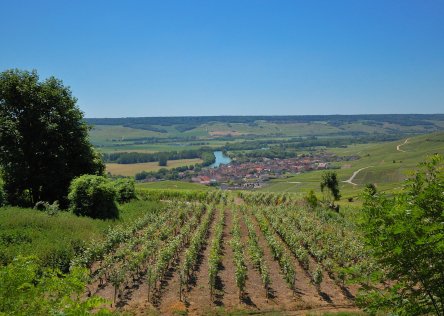
Flickr , CC-BY SA 2.0
Best Time to Visit Champagne, France
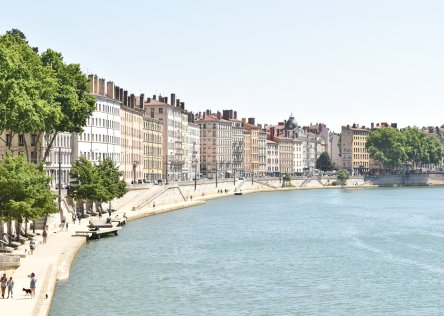
Best Time to Visit Lyon
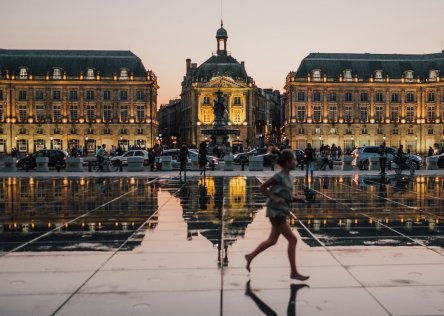
Guillaume Flandre, Unsplash
Best Time to Visit Bordeaux
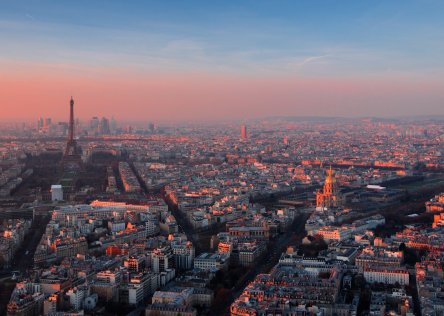
Luca Micheli, Unsplash CC0
Best Time to Visit Paris
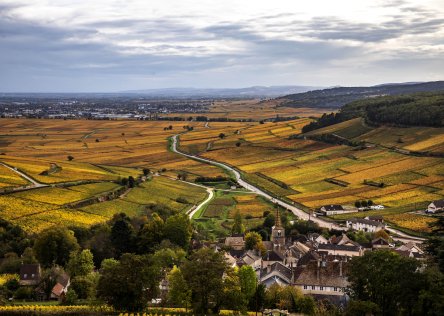
Eve & Sebastien, Chemins de Bourgogne
Best Time to Visit Burgundy
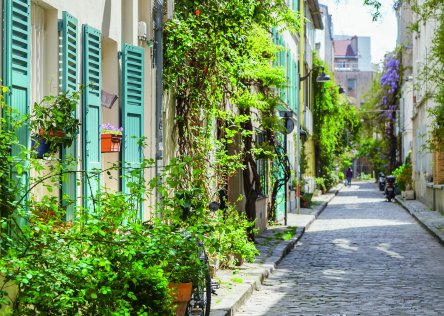
Paris secret places Marc Bertrand - Paris TO
6 alternative places to visit in Paris
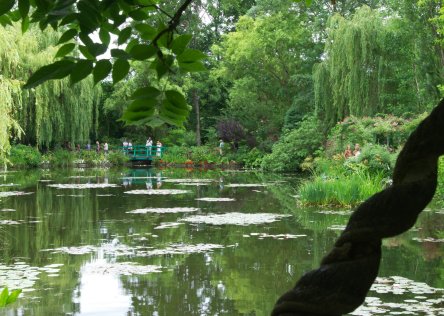
Unsplash CC0
Best Time to Visit Normandy

Léonard Cotte , Unsplash
Best Time to Visit Provence
Hi there 👋 My name is Laura. Would you like to subscribe to our monthly newsletter... 100% about France!


Every weekend is an adventure
The best things to do in brittany: activities for nature, culture & food lovers.
- Post published: 18 January 2022
- Post category: Brittany / Europe / France
My family comes from Brittany so, obviously, I think it’s the prettiest region in France. With many coastal areas and stunning hinterland, you will find many activities in Brittany to please anyone. I didn’t want to write a list of places to visit in Brittany, I have already done that in my Best of Brittany article . In this article, I focused on activities and listed the best things to do in Brittany, wherever you are.
The best things to do in Brittany for nature lovers
Explore the coastal walks.

Brittany is a peninsula in the west of France so the coast is never too far away! The variety of landscapes is impressive. You’ll find beautiful pink granite rocks in the north, a wild untouched coast in the west, rocky landscapes, white sand or pebble beaches and even a gulf with more than 1,000 islands in the south. Plus, the views continuously change with the tides! The GR 34 hiking path goes all around the region and mostly follows the coast, so you can find many coastal walks everywhere in Brittany.
Visit an island

Brittany has some of the most beautiful islands you’ll find in France (for the European part of France). Many of them are easy to visit in just a day trip: Brehat island in the north, Ile d’Arz or Ile aux Moines in the south for example. You can also organise a day trip to Belle Ile en Mer , the most beautiful island in Brittany my opinion, but it’s better to stay there for a few days if you have time.
Visit lighthouses

One-third of French lighthouses are in Brittany. You’ll find lighthouses a bit everywhere along the coast of Brittany, but most of them are in the western part of the region. They have very different styles and are often located at beautiful viewpoints. Some of them can be visited and climbing a lighthouse is a perfect way to see the coast from a bird’s point of view. Cap Frehel, Saint-Mathieu and Trezien are the easiest ones to visit as they are on the continent.
Explore mysterious forests

A walk in a forest in Brittany is often more than just a peaceful moment surrounded by trees. You are visiting a land of legends, and many of them were born in the forest. Huelgoat Forest and Broceliande Forest are full of mysteries and some of the best spots in Brittany to learn more about Celtic legends.

There are a few places in Brittany where you can hire a kayak, even if you’re a beginner. But keep in mind the tides and the currents that come with them are strong in Brittany, so always seek local advice.
With more than 60 kilometres of rivers and canals, the Morbihan region is perfect for kayaking. It is popular to kayak on the Nantes-Brest Canal (Créhaher, Malestroit).
In the north of Brittany, you can kayak the Rance river from Dinan .
Are you thinking of buying an inflatable kayak? We love how we can now explore more places easily since we got one. Check out my tips on how to choose an inflatable kayak and the most important questions to answer first.
Go to the beach

You will find beaches everywhere in Brittany. But they are not all the same at all! Some will have big waves while others will be protected in a bay or in a gulf. Some have pebbles while others have white sand. Some are long while others are tiny. It’s hard to say which one is the best as it really depends on what you’ll looking for. If you’re thinking of swimming, the water in the south will be warmer.
If you don’t think about Brittany when you talk about surfing spots in France, then you may be surprised to find out it’s ranked the second region in France for the number of surfers. There are dozens of spots that are good for beginners and/or confirmed surfers. La Torche is one of the most famous surf spots in Brittany thanks to the 2024 Olympic Games. Plouharnel and Quiberon are also very famous, with one side of the peninsula great for beginners and the other – the wild side – perfect for experienced surfers.
You’ll also find a surf school in Saint-Briac, on the northern coast of Brittany, in Locquirec in the west, in Crozon in the south and on Belle Ile Island, also in the south. We also regularly spot surfers all year round at Guidel in the south of the region and La baie des Trépassés near La Pointe du Raz in the west.
Join a cruise tour or go sailing

Exploring Brittany on a boat is always a good idea. Tours are organised to make it easy for tourists to find a cruise for the day. A boat tour on the Morbihan Gulf is a must-do when visiting Brittany. You can also cruise down rivers such as La Rance, L’Odet (reputed to be one of the most beautiful rivers in France!) or the Nantes-Brest Canal.
Brittany is a land of sailing. Most French sailors are from Brittany or are somehow connected to Brittany. There are lovely places easy to explore for beginners and you can join a sailing course if you’d like to learn sailing. The sailing school Les Glénans is one of the most famous in the world. There are also a few lakes to learn safely or have fun on the water while inland, such as Lac au Duc near Ploermel. We hired a big sailing boat from Saint Goustan and loved it.
Go windsurfing or kitesufing

Brittany is one of the windiest regions in Europe, so it’s not surprising to see windsurfers and kitesurfers on the beach. However, rocks are often hidden in the water so it’s important to choose the right spot. Brittany has hosted many windsurfing competitions at the world level, mostly at La Torche and Le Dossen. There are kitesurfing and windsurfing schools all around the coast.
Explore Brittany by bike
I went on cycling holidays in Brittany once and let me tell you that if you plan to follow the coast, it’s not flat and easy! However, you’ll find great cycling circuits in the hinterland. For those looking for cycling holidays, the most famous cycling track in Brittany is the Nantes-Brest Canal . There is also a cycling path from Rennes to Saint-Malo. Those looking for shorter cycling circuits can also have a look at the Broceliande Forest (Paimpont).
The best things to do in Brittany for food lovers
Eat seafood.

I don’t know a better place than Brittany to enjoy seafood. They serve the biggest seafood platter you can imagine with a great variety of shells, crabs or prawns (just to name a few). Although they’re from the north of France, moules-frites are very popular and sold in many restaurants in Brittany.
Eat galettes

Galettes bretonnes, sometimes called crepes , are the most famous dish from Brittany. It’s made with buckwheat flour and can be filled with savoury or sweet ingredients. Your imagination is the limit, but the traditional galettes fillings are ham, egg and cheese.
Try the local sausage: andouille

It’s a real experience to eat some andouille, and even a more surprising one to enter a shop full of it. The sausage is very popular in Brittany and is often served in galettes. The best place to try it is in Guéméné.
Sweet cakes and biscuits from Brittany
You may have tried the famous cake from Brittany, the Kouig Amann. I was surprised to find it in a few French bakeries in Brisbane. I personally prefer the Far Breton – but you have to like prunes for this one!
Brittany is also famous for having delicious biscuits: l es palets bretons and les galettes bretonnes (that are different from the crepes). You can find many biscuit shops ( Biscuiteries ) in Brittany. La Trinitaine * and Saint Michel * are probably the two most famous ones.
If you’re interested in baking, you can join a traditional Breton cakes baking an d tasting class (in English) *.
Local drinks

Brittany is very famous for its cider; locals would drink it with their meals. Before dinner or lunch, at the apéritif , you may want to try the local mead made from honey: le chouchen . Le chouchen was known as the drink of the Celtic gods, and beer was the drink of the warriors. You can also find local beers in Brittany, and some are quite original (made with sea salt or algae for example).
The best things to do in Brittany for heritage and culture lovers
Visit megalithic sites.

There are impressive megalithic sites all around Brittany, but you often have to take a detour to see them. From big isolated standing stones to alignments, they’re always quite mysterious. They have been there for 3,000 years. The most famous site is Carnac with 2,733 menhirs (the Breton word for long stone) aligned for more than 4 kilometres.
Visit Brittany’s beautiful towns and villages

There are many beautiful towns and pretty villages in Brittany . You will often feel like you went back in time as you walk around the cobbled streets with all the lovely stoned houses around.
Visit cathedrals and chapels

Brittany is a land of faith and saint worship. You’ll find many religious monuments all around the region: basilicas, abbeys, chapels, churchyards… Some of the most famous and remarkable ones are Saint-Anne d’Auray sanctuary (the most important Catholic pilgrimage site in Brittany) and Quimper Cathedral. If you’re impressed by older buildings, you may like Landévennec abbey ruins from the 5th century. In a totally different style, the sculptures of the Vallée des Saints in the heart of Brittany are worth a detour – but they’re more pieces of art than religious.
Attend a festival or fest-noz
If you’re interested in learning more about Breton music and dances, the Festival Interceltique of Lorient in August is a big celebration of all Celtic cultures for 10 days and 10 nights, with concerts and shows that take over the streets. More focused on Brittany, the Cournouaille festival in Quimper is another excellent opportunity to attend concerts from local artists and celebrate the Breton culture. Les Fêtes Historiques in Vannes in July are recommended too.
A fest-noz is a festival where people gather to listen to live music and dance traditional dances. It is on the UNESCO List of the Intangible Cultural Heritage of Humanity.
What are the best things to do in Brittany in your opinion? Share your experience in the comments below!
When is the best time to visit brittany.
Brittany has an interesting oceanic climate. It never really gets hot or cold, and the weather can change quickly according to the tide. Although the region isn’t big, the weather is very different in the north and west compared to the south, especially in the Gulf of Morbihan which is known to have its own enjoyable microclimate.
Brittany is popular in summer. It never gets too hot in the region even when the country is hit by a heatwave, so it’s a reputed spot for families going on holidays with young kids or seniors.
June and September are ideal to avoid the crowd and still get a chance at having the best weather.
You can visit Brittany the rest of the year, but you will have a higher risk of rain (especially from November to February).
Where is Brittany?
Brittany is the most western region of France . It takes about five hours to get there driving from Paris and it is also easy to reach by train. The biggest cities are Rennes and Nantes (although Nantes is no longer in the official region).
- Click to share on Facebook (Opens in new window)
- Click to share on Pinterest (Opens in new window)
- Click to share on WhatsApp (Opens in new window)
- Click to email a link to a friend (Opens in new window)
- Click to share on Twitter (Opens in new window)
Check out more things to do:
This Post Has 8 Comments
Wow, what an amazing part of France! I would love to explore the small towns, check out the heritage sites, and get lost in those pretty forests! I’ve spent a lot of time in the east and south of France and would love to get out and visit the Brittany area!
Brittany looks like a beautiful area of France to visit. It’s been on my list for a long time but I haven’t manage to plan a trip here. Your post has made me want to look into it more now!
Oh my goodness that food looks INCREDIBLE. That would make it worth the trip alone!
I would be in heaven visiting Brittany. I would eat the buckwheat crepes every day with a glass of cider. And I would sit on the beach and write. What a magical region. Your photo collages are extraordinary.
I just visited Brittany briefly a few years ago visiting Rennes, St.Malo, and Dinan. Reading your article I understand that there is so much more to see in this part of France. Thanks for sharing!
The scenery looks beautiful, but I want the seafood and galettes! Yum!
Wow I didn’t realise there were so many different things to do in Brittany, the villages look so pretty!
The roughed scenery and ancient history of Brittany really appeals to me, not to mention that gorgeous coast. I think you’re right to claim it as the prettiest part of France!
Leave a Reply Cancel reply
Save my name, email, and website in this browser for the next time I comment.

- Destinations
- The 10 destinations
Southern Brittany – Morbihan Gulf
Enjoy the gentle pace of life on the Gulf’s islands, discover megalithic secrets and half-timbered houses, experience the thrills of ocean racing, picnic at the isle of Groix on the deck of a traditional sailboat, and take a stroll along the banks of the Blavet and Scorff rivers. Southern Brittany-Gulf of Morbihan offers experiences you’ll never forget!
Unmissable places
Plan your holiday.
Unusual, known, remarkable: if you had to choose just a handful of amazing places to pierce the soul of the region, well of course these would be the ones! Head this way for a quick look at the amazing places you simply have to see.
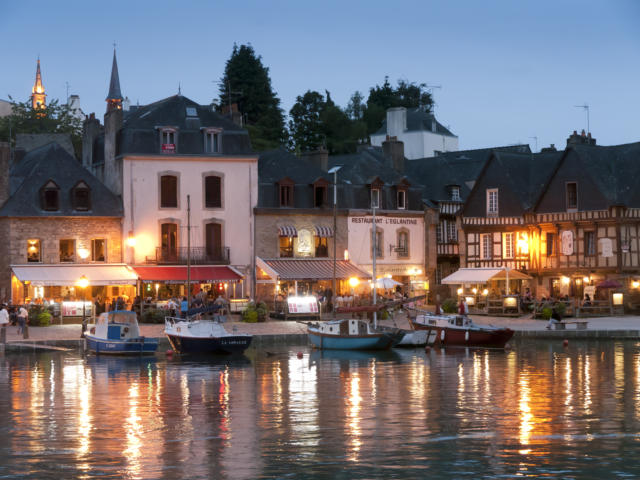
Find inspiration for an outing, a perfect night, find out which places to visit, local events, etc. It’s all here!
- Accommodation
- Bed & Breakfast
- Unusual places to stay
- Holiday residences
- Holiday villages
- Youth hostels
- All accommodation
- All the activities
- All the events
You might also like...
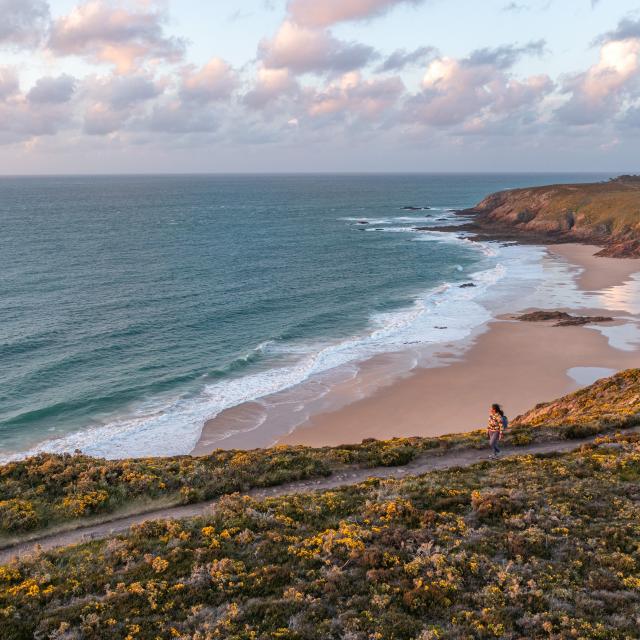
- Make life simpler: add your favourite pages as bookmarks.
- Trade professionals


COMMENTS
9. Kayak through a secluded lagoon. It is not hard to see why Les Glénan archipelago is often compared to Tahiti. Made of seven islands and a dozen smaller islets, Les Glénan offers an exceptional - and largely uninhabited - spectacle of sandy beaches and translucent water.
6. Rochefort-en-Terre. Not all ' plus beaux villes' are created equal. We were slightly disappointed by the nearby PBV village of La Gacilly when we were out one day, in search of all the best places to visit in Brittany, but finishing off the second half of our day in Rochefort-en-Terre was the enhancement we needed.
Endless sightseeing opportunities and authentic local experiences await travelers to this captivating region. Discover the best places to visit and things to do with our list of the top attractions in Brittany. On This Page: Saint-Malo. Quimper. Nantes. Rennes. Belle-Île-en-Mer. Morbihan Megalithic Sites.
This Brittany travel guide takes you to the 20 most beautiful towns and villages in Brittany. Brittany is just filled with secret medieval towns. If you want to get off the beaten path and explore some hidden gems in France, Brittany makes the perfect escape. These Brittany towns are among the best places to go and visit in France.
5. Old Centre of Dinan. Source: Boris Stroujko / shutterstock. Old Centre of Dinan. Even in a region lauded for its picturesque towns, Dinan stands out. Most people have it down as the prettiest in Brittany, and the upper part, within the walls, has cobblestone streets with houses dating as far back as the 1200s.
Port De St Goustan. One of the best free things to do in Brittany at night is visit the Port de Saint-Goustan on the Auray River. Saint-Goustan is a former fishing port and trading centre. To explore the charming port, guests can stroll along the shady terrace and cross the four-arched stone bridge with splendid views.
Places to visit in Brittany. THE 30 BEST Things to Do in Brittany, France. Places to Visit in Brittany. Check out must-see sights and activities: Les Remparts de Saint-Malo, Sentier des Douaniers, Churches & Cathedrals, Points of Interest & Landmarks.
Plage des Bas Sablons. St-Malo. This long and pleasant beach by the marina in St-Servan has a dike that prevents the water from receding entirely at low tide. 1. 2. Discover the best attractions in Brittany including Rue du Jerzual & rue du Petit Fort, Musée des Beaux-Arts, and Château de St-Malo.
There are ten unique geographical destinations here: ten worlds to explore that reveal Brittany's many faces. Discover the 'Terres Océanes' at the western tip, the Forest of Broceliande, the green inner lung, the little ports of Cornouaille (Brittany's Cornwall), and the pink granite rocks. From its bays, gulfs, capes and salt marshes ...
The region of Brittany is divided into four departments: Côtes-d'Armor (22), Finistère (29), Ille-et-Vilaine (35), and Morbihan (56). The capital of Brittany is Rennes.. Are you planning a trip to Brittany, France? Our list of best things to do in Brittany is far from exhaustive, but it has the essential places to visit in Brittany and the main Brittany tourist attractions.
For a taste of the region's best crepes, go to Creperie Ouzh-Taol. 3. Explore Nantes. During the Middle Ages, Nantes, located at the junction of the Erdre and Loire Rivers, was the capital of the Duchy of Brittany. Today, Nantes is France's sixth largest city and a thriving hub of higher education.
Things to do / see. There's something for everyone in Brittany, with its countryside, coastline and heritage. You'll never make the same trip twice; there's so much to see and do. Beaches and footpaths, châteaux and forts, zoos, aquariums and museums. Coves for canoeing and paddle-boarding, canals where you can walk along the towpath ...
Lorient, a cosmopolitan and culturally diverse city. 10. Quiberon. A slender peninsula jutting into the Atlantic, Quiberon is a haven for beach lovers and adventure seekers. With its sandy shores and rugged cliffs, it's no wonder this locale ranks among the most beautiful places to visit in Brittany.
The rose garden has an added attraction - reading the names of each type of rose is a journey in time jumping from no... 2024. 7. Ploumanac'h Natural Site. 2,170. Historic Walking Areas. By RVJ10. A lucky find when planning our motorcycle route round Brittany. 2024.
One of our favourite towns in Brittany, Dinard is well known for its belle-epoque villas. Dinard. The Morbihan Gulf is well placed for exploring the islands off the southern coast of Brittany. Morbihan Gulf. An extensive historical centre and lively atmosphere make Vannes an unmissable highlight of your visit. Vannes.
16. Fougeres. Fougères, a charming town 50 km northeast of Rennes, offers a perfect example of Brittany's rich medieval heritage. Presiding over the town is the Château de Fougères, a fairy-tale castle built between the 12th and 15th centuries that transports visitors back to the feudal era.
16. Cancale: an ideal destination for eating oysters in Brittany. Eat oysters in Brittany. Cancale is a small village popular for its oyster farms, thus offering numerous restaurants and stalls to enjoy oysters. If you want to taste them or even try them for the first time, Cancale is the perfect place to do so.
Brittany in western France has so much to offer visitors who want to explore thousands of years of history, see stunning coastal landscapes, and discover beautiful little islands. Whether you want to relax on a golden sandy beach, visit ancient ruins and medieval villages, or go cycling alongside the sea, we will help you experience the best of ...
The best things to do in Brittany for food lovers. Eat seafood. Eat galettes. Try the local sausage: andouille. Sweet cakes and biscuits from Brittany. Local drinks. The best things to do in Brittany for heritage and culture lovers. Visit megalithic sites. Visit Brittany's beautiful towns and villages.
The best of Brittany. Brittany is all about getting away from it all, whether you're walking or enjoying good food, following your dreams or just exploring. Along the footpaths, on the beach or in the cobbled streets, take a deep breath of sea air and let yourself go: this is Brittany! Go for a walk without ever losing sight of the sea.
Features include a mini sub ride and colourful aquatic species, set amidst a lively atmosphere. 4. Oceanopolis. 3,812. Aquariums. Oceanarium featuring a diverse array of marine life across polar, tropical, and local sea habitats, complete with educational exhibits and picnic-friendly outdoor spaces. 2024. 5.
2. Cultural riches . Brittany and Normandy both have a folklore rich in traditions and legends, often linked to their Celtic and medieval roots. In Brittany, fest-noz are traditional festivals with Celtic dancing and music - one of the biggest and best known is the Lorient Interceltic Festival, which attracts thousands of visitors every year. The region is also steeped in legends, especially ...
Southern Brittany - Morbihan Gulf. Enjoy the gentle pace of life on the Gulf's islands, discover megalithic secrets and half-timbered houses, experience the thrills of ocean racing, picnic at the isle of Groix on the deck of a traditional sailboat, and take a stroll along the banks of the Blavet and Scorff rivers.
The rose garden has an added attraction - reading the names of each type of rose is a journey in time jumping from no... 2024. 7. Ploumanac'h Natural Site. 2,170. Historic Walking Areas. By RVJ10. A lucky find when planning our motorcycle route round Brittany. 2024.